Category
Scientific Photography
8 entries in this category | view all categories
New Year Hope
Posted January 2024 in Alternate Processes, New Additions, Scientific Photography, Unknown Photographers
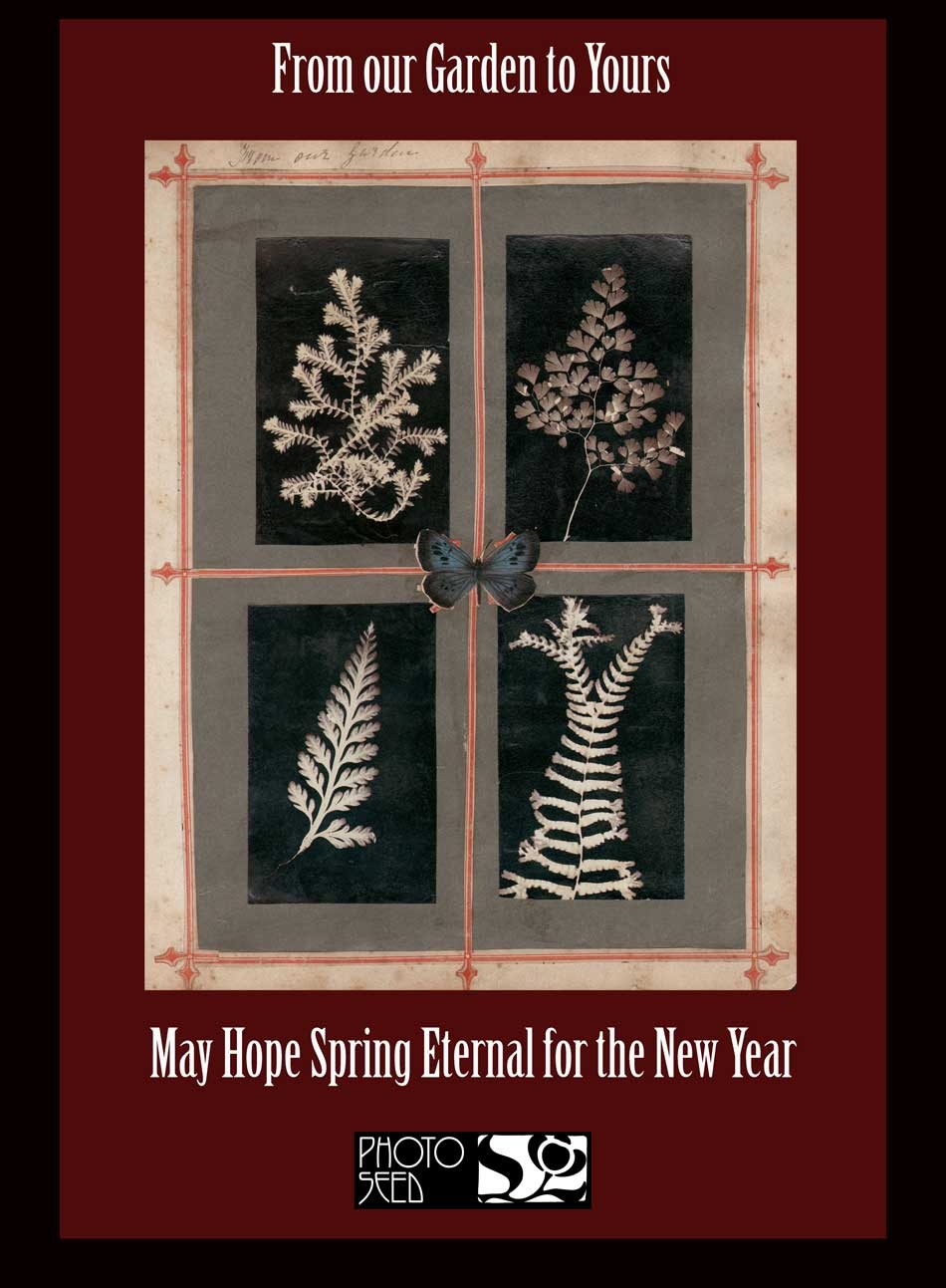 “Scrapbook album page of 4 plant photograms”: Unknown British photographer, c. 1871-1872. Grouping of Albumen silver prints pasted to secondary mount with hand-applied, printed red-ruled borders & pasted paper butterfly. Overall page: 27.4 x 23.5 cm; prints: +/- 9.5 x 6.0 cm. Clockwise from top left: Selaginella- unknown “spike moss”, Maidenhair fern, unknown fern x 2. This unusual grouping was a gift dated April 9, 1872 to Arthur Francis Elliot Norton (1854–1922) of New South Wales, Australia. (“This for my dear Grandson & Godson” Provenance: NSW collection. From: PhotoSeed Archive
“Scrapbook album page of 4 plant photograms”: Unknown British photographer, c. 1871-1872. Grouping of Albumen silver prints pasted to secondary mount with hand-applied, printed red-ruled borders & pasted paper butterfly. Overall page: 27.4 x 23.5 cm; prints: +/- 9.5 x 6.0 cm. Clockwise from top left: Selaginella- unknown “spike moss”, Maidenhair fern, unknown fern x 2. This unusual grouping was a gift dated April 9, 1872 to Arthur Francis Elliot Norton (1854–1922) of New South Wales, Australia. (“This for my dear Grandson & Godson” Provenance: NSW collection. From: PhotoSeed ArchiveHenry Ravell: Embracing Art & Photography
Posted August 2020 in Alternate Processes, Cameras, Color Photography, Documentary Photography, Framing, History of Photography, New Additions, Painters|Photographers, Photography, Scientific Photography, Significant Photographers
“Coburnesque”, or, in the style of American master pictorialist Alvin Langdon Coburn, (1882-1966) was how the work of now forgotten American photographer Henry Ravell (1864-1930) was described in 1908 by London’s Amateur Photographer & Photographic News.
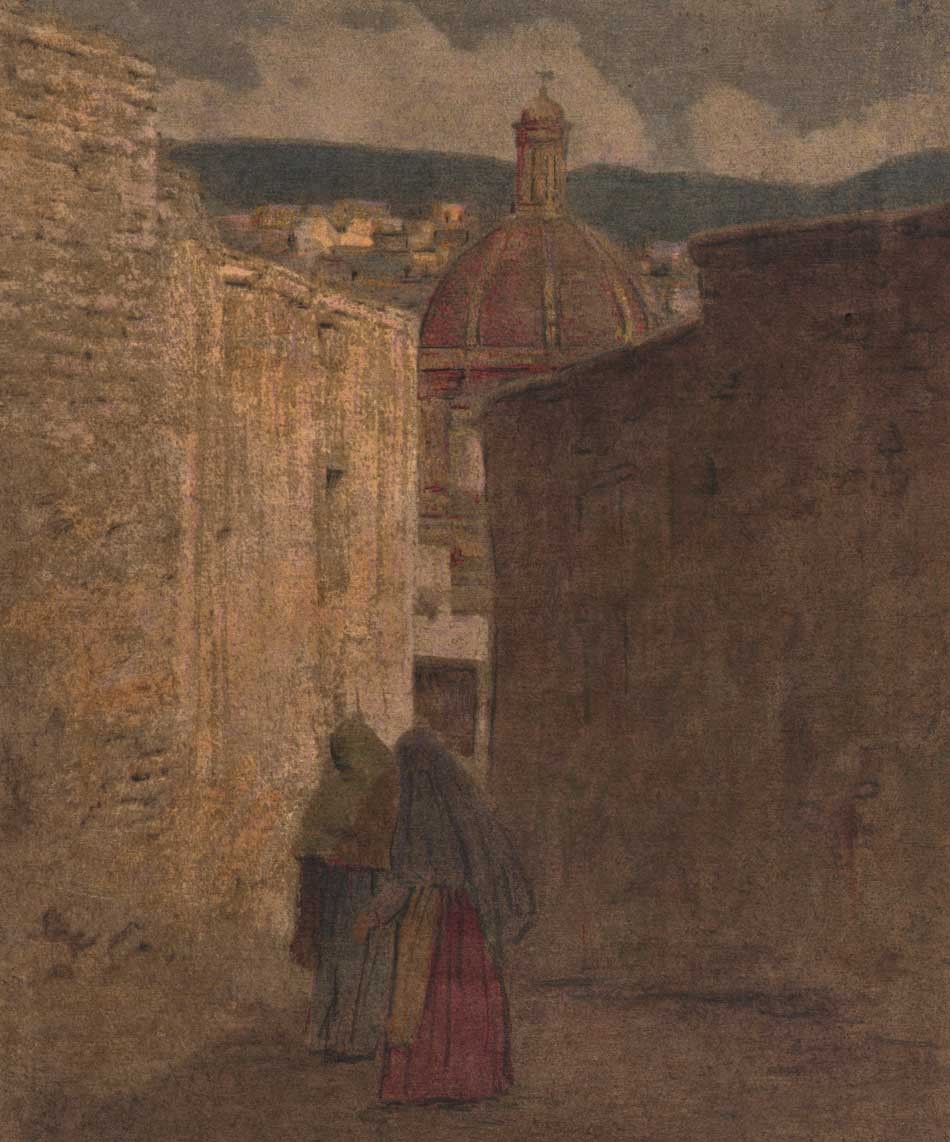 Detail: “A Narrow Street-Guanajuato”: Henry Ravell, American: 1864-1930. Vintage multiple color gum print c. 1907-14. Image: 33.1 x 23.5 presented loose within brown paper folder with overall support dimensions of 39.8 x 58.8 cm. In central Mexico, with the dome of a church framing the skyline at center in background, two native women make their way along one of Guanajuato’s narrow streets. Henry Ravell perfected the gum bichromate process to a very high level. Probably in 1906-07, he began experimenting in multiple color gum. In Germany, around this same time, similar examples were being done by the brothers Theodor (1868-1943) and Oscar Hofmeister, (1871-1937) as well as Heinrich Wilhelm Müller. (1859-1933) From: PhotoSeed Archive
Detail: “A Narrow Street-Guanajuato”: Henry Ravell, American: 1864-1930. Vintage multiple color gum print c. 1907-14. Image: 33.1 x 23.5 presented loose within brown paper folder with overall support dimensions of 39.8 x 58.8 cm. In central Mexico, with the dome of a church framing the skyline at center in background, two native women make their way along one of Guanajuato’s narrow streets. Henry Ravell perfected the gum bichromate process to a very high level. Probably in 1906-07, he began experimenting in multiple color gum. In Germany, around this same time, similar examples were being done by the brothers Theodor (1868-1943) and Oscar Hofmeister, (1871-1937) as well as Heinrich Wilhelm Müller. (1859-1933) From: PhotoSeed Archive
Under the headline “Local Colour.” by journal critic “The Magpie”, a discussion of the merits around Ravell’s new color multiple gum printing process was considered for their large readership. Commenting on a series of his Mexican church photographs published in the May issue of the Century Magazine, “Magpie” writes:
“Who is this Mr. Ravell, and what is his wonderful colour process, which is not “on the negative”? Multiple-gum, one may surmise- and one may also venture to guess that Mr. “de Forest” (Lockwood de Forest- editor) has, notwithstanding this flourish of trumpets, nothing very much to tell us. The Ravell photographs, illustrating “Some Mexican Churches,” are Coburnesque, and the pictures are, in their very Yankee style, fine and strong- which is more than can be said for those in our English monthlies. Couldn’t Mr. Ravell be induced to send some examples of his work to the R.P.S. or Salon? We badly need some new American exhibitors.” (June 16, p. 600)
A reassessment of Ravell’s output is long overdue in elevating him back to his rightful position as one of the more important practitioners of pictorialism in the early 20th Century canon of American artistic photographers.
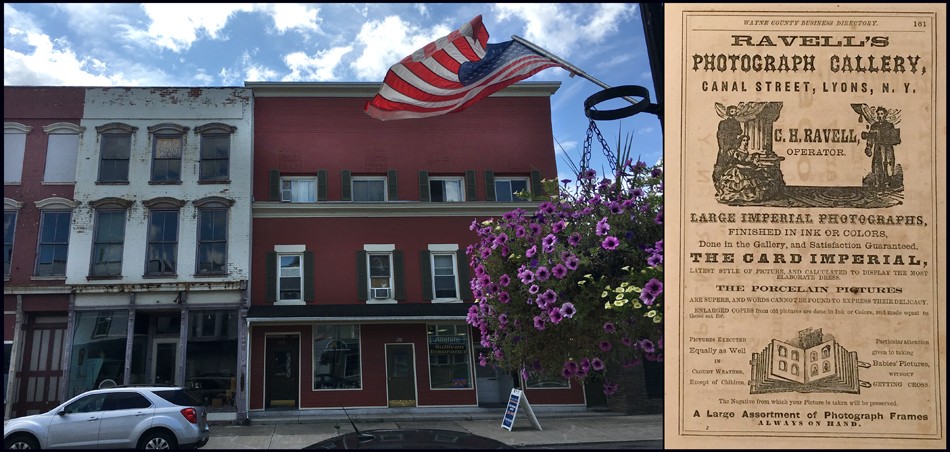 Left: Henry Ravell was only a toddler when his father Charles Henry Ravell (1833-1917) opened a skylight photographic studio on the third floor of this brick building painted red located on Canal Street in Lyons, New York around 1865-66. Shown here in the summer of 2019, the entrance was at the present day 36 Canal street (on the far right of the photo-presently an insurance office) but was numbered #30 Canal before the turn of the 20th Century. It was here that Henry was “brought up in photography from childhood and became an expert in all processes before he was twelve years old”. Right: A full-page advertisement for “Ravell’s Photograph Gallery” operated by C.H. Ravell at the Canal street building appeared in the 1867-68 Wayne County (New York) Business Directory. At the time, Charles Ravell would have been using the wet-plate process, and the ad highlights “Large Imperial Photographs finished in Ink or Colors”… “Pictures Executed Equally as Well in Cloudy Weather Except of Children”… “Particular attention given to taking Babies’ Pictures, without Getting Cross”. Left: David Spencer for PhotoSeed Archive; Right: courtesy Museum of Wayne County History.
Left: Henry Ravell was only a toddler when his father Charles Henry Ravell (1833-1917) opened a skylight photographic studio on the third floor of this brick building painted red located on Canal Street in Lyons, New York around 1865-66. Shown here in the summer of 2019, the entrance was at the present day 36 Canal street (on the far right of the photo-presently an insurance office) but was numbered #30 Canal before the turn of the 20th Century. It was here that Henry was “brought up in photography from childhood and became an expert in all processes before he was twelve years old”. Right: A full-page advertisement for “Ravell’s Photograph Gallery” operated by C.H. Ravell at the Canal street building appeared in the 1867-68 Wayne County (New York) Business Directory. At the time, Charles Ravell would have been using the wet-plate process, and the ad highlights “Large Imperial Photographs finished in Ink or Colors”… “Pictures Executed Equally as Well in Cloudy Weather Except of Children”… “Particular attention given to taking Babies’ Pictures, without Getting Cross”. Left: David Spencer for PhotoSeed Archive; Right: courtesy Museum of Wayne County History.
Undoubtedly, “Magpie” would have been pleased to know Henry Ravell sprung from fine English photographic stock. His father Charles Henry Ravell (1833-1917) emigrated to the U.S. from Boston, England and was known to have been active as a Daguerreotypist as early as 1857, (1.) his trade shingle set up early in the New York state village of Chittenango. By 1860, U.S. Census records show he had moved to Wolcott, New York, where he was a commercial photographer. Surviving cdv photographs from here bearing his C.H. Ravell back-stamp reveal some of his clients were young men heading off to fight in the American Civil War.
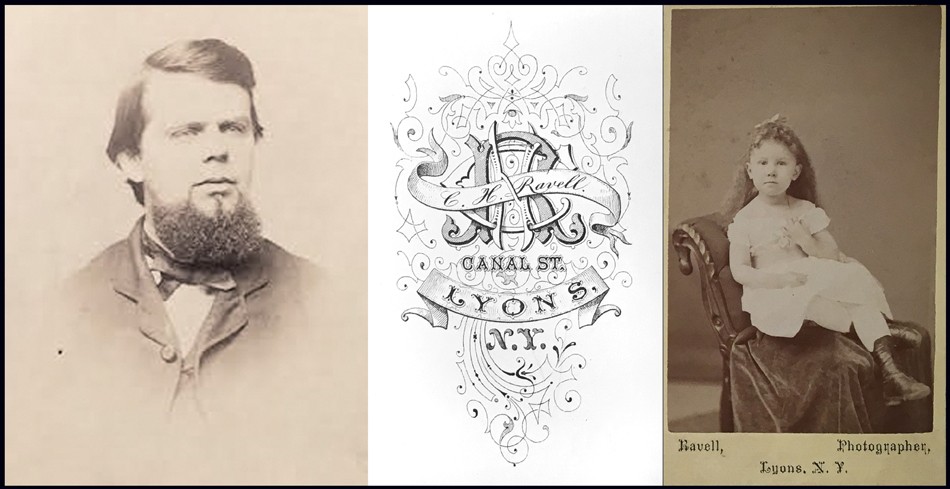 Left: This is the only known portrait of commercial portrait photographer Charles Henry Ravell, father of Henry Ravell. The carte de visite albumen portrait shows him most likely in his early 30’s, after he had settled in Lyons, New York. Born Charles Herring Ravel in Boston, England, he emigrated to the U.S. as a young man, with an early notice of his Daguerreotypist skills from 1857 showing he was living in Chittenango, New York State. By 1860, he had settled in Wolcott, where son Henry was born in early 1864. By 1867 or earlier, he and wife Cornelia Dudley Ravell (1840-1908) and Henry had moved permanently to nearby Lyons. Middle & Right: This elaborate backstamp engraving for C.H. Ravell’s Canal Street skylight studio in Lyons is ca. 1865-80, with the albumen portrait subject (Right) a young girl posing on a commercially available chair. Both: courtesy Museum of Wayne County History
Left: This is the only known portrait of commercial portrait photographer Charles Henry Ravell, father of Henry Ravell. The carte de visite albumen portrait shows him most likely in his early 30’s, after he had settled in Lyons, New York. Born Charles Herring Ravel in Boston, England, he emigrated to the U.S. as a young man, with an early notice of his Daguerreotypist skills from 1857 showing he was living in Chittenango, New York State. By 1860, he had settled in Wolcott, where son Henry was born in early 1864. By 1867 or earlier, he and wife Cornelia Dudley Ravell (1840-1908) and Henry had moved permanently to nearby Lyons. Middle & Right: This elaborate backstamp engraving for C.H. Ravell’s Canal Street skylight studio in Lyons is ca. 1865-80, with the albumen portrait subject (Right) a young girl posing on a commercially available chair. Both: courtesy Museum of Wayne County History
Born in early January of 1864 in Wolcott, Henry Ravell is known to have embraced photography from a very young age. As a boy, he became his father’s apprentice. Lockwood de Forest, (1850-1932) an important influence on Henry for the rest of his life in the 20th Century and important American painter and furniture designer, wrote in 1908 that Henry:
“was born and brought up in photography from childhood and became an expert in all processes before he was twelve years old.” Through a fascinating confluence of sons starting out in their father’s professions, Henry Ravell graduated to having an interest in art, and he studied water-color painting with the noted American artist and Tonalist Henry Ward Ranger, (1858-1916) probably in his late teens or early 20’s. The artist and student had much in common. Like Charles Henry Ravell, who had established his own Canal Street photo studio in Lyons, N.Y. by 1867, (Wayne County Business Directory) Ranger’s father Ward Valencourt Ranger (1835–1905) had opened his own commercial studio in 1868 in Syracuse, N.Y., 55 miles east of Lyons, almost at the same time. Like Henry Ravell working for his father at an early age, Henry Ranger was also known to have worked in his father’s establishment as a young man.
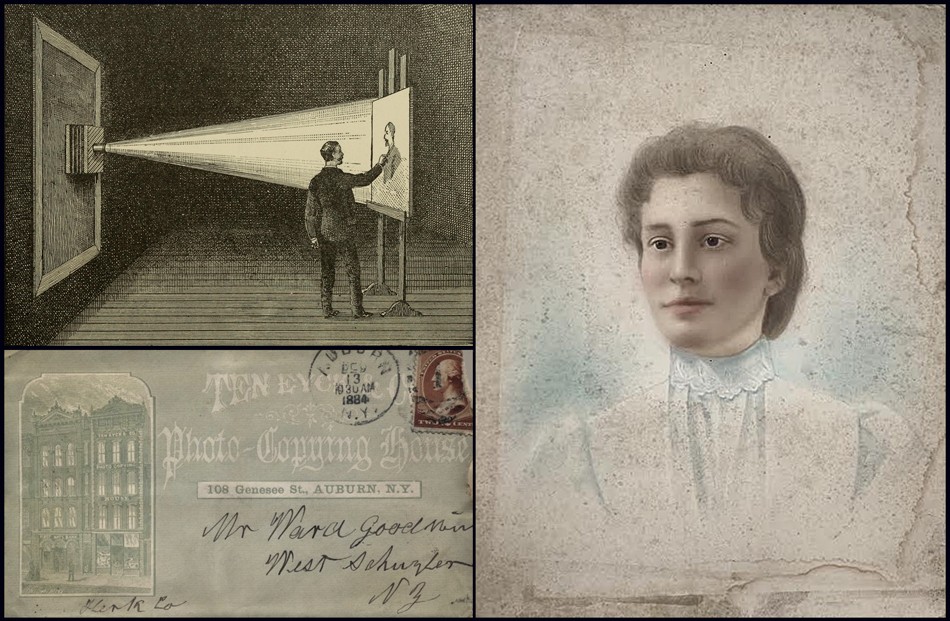 Upper Left: “Negative Outline-Dark Chamber”: woodcut from 1892 volume “Crayon Portraiture: Complete Instructions for making Crayon Portraits on Crayon Paper and on Platinum, Silver, and Bromide Enlargements” by J.A. Barhydt. In the early 1880’s, Henry Ravell worked in a similar capacity as the artist shown here for the Photo-Copying House Ten Eyck & Co. of Auburn, New York. Woodcut shows an enlarged and enhanced crayon portrait being made freehand on the easel at right. A photographic negative from a sitter has been placed inside a large box camera at left while mounted in front of a scrimmed-off window. This provides the light source for the projection within a darkened room while the artist goes over the outline and shadow lines of the projection in a first step. Other variations of crayon portraits began with an artist working in a lighted studio with charcoal and pastels after the initial projected outline on crayon, gelatin, bromide, etc. papers had been chemically fixed. Ten Eyck advertised on cover stationary from 1884: “Fine Portraits in India Ink, Water Colors and Crayon, By the Association of Celebrated Portrait Artists…” (From: Internet Archive) Lower Left: December, 1884 postmarked cover (envelope) from Ten Eyck & Co. Portraits located at 108 Genesee St., Auburn, N.Y. (8.5 x 15.0 cm-right margin perished) Ravell worked at the firm about this time, making a living combining his skill of photography and art. In the late 1880’s to early 1890’s, he became an agent for Ten Eyck after moving to Mexico. From: PhotoSeed Archive. Right: “Crayon-style Portrait” ca. 1890-5: (50.9 x 40.5 cm) enhanced water-color or India inks applied by hand to unknown (bromide?) photographic emulsion fixed onto light grade cardboard matrix. Henry Ravell produced similar crayon-style portraits for Ten Eyck, with this example from an unknown artist featuring Mary Carruthers Tucker (1877-1940) as subject, then living in Provo-City Utah. She was the spouse of C.R. Tucker, whose work is featured at PhotoSeed. From: PhotoSeed Archive
Upper Left: “Negative Outline-Dark Chamber”: woodcut from 1892 volume “Crayon Portraiture: Complete Instructions for making Crayon Portraits on Crayon Paper and on Platinum, Silver, and Bromide Enlargements” by J.A. Barhydt. In the early 1880’s, Henry Ravell worked in a similar capacity as the artist shown here for the Photo-Copying House Ten Eyck & Co. of Auburn, New York. Woodcut shows an enlarged and enhanced crayon portrait being made freehand on the easel at right. A photographic negative from a sitter has been placed inside a large box camera at left while mounted in front of a scrimmed-off window. This provides the light source for the projection within a darkened room while the artist goes over the outline and shadow lines of the projection in a first step. Other variations of crayon portraits began with an artist working in a lighted studio with charcoal and pastels after the initial projected outline on crayon, gelatin, bromide, etc. papers had been chemically fixed. Ten Eyck advertised on cover stationary from 1884: “Fine Portraits in India Ink, Water Colors and Crayon, By the Association of Celebrated Portrait Artists…” (From: Internet Archive) Lower Left: December, 1884 postmarked cover (envelope) from Ten Eyck & Co. Portraits located at 108 Genesee St., Auburn, N.Y. (8.5 x 15.0 cm-right margin perished) Ravell worked at the firm about this time, making a living combining his skill of photography and art. In the late 1880’s to early 1890’s, he became an agent for Ten Eyck after moving to Mexico. From: PhotoSeed Archive. Right: “Crayon-style Portrait” ca. 1890-5: (50.9 x 40.5 cm) enhanced water-color or India inks applied by hand to unknown (bromide?) photographic emulsion fixed onto light grade cardboard matrix. Henry Ravell produced similar crayon-style portraits for Ten Eyck, with this example from an unknown artist featuring Mary Carruthers Tucker (1877-1940) as subject, then living in Provo-City Utah. She was the spouse of C.R. Tucker, whose work is featured at PhotoSeed. From: PhotoSeed Archive
Sometime in the early 1880’s after Henry had finished this “apprenticeship”, he moved to nearby Auburn, New York, about halfway to Syracuse from Lyons, to a job crafting Crayon and Pastel portrait photographic enlargements for Ten Eyck & Co. At the time, this firm is said to have been the largest of its’ type in the world. This gave Henry additional artistic skills, combining his interest in photography and art, an important and influential confluence indeed. He kept at this profession until either 1883, according to Lockwood de Forest, or as late as 1892, in a posthumous biography of Henry by sister Florence.
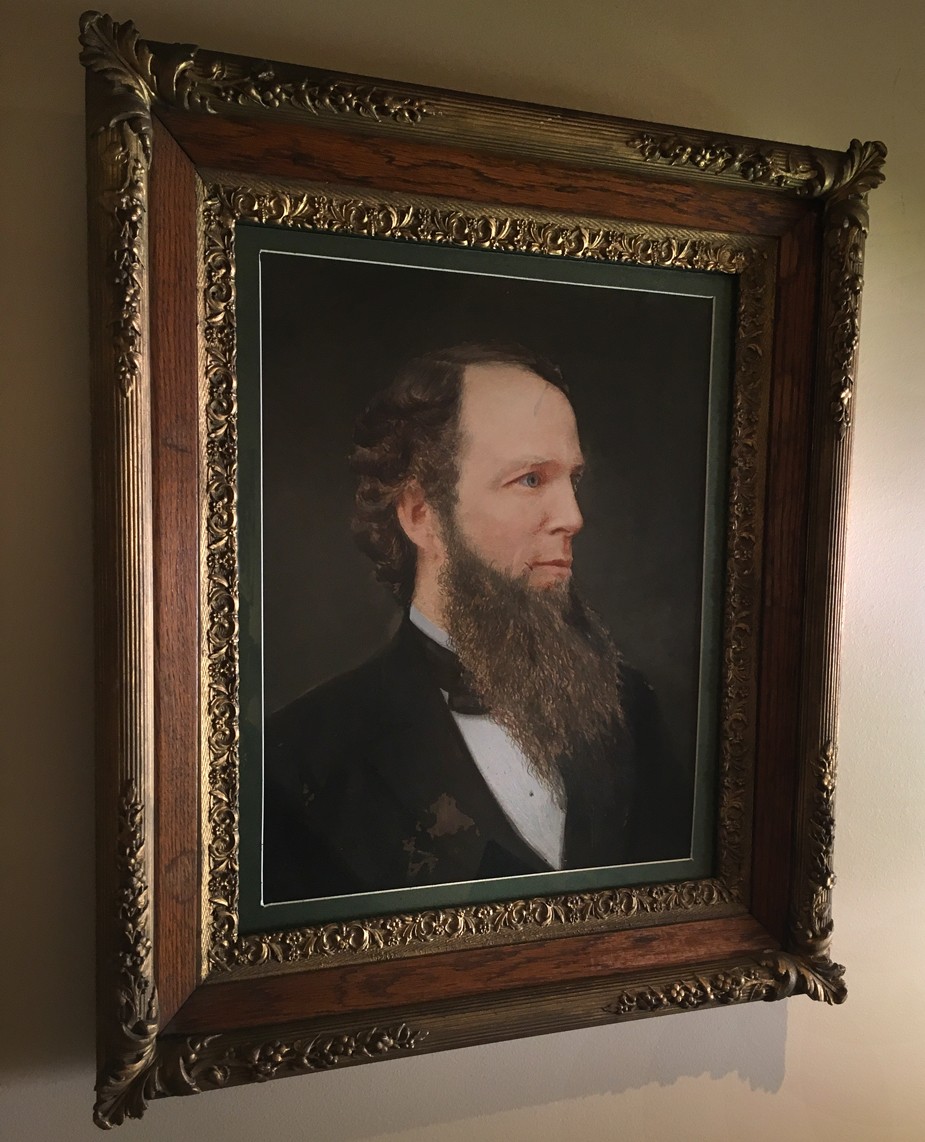 “Portrait of John Lee Cole”: Henry Ravell, American: 1864-1930. Ca. 1885 Gouache and or Oil? on paper, mounted within period wood frame bearing inscription “John L. Cole to Jason Parker, 1918”. This very rare example of a surviving painting by photographer Henry Ravell is now owned by the Museum of Wayne County History in Lyons, New York. Cole was a 1859 graduate of Yale and grandson of the Rev. John Cole, a founder with John Wesley of the Methodist Church in the U.S.. In 1862 he was admitted to the bar and later became a banker in Lyons for Mirick & Cole. An earlier 1882 notice of Henry’s artistic pursuits was published in The Democrat and Chronicle newspaper of Rochester, New York: “Henry Ravell, of Lyons, was in this city last night, on his return from Medina, (New York-editor) where he disposed of two of his latest paintings for $70.” (November 26) Photo by David Spencer for PhotoSeed Archive- artwork courtesy Museum of Wayne County History, Lyons N.Y.
“Portrait of John Lee Cole”: Henry Ravell, American: 1864-1930. Ca. 1885 Gouache and or Oil? on paper, mounted within period wood frame bearing inscription “John L. Cole to Jason Parker, 1918”. This very rare example of a surviving painting by photographer Henry Ravell is now owned by the Museum of Wayne County History in Lyons, New York. Cole was a 1859 graduate of Yale and grandson of the Rev. John Cole, a founder with John Wesley of the Methodist Church in the U.S.. In 1862 he was admitted to the bar and later became a banker in Lyons for Mirick & Cole. An earlier 1882 notice of Henry’s artistic pursuits was published in The Democrat and Chronicle newspaper of Rochester, New York: “Henry Ravell, of Lyons, was in this city last night, on his return from Medina, (New York-editor) where he disposed of two of his latest paintings for $70.” (November 26) Photo by David Spencer for PhotoSeed Archive- artwork courtesy Museum of Wayne County History, Lyons N.Y.
At this time, Henry is said to have moved to Cuernavava Mexico, south of Mexico City, where he became a far-flung agent for the Ten Eyck & Co. firm, although a certain amount of traveling back and forth to the U.S. and the family home was probably the reality. To wit, the Minnesota State Census for 1895 lists his occupation as “artist”, claiming an American residence while living with his father, mother and younger brother, Charles Ravell Jr. in the city of St. Paul. Here his father finished out his career running a photo studio on Western Ave. from 1890-92.
During the mid 1880’s back in Lyons, a fascinating yet presently unsubstantiated account of Henry’s involvement with the development of the first Kodak camera is relevant for background on his future career as a master photographer who became a striver with his own agenda. This event is worthy of historical contemplation in the present from reminisces provided in the aforementioned posthumous biography published in 1940:
“George Eastman of Rochester, New York, was a family friend. During a visit of three or four weeks, Mr. Eastman worked on and developed his famous Kodak, with the help of my father and brother.” “Their workshop was the basement of our former home at 70 Broad Street, Lyons. Mr. Eastman offered my father stock in the Kodak Company, which he often regretted not accepting.” (2.)
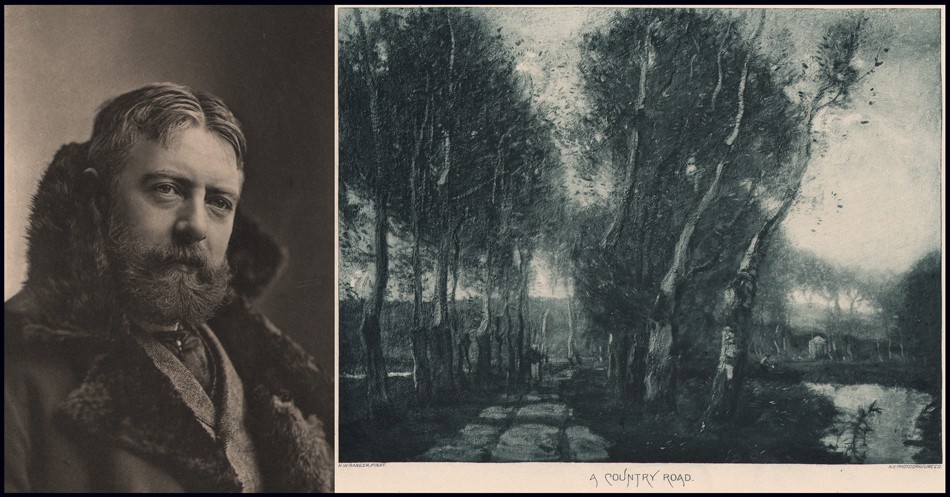 Left: “H.W. Ranger” (Henry Ward Ranger): Napoleon Sarony, American: born Quebec. (1821-1896) Photogravure published in periodical "Sun & Shade": New York: May, 1894: whole #69: N.Y. Photo-Gravure Co.: 22.4 x 15.2 | 34.9 x 27.6 cm. Like Henry Ravell assisting in his father’s studio, American artist and Tonalist Henry Ward Ranger (1858-1916) worked in his own father’s studio as a young man. Later, Ranger taught Henry water-color painting, probably when Ravell was in his late teens or early 20’s. The “Sun & Shade” periodical noting of Ranger: “His work in Lower Canada won him great repute, and as a water-color painter, before taking to oil-painting, he was undeniably excellent.” Right: “A Country Road”: Henry Ward Ranger, American. (1858-1916) Photogravure published in periodical "Sun & Shade": New York: May, 1894: whole #69: N.Y. Photo-Gravure Co.: 17.1 x 22.7 | 27.6 x 34.9 cm. Ranger’s bucolic painting style reveals itself in this simple country scene of a roadway lined with trees, probably done in Holland. Scenes like this would have undoubtedly made an impression on Henry the fledgling art student, assuming he had access to reproductions or the originals of his teacher’s work. On Ranger in the periodical: “He is an admirer and follower of the best Dutch school of art, and has made it his pleasure and his duty to pay many visits to Holland, in order to be perfectly au fait with the excellencies of its best masters.” On “A Country Road”: “It is seldom that so simple a subject becomes so important in form and color-so full of air and freedom, and so admirably harmonious in its proportions.” Both from: PhotoSeed Archive
Left: “H.W. Ranger” (Henry Ward Ranger): Napoleon Sarony, American: born Quebec. (1821-1896) Photogravure published in periodical "Sun & Shade": New York: May, 1894: whole #69: N.Y. Photo-Gravure Co.: 22.4 x 15.2 | 34.9 x 27.6 cm. Like Henry Ravell assisting in his father’s studio, American artist and Tonalist Henry Ward Ranger (1858-1916) worked in his own father’s studio as a young man. Later, Ranger taught Henry water-color painting, probably when Ravell was in his late teens or early 20’s. The “Sun & Shade” periodical noting of Ranger: “His work in Lower Canada won him great repute, and as a water-color painter, before taking to oil-painting, he was undeniably excellent.” Right: “A Country Road”: Henry Ward Ranger, American. (1858-1916) Photogravure published in periodical "Sun & Shade": New York: May, 1894: whole #69: N.Y. Photo-Gravure Co.: 17.1 x 22.7 | 27.6 x 34.9 cm. Ranger’s bucolic painting style reveals itself in this simple country scene of a roadway lined with trees, probably done in Holland. Scenes like this would have undoubtedly made an impression on Henry the fledgling art student, assuming he had access to reproductions or the originals of his teacher’s work. On Ranger in the periodical: “He is an admirer and follower of the best Dutch school of art, and has made it his pleasure and his duty to pay many visits to Holland, in order to be perfectly au fait with the excellencies of its best masters.” On “A Country Road”: “It is seldom that so simple a subject becomes so important in form and color-so full of air and freedom, and so admirably harmonious in its proportions.” Both from: PhotoSeed Archive
Memories can sometimes be suspect, but several details of Florence’s biography are important and worth following up on, with this website happy to accept the challenge. By tracking down old street addresses, the Ravell family home as published in the 1886-87 Lyons residential directory was actually found to be located as 40 Broad Street. (William Smith, whose occupation was Express Transfer Agent, lived at 70 Broad St. as published in the same directory) Coupled with the knowledge that Lyons street addresses had been renumbered, probably in the early 20th Century, and cross-referencing with a 1904 Sanborn Fire Insurance Company map found online at the Library of Congress, the former and still standing Ravell home built in 1850 revealed itself to be the present day 64 Broad Street. All of this effort, if somehow confirming a claim George Eastman had actually spent time in Lyons was true, could result in a potentially fascinating footnote to the development of one of the most important inventions of the 19th Century- The Kodak No. 1 Camera which debuted in 1888: “By far the most significant event in the history of amateur photography”, according to the Met Museum in New York City.
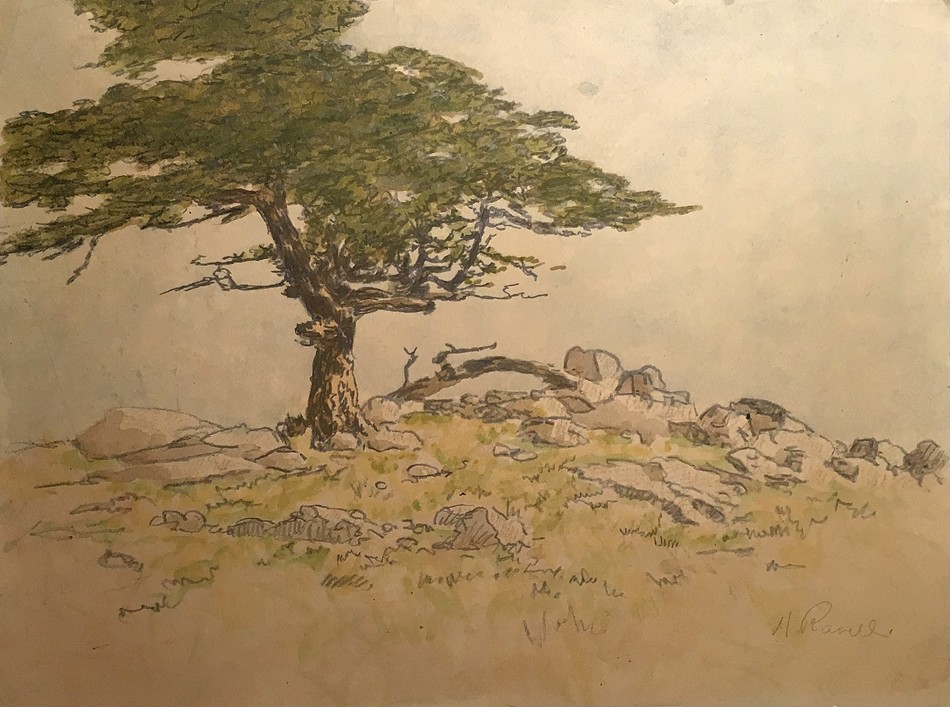 “Cypress Tree -Pebble Beach”: Henry Ravell, American: 1864-1930. Vintage watercolor drawing on paper: ca. 1915-20. (Museum of Wayne County History accession #Pi 176f with verso sticker additionally listing number 148 and $30.00) One of the few known examples of a watercolor drawing by Ravell is this delicate landscape featuring a lone cypress tree springing from a rock outcropping in Pebble Beach on California’s Monterey Peninsula. It may depict the world famous “Lone Cypress”, an approximately 250 year-old Monterey Cypress standing today on a granite hillside off the famed 17-Mile Drive. Courtesy: Museum of Wayne County History, Lyons N.Y.
“Cypress Tree -Pebble Beach”: Henry Ravell, American: 1864-1930. Vintage watercolor drawing on paper: ca. 1915-20. (Museum of Wayne County History accession #Pi 176f with verso sticker additionally listing number 148 and $30.00) One of the few known examples of a watercolor drawing by Ravell is this delicate landscape featuring a lone cypress tree springing from a rock outcropping in Pebble Beach on California’s Monterey Peninsula. It may depict the world famous “Lone Cypress”, an approximately 250 year-old Monterey Cypress standing today on a granite hillside off the famed 17-Mile Drive. Courtesy: Museum of Wayne County History, Lyons N.Y.
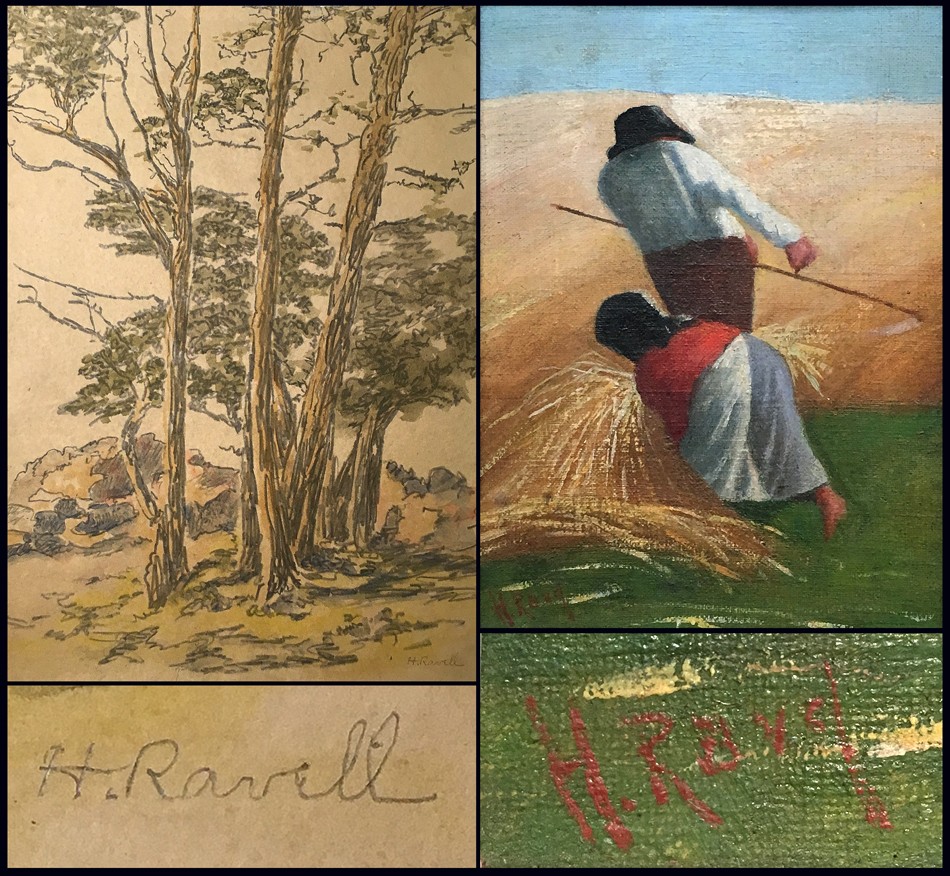 This panel reveals the artistic styles of two distinct artists signing their work nearly identically. It’s presented with the hope a distinction can be made for a larger audience. The reality at present: nearly every painting returned on web searches is misattributed to being by photographer/artist Henry Ravell. Left Diptych: Top: “Cypress Trees at Pebble Beach”: Henry Ravell, American: 1864-1930. Vintage watercolor drawing on paper: ca. 1915-20. (Museum of Wayne County History accession #Pi 176e with verso sticker additionally listing number 147 and $20.00) This is one of three rare watercolor drawings by Ravell. Showing a stand of cypress trees in Pebble Beach on California’s Monterey Peninsula, the signature of “H.Ravell” in graphite has been enlarged in separate bottom panel. Courtesy: Museum of Wayne County History. Right Diptych: Top: “The Ripers” (The Reapers): Henry Etienne Ravel, American, born Naples Italy to French citizens. (1872-1962) Oil on artists board: ca. 1946: 20.5 x 15.4 presented within wood frame (not shown) 24.5 x 19.4 x 2.0 cm. Two field workers harvest wheat, a small landscape most likely depicting the Italian countryside. Henry Ravel immigrated to America in 1906 and became a naturalized US citizen in 1920. A transportation clerk by trade in the early 1920’s, his paintings- many done in Europe- date from ca. 1930’s-1950’s. Enlarged signature at bottom panel: “H. Ravel”. From: PhotoSeed Archive
This panel reveals the artistic styles of two distinct artists signing their work nearly identically. It’s presented with the hope a distinction can be made for a larger audience. The reality at present: nearly every painting returned on web searches is misattributed to being by photographer/artist Henry Ravell. Left Diptych: Top: “Cypress Trees at Pebble Beach”: Henry Ravell, American: 1864-1930. Vintage watercolor drawing on paper: ca. 1915-20. (Museum of Wayne County History accession #Pi 176e with verso sticker additionally listing number 147 and $20.00) This is one of three rare watercolor drawings by Ravell. Showing a stand of cypress trees in Pebble Beach on California’s Monterey Peninsula, the signature of “H.Ravell” in graphite has been enlarged in separate bottom panel. Courtesy: Museum of Wayne County History. Right Diptych: Top: “The Ripers” (The Reapers): Henry Etienne Ravel, American, born Naples Italy to French citizens. (1872-1962) Oil on artists board: ca. 1946: 20.5 x 15.4 presented within wood frame (not shown) 24.5 x 19.4 x 2.0 cm. Two field workers harvest wheat, a small landscape most likely depicting the Italian countryside. Henry Ravel immigrated to America in 1906 and became a naturalized US citizen in 1920. A transportation clerk by trade in the early 1920’s, his paintings- many done in Europe- date from ca. 1930’s-1950’s. Enlarged signature at bottom panel: “H. Ravel”. From: PhotoSeed Archive
The earliest published references to Ravell’s photographic work in the popular press is found around 1905, when Boston’s Photo-Era, writing for their December issue, pronounces him “A new star of the first magnitude”, although noting his two pictures: “Pleasant Valley” and “Viga Canal”, “do not represent him at his best.” This assessment also including listing him on the journal’s noteworthy list of exhibitors whose work had been accepted for the Second American Photographic Salon which ran from 1905-06.
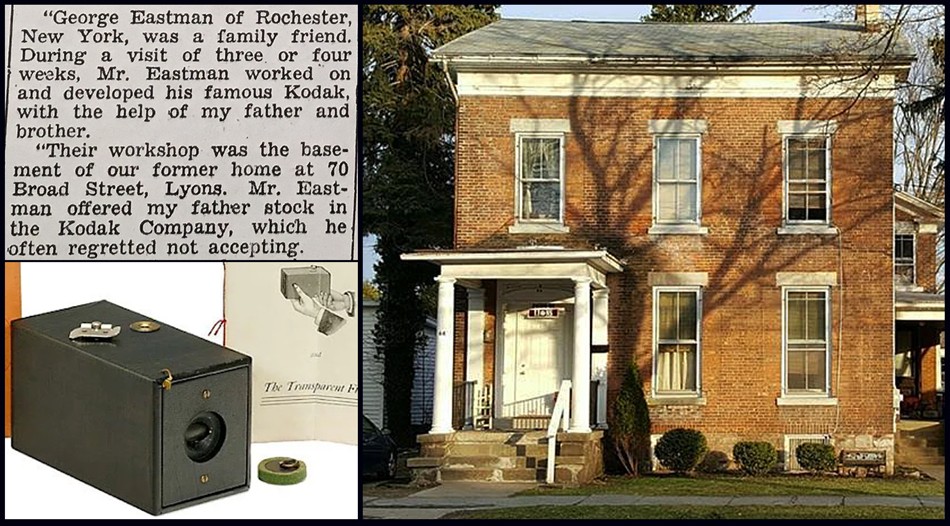 Upper Left: This quote by Henry Ravell’s older sister Florence Ravell Lothrop appeared in The Lyons Republican & Clyde Times on March 21, 1940 stating Henry and their father Charles Henry Ravell had worked with a young George Eastman in developing the world’s first Kodak camera from 1888 in the basement workshop of their Lyons home. Clipping courtesy Museum of Wayne County History. Lower Left: An original Kodak No. 1 camera from 1888 shown with its lens cap and original documents appeared as Lot 0238 and sold by Auction Team Breker of Cologne, Germany on September 30, 2006. The Metropolitan Museum of Art in New York states: “By far the most significant event in the history of amateur photography was the introduction of the Kodak #1 camera in 1888. Invented and marketed by George Eastman (1854–1932), a former bank clerk from Rochester, New York, the Kodak was a simple box camera that came loaded with a 100-exposure roll of film”. Courtesy Auction Team Breker. Far Right: Built in 1850, the former Ravell family home in Lyons, New York was actually located at 64 Broad Street-seen here: not 70 Broad Street as stated in the clipping. The actual address was confirmed by this website using Sanborn fire insurance maps and a Lyons residential street directory from 1886-7. Home exterior courtesy 2018 online real estate sales listing.
Upper Left: This quote by Henry Ravell’s older sister Florence Ravell Lothrop appeared in The Lyons Republican & Clyde Times on March 21, 1940 stating Henry and their father Charles Henry Ravell had worked with a young George Eastman in developing the world’s first Kodak camera from 1888 in the basement workshop of their Lyons home. Clipping courtesy Museum of Wayne County History. Lower Left: An original Kodak No. 1 camera from 1888 shown with its lens cap and original documents appeared as Lot 0238 and sold by Auction Team Breker of Cologne, Germany on September 30, 2006. The Metropolitan Museum of Art in New York states: “By far the most significant event in the history of amateur photography was the introduction of the Kodak #1 camera in 1888. Invented and marketed by George Eastman (1854–1932), a former bank clerk from Rochester, New York, the Kodak was a simple box camera that came loaded with a 100-exposure roll of film”. Courtesy Auction Team Breker. Far Right: Built in 1850, the former Ravell family home in Lyons, New York was actually located at 64 Broad Street-seen here: not 70 Broad Street as stated in the clipping. The actual address was confirmed by this website using Sanborn fire insurance maps and a Lyons residential street directory from 1886-7. Home exterior courtesy 2018 online real estate sales listing.
Florence Ravell, quoting Lockwood de Forest for her 1940 article on Henry, expanded on her brothers new found respect in the profession, particularly in his mastery of the gum print, which would soon establish him as a major talent:
“Henry Ravell was recognized as one of the leading artists in his profession, both in this country and in Europe where he had exhibited, and has been a contributor to many of the photographic magazines, where a description of his technical processes are given. He succeeded in making a gum print in one printing with results far beyond the finest etchings and very similar in character.”
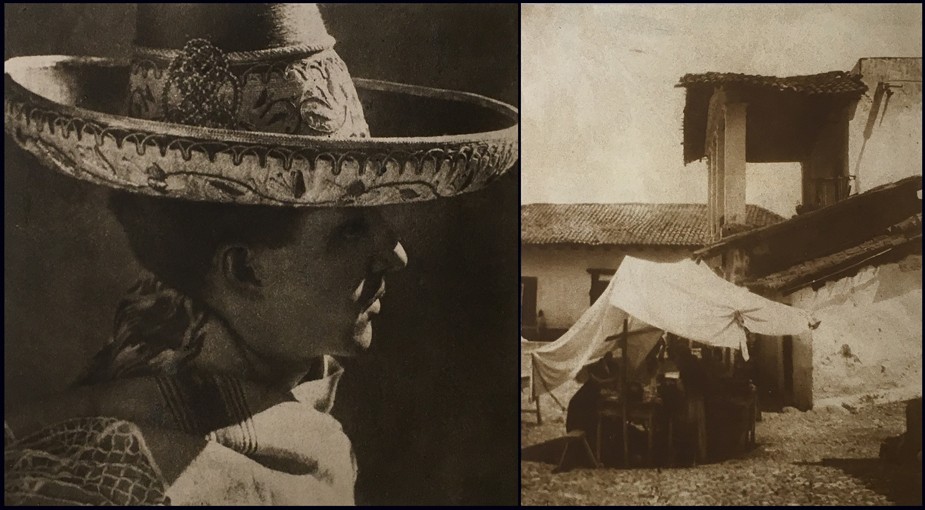 Left: “Mexican Peon”: Henry Ravell, American: 1864-1930. Vintage gum print ca. 1900-15. Alternately titled “A Mexican Peon” as listed in the catalogue of a 1978 retrospective of the artist at the Museum of Wayne County History, although an uncropped variant titled “Mexican Charro” (Mexican Cowboy)- is a more accurate description based on his fancily embroidered sombrero- is held by the California Museum of Photography, Riverside. Right: “Eating Tent-Taxco, Mexico”: Henry Ravell, American: 1864-1930. Vintage gum print ca. 1900-15. These photographs are part of a grouping of 18 singular gum prints featuring Mexican scenes and subjects held in the collection of the Museum of Wayne County History, Lyons N.Y.
Left: “Mexican Peon”: Henry Ravell, American: 1864-1930. Vintage gum print ca. 1900-15. Alternately titled “A Mexican Peon” as listed in the catalogue of a 1978 retrospective of the artist at the Museum of Wayne County History, although an uncropped variant titled “Mexican Charro” (Mexican Cowboy)- is a more accurate description based on his fancily embroidered sombrero- is held by the California Museum of Photography, Riverside. Right: “Eating Tent-Taxco, Mexico”: Henry Ravell, American: 1864-1930. Vintage gum print ca. 1900-15. These photographs are part of a grouping of 18 singular gum prints featuring Mexican scenes and subjects held in the collection of the Museum of Wayne County History, Lyons N.Y.
Henry perfected the gum bichromate process to a very high level. Probably in 1906-07, he began experimenting in multiple color gum. In Germany, around this same time, similar examples were being done by the brothers Theodor (1868-1943) and Oscar Hofmeister, (1871-1937) as well as Heinrich Wilhelm Müller (1859-1933) (3.) The following quote in the December,1908 issue of Boston’s Photo-Era encapsulates the admiration these gum prints received:
“It will be remembered that last summer Henry Ravell, of Mexico, exhibited in New York and Boston his results in multiple gum-bichromate printing in color. They excited considerable interest at the time, especially among our painters, who were very cordial in their praise of Mr. Ravell’s beautiful work, for it showed, in an eminent degree, the artistic possibilities of the gum-process.” (p. 300)
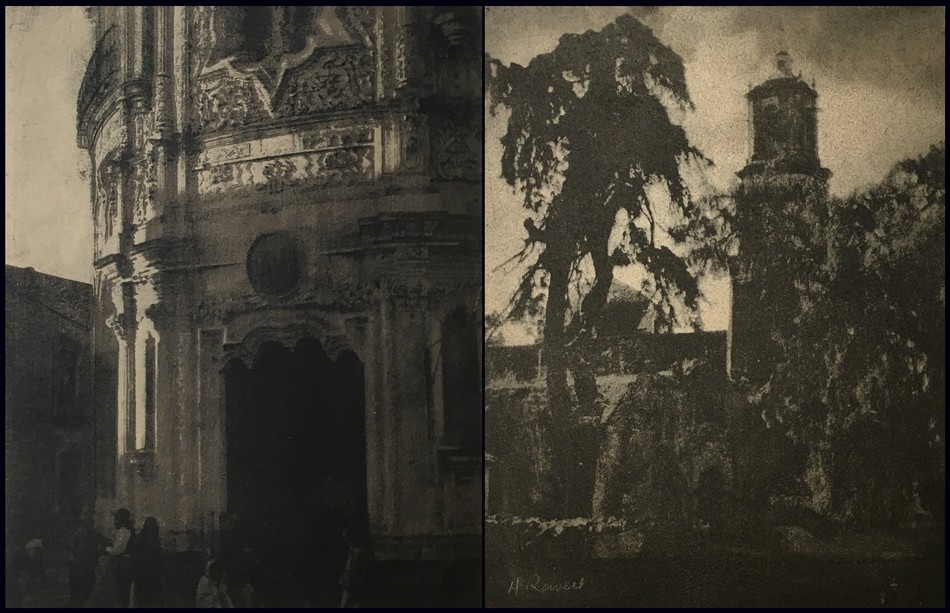 Left: “Chapel of the Holy Well near Mexico City”: Henry Ravell, American: 1864-1930. Vintage gum print ca. 1900-15. Right: “Church, Mexico”: Henry Ravell, American: 1864-1930. Vintage gum print ca. 1900-15. Museum of Wayne County History accession #Pi 176p with verso sticker additionally listing number 2 and $5.00) Featuring church architecture, these are part of a grouping of 18 singular gum prints of Mexican scenes and subjects held in the collection of the Museum of Wayne County History, Lyons N.Y.
Left: “Chapel of the Holy Well near Mexico City”: Henry Ravell, American: 1864-1930. Vintage gum print ca. 1900-15. Right: “Church, Mexico”: Henry Ravell, American: 1864-1930. Vintage gum print ca. 1900-15. Museum of Wayne County History accession #Pi 176p with verso sticker additionally listing number 2 and $5.00) Featuring church architecture, these are part of a grouping of 18 singular gum prints of Mexican scenes and subjects held in the collection of the Museum of Wayne County History, Lyons N.Y.
Again writing in 1940, Florence wrote of her younger brother: “but his favorite work was photography, and the gum print process. This process was original with an Austrian who refused to make it known, but Henry experimented until he developed it, and later gave the formula to the world.” The conjecture of this website is the possibility Henry originally gleaned and modified his own multiple gum color process from the earlier work of Austrian photographer Heinrich Kühn. (1866-1944) An 1897 example of a three-color gum print by him can be found in the collection of the Museum für Kunst und Gewerbe in Hamburg Germany.
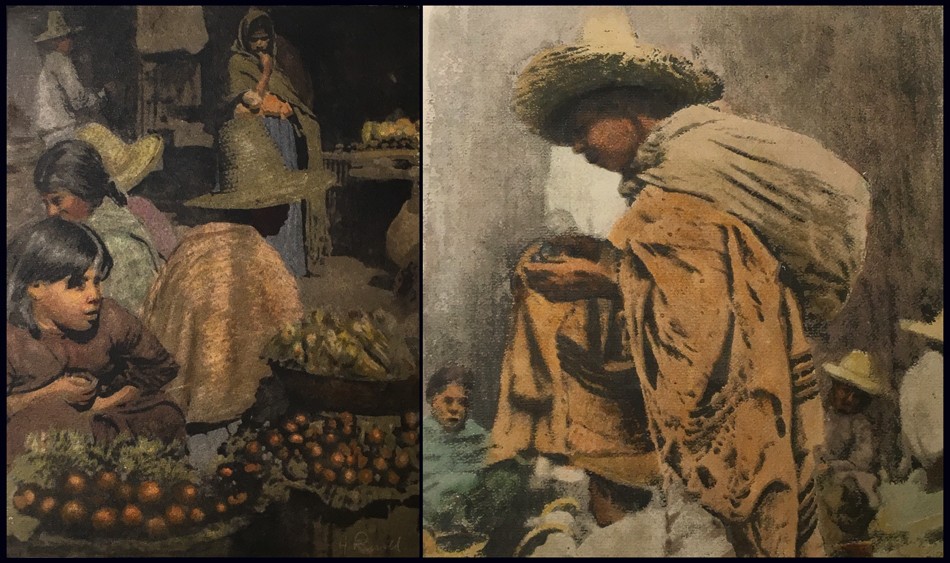 Left: “Mexican Vegetable Seller”: Henry Ravell, American: 1864-1930. Vintage multiple color gum print c. 1907-14. Right: “Mexican Youth”: Henry Ravell, American: 1864-1930. Vintage multiple color gum print c. 1907-14. These are two of the three rare multiple color gum prints by Henry Ravell held in the collection of the Museum of Wayne County History, Lyons N.Y.
Left: “Mexican Vegetable Seller”: Henry Ravell, American: 1864-1930. Vintage multiple color gum print c. 1907-14. Right: “Mexican Youth”: Henry Ravell, American: 1864-1930. Vintage multiple color gum print c. 1907-14. These are two of the three rare multiple color gum prints by Henry Ravell held in the collection of the Museum of Wayne County History, Lyons N.Y.
In 1908, Henry’s champion Lockwood de Forest gave a fuller explanation of the technical details for this color process, as part of copy included with a series of Mexican Church studies published in the May issue of the Century Illustrated Monthly Magazine:
“Last summer he started experiments in color-printing. His process is simple. Instead of introducing colors on the negatives, as in the lumière process, he is using the colors in the sensitizer of the printing paper. The specimens he has sent me are printed in three or four colors. Each print is finished, recoated all over with the sensitizer with the next color, and again printed. This is done for each color separately, the black print coming last, as in the regular color-printing process.”
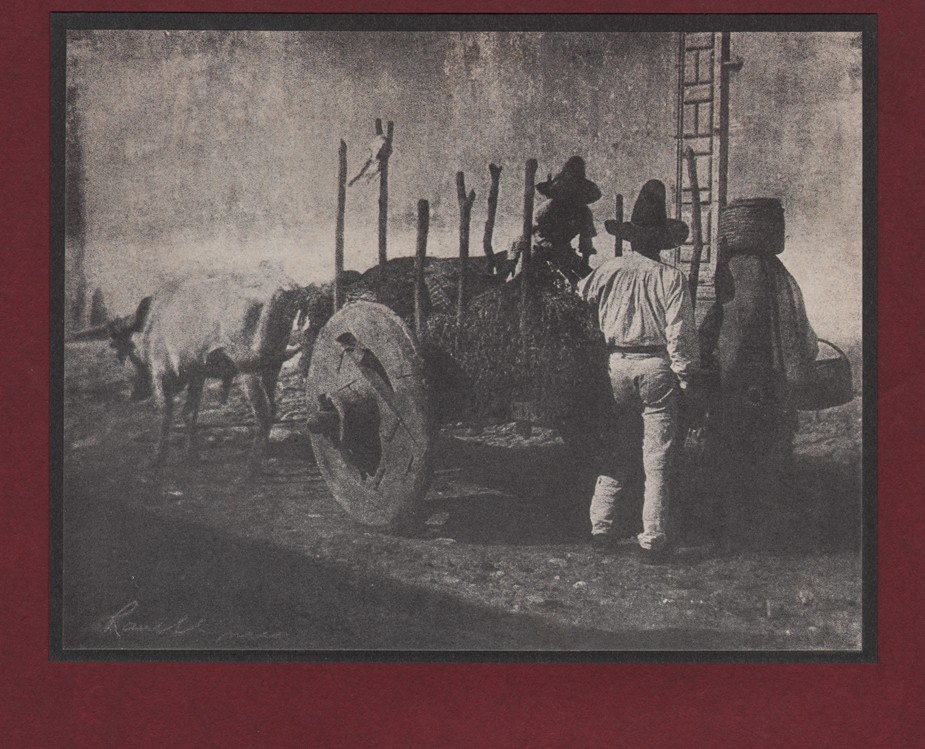 “An Ox Cart” (Mexico): Henry Ravell, American: 1864-1930. 1905: Vintage halftone tipped to mount: 16.6 x 21.4 | 17.4 x 22.2 | 45.0 x 30.5 cm “This mount is Sultan Bokhara and Royal Melton Egyptine Made by the Niagara Paper Mills”. Taken in Mexico ca. 1900-05, this is one of the earliest published examples of a Ravell photograph to appear in the popular press. It was included in the luxury portfolio publication “Art in Photography” issued by the Photo Era Publishing Company of Boston. From: PhotoSeed Archive
“An Ox Cart” (Mexico): Henry Ravell, American: 1864-1930. 1905: Vintage halftone tipped to mount: 16.6 x 21.4 | 17.4 x 22.2 | 45.0 x 30.5 cm “This mount is Sultan Bokhara and Royal Melton Egyptine Made by the Niagara Paper Mills”. Taken in Mexico ca. 1900-05, this is one of the earliest published examples of a Ravell photograph to appear in the popular press. It was included in the luxury portfolio publication “Art in Photography” issued by the Photo Era Publishing Company of Boston. From: PhotoSeed Archive
Ravell continued to work in Mexico until about 1914, when it is believed he moved back to the Los Angeles area of California in order to escape the Civil War (Mexican Revolution) then engulfing the country. A short biography included in the 1978 volume Pictorial Photography in Britain 1900-1920 gives 1916 as a slightly later date, although it was likely he was traveling back and forth from Mexico to the U.S. several times during this tumultuous time:
“In 1916 an article entitled “Cathedrals of Mexico”, illustrated by his work, was published in Harper’s magazine. About this time he left Mexico, almost as a refugee. His studio in Cuernavaca was destroyed by rebels. He moved to California where he began to photograph near Carmel and settled at Santa Barbara.”
Now that this American born “refugee” was back in his home country for good, he immediately set out photographing the beauty of the southern California coastline, with an emphasis on capturing the numerous entanglements of old cypress trees set against the landscape and Pacific Ocean. Conveniently, and perhaps not coincidentally, Lockwood de Forest had moved permanently to Santa Barbara in 1915 after wintering in the area since 1902, with his professional connections to the world of art giving Henry and his work credibility and entrance to a larger audience. These included retrospective exhibitions of nearly 100 framed works of his Mexican and California subjects at major American institutions. These began in October, 1918 at the Pratt Institute Art Gallery in Brooklyn and continued into 1919 at the Albright Art Gallery in Buffalo, New York followed by shows the same year at the newly opened Cleveland Museum of Art and then at the Chicago Art Institute.
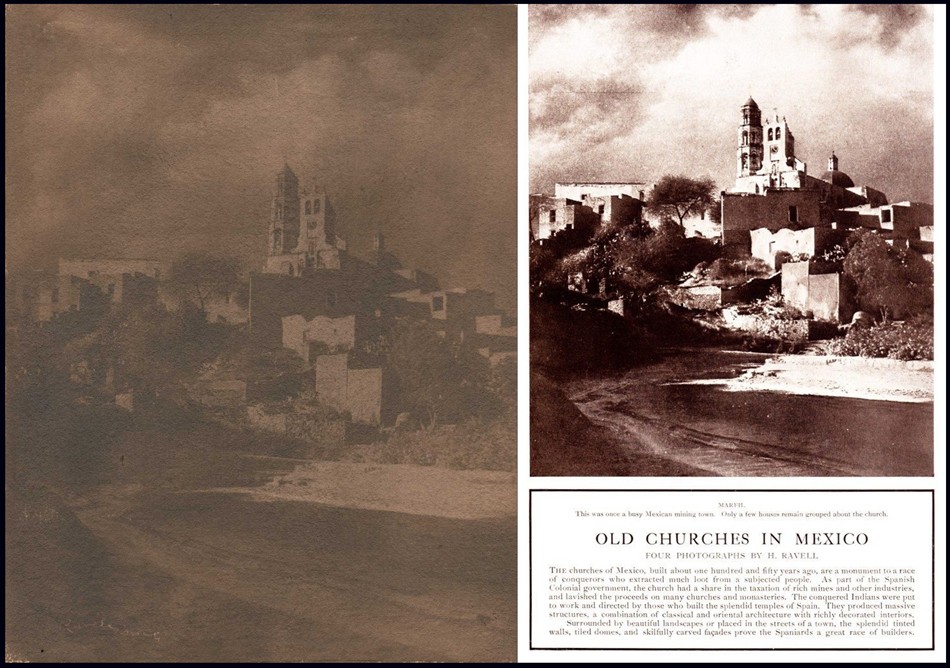 Left: “Marfil: Templo De Marfil De Arriba”: Henry Ravell, American: 1864-1930. Vintage gum print c. 1900-10: 37.4 x 29.0 cm. Still standing today, this church constructed in the Baroque style is located in Marfil, a suburb of the central Mexican city of Guanajuato. The church is colloquially known as “La Iglesia de Arriba”, or the “Church up Top”. From: PhotoSeed Archive Right: Four photographs of Mexican churches by Henry Ravell, including the Templo De Marfil De Arriba photograph, were published in the February, 1914 issue of Century Magazine for a picture spread titled “Old Churches in Mexico”: “The churches of Mexico, built about one hundred and fifty years ago, are a monument to a race of conquerors who extracted much loot from a subjected people. As part of the Spanish Colonial government, the church had a share in the taxation of rich mines and other industries, and lavished the proceeds on many churches and monasteries. The conquered Indians were put to work and directed by those who built the splendid temples of Spain. They produced massive structures, a combination of classical and oriental architecture with richly decorated interiors. Surrounded by beautiful landscapes or placed in the streets of a town, the splendid tinted walls, tiled domes, and skilfully carved facades prove the Spaniards a great race of builders.” From: Internet Archive
Left: “Marfil: Templo De Marfil De Arriba”: Henry Ravell, American: 1864-1930. Vintage gum print c. 1900-10: 37.4 x 29.0 cm. Still standing today, this church constructed in the Baroque style is located in Marfil, a suburb of the central Mexican city of Guanajuato. The church is colloquially known as “La Iglesia de Arriba”, or the “Church up Top”. From: PhotoSeed Archive Right: Four photographs of Mexican churches by Henry Ravell, including the Templo De Marfil De Arriba photograph, were published in the February, 1914 issue of Century Magazine for a picture spread titled “Old Churches in Mexico”: “The churches of Mexico, built about one hundred and fifty years ago, are a monument to a race of conquerors who extracted much loot from a subjected people. As part of the Spanish Colonial government, the church had a share in the taxation of rich mines and other industries, and lavished the proceeds on many churches and monasteries. The conquered Indians were put to work and directed by those who built the splendid temples of Spain. They produced massive structures, a combination of classical and oriental architecture with richly decorated interiors. Surrounded by beautiful landscapes or placed in the streets of a town, the splendid tinted walls, tiled domes, and skilfully carved facades prove the Spaniards a great race of builders.” From: Internet Archive
Henry Ravell would continue to exhibit his work late into the 1920’s at smaller venues, one example being a tri-colored gum print titled “Mexican Peon Boy” shown at the 1927 Los Angeles Salon and remarked on by Camera Craft, his gum prints deemed “for which he has gained a warranted renown”. Gum printing was indeed so important to the artist that he listed “Gum Printer” as his occupation for the 1920 U.S. Census.
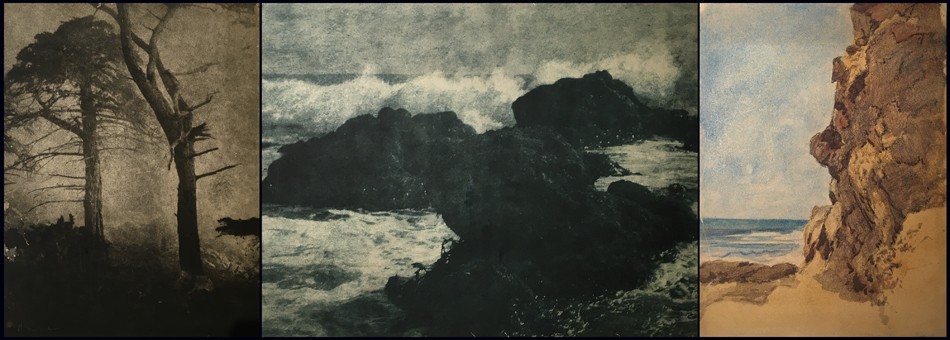 Left: “Pine and Cypress, Pebble Beach”: Henry Ravell, American: 1864-1930. Vintage gum print ca. 1915-20. (Museum of Wayne County History accession #Pi 176a with verso sticker additionally listing number 17 and $3.00) Middle: “Big Splash” (California coastline) Henry Ravell, American: 1864-1930. Vintage gum print ca. 1915-20. (Museum of Wayne County History accession #Pi 176m with verso sticker additionally listing number 122 and $12.00) Right: “Untitled Marine Landscape” (Mexico or California): Henry Ravell, American: 1864-1930. Vintage multiple colored gum print ca. 1907-1920. (Museum of Wayne County History accession #Pi 176n with verso sticker additionally listing number 156 ) All: Courtesy Museum of Wayne County History, Lyons N.Y.
Left: “Pine and Cypress, Pebble Beach”: Henry Ravell, American: 1864-1930. Vintage gum print ca. 1915-20. (Museum of Wayne County History accession #Pi 176a with verso sticker additionally listing number 17 and $3.00) Middle: “Big Splash” (California coastline) Henry Ravell, American: 1864-1930. Vintage gum print ca. 1915-20. (Museum of Wayne County History accession #Pi 176m with verso sticker additionally listing number 122 and $12.00) Right: “Untitled Marine Landscape” (Mexico or California): Henry Ravell, American: 1864-1930. Vintage multiple colored gum print ca. 1907-1920. (Museum of Wayne County History accession #Pi 176n with verso sticker additionally listing number 156 ) All: Courtesy Museum of Wayne County History, Lyons N.Y.
The Albright Art Gallery was an important venue for Ravell’s work, considering the groundbreaking exhibition it previously hosted in November, 1910: the International Exhibition of Pictorial Photography. Organized by the Photo-Secession under the direction of Alfred Stieglitz, it was “the first exhibition held at an American museum that aimed to elevate photography’s stature from a purely scientific pursuit to a visual form of artistic expression.” Even nine years later, in 1919, at a time when museum shows devoted to the work of a singular photographer anywhere in the world were still few and far between and remained so decades later, it’s refreshing in the present to read observations by one curator remarking on Ravell’s 93 framed photographs displayed at the Albright gallery for Academy Notes, the mouthpiece for The Buffalo Fine Arts Academy:
“THE collection of photographs by H. Ravell—which was on view in the gallery during the last week in February and all of March—is very unique and valuable. These photographs are technically known as gum-prints and have all the painter’s quality in their execution. They do not impress one as photographs but rather as work directly from the artist’s brush. The photographs were made by H. Ravell who is now in Santa Barbara. Many of the pictures were taken near Carmel, California, a seashore of much variety where the fantastic cypress trees with their twisted dramatic forms produce wonderful compositions against sea and sky.” …This is but a short description of the remarkable exhibition of photographs shown at the Albright Art Gallery. It was seen by many art lovers and appreciated especially by all of those interested in artistic photography.” (4.)
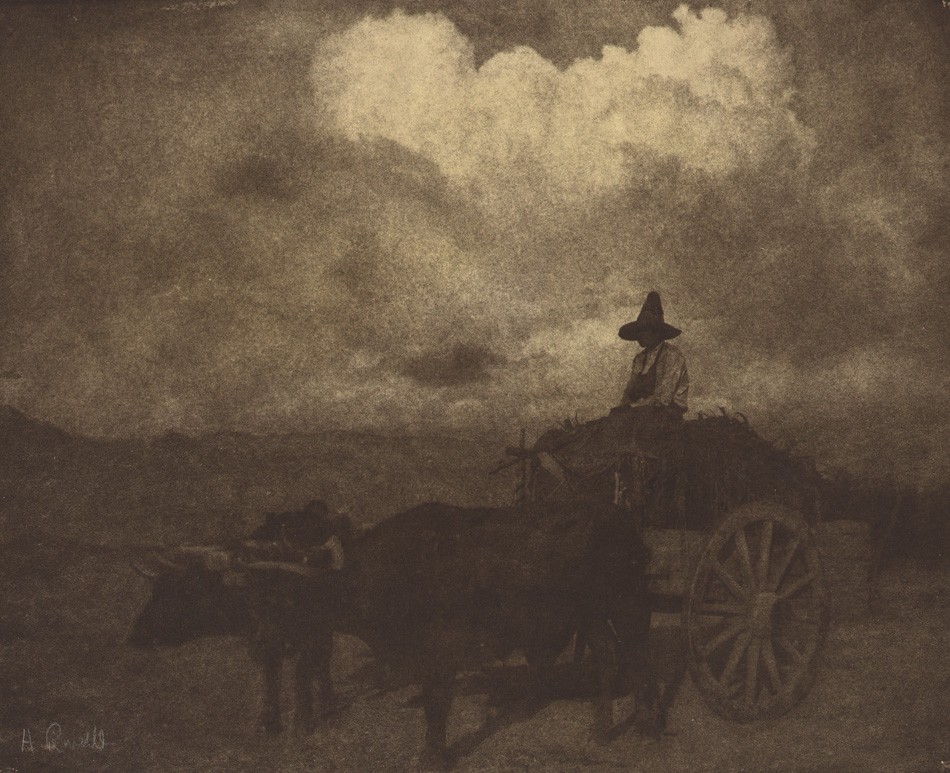 “Ox Cart- Sunset”: Henry Ravell, American: 1864-1930. Vintage gum print ca. 1900-10. Image: 27.0 x 32.6 cm presented loose within dark brown paper folder with overall support dimensions of 58.8 x 36.7 cm. Wearing a traditional sombrero hat, (Sombrero de charro) the driver of this ox or bullock cart pauses atop a full load of what looks like hay or silage. This Mexican scene may date to around 1905-consistent with a different view by the artist of an ox cart published that year in “Art in Photography” by the the Photo Era Publishing Company of Boston. From: PhotoSeed Archive
“Ox Cart- Sunset”: Henry Ravell, American: 1864-1930. Vintage gum print ca. 1900-10. Image: 27.0 x 32.6 cm presented loose within dark brown paper folder with overall support dimensions of 58.8 x 36.7 cm. Wearing a traditional sombrero hat, (Sombrero de charro) the driver of this ox or bullock cart pauses atop a full load of what looks like hay or silage. This Mexican scene may date to around 1905-consistent with a different view by the artist of an ox cart published that year in “Art in Photography” by the the Photo Era Publishing Company of Boston. From: PhotoSeed Archive
A reevaluation of Henry Ravell’s body of work is important to consider in the present given the broad acknowledgement of his talent by major institutions and the popular press for the benefit of many large audiences over 100 years ago. An important pictorialist photographer who was also a painter, Henry Ravell was a striver and apprentice graduate inspired by his father’s steady trade in the New York state village of Lyons who embraced a love for craft and mastery of art. Together, these skills gave him the passion to embrace adventure in capturing the beauty in far-off Mexico and southern California for the ages.
Four original gum prints in the PhotoSeed Archive can be seen here, each listing an expanded biography, timeline and major institutional holdings for the artist.
Afterword | Notes
A conundrum on internet research into Henry Ravell’s artistic output reveals itself quickly. The bottom line is that most every painting on the web attributed to Henry Ravell the photographer is not by him. Instead, through PhotoSeed’s research and purchase of the small painting: “The Ripers”, (The Reapers) the true identity of this artist can now be revealed as Henry Etienne Ravel. (1872-1962) Born in Naples Italy to French citizens, Henry Ravel immigrated to America in 1906 and became a naturalized US citizen in 1920. A transportation clerk by trade in the early 1920’s, his paintings- many done in Europe- date from ca. 1930’s-1950’s. What causes the confusion is that like Henry Ravell the photographer, who signed his photographs “H. Ravell”, Henry Ravel the painter also signed his work similarly, but as “H. Ravel” Numerous examples of his paintings show up on Google searches-unlike the real and quite rare examples of watercolors done by Ravell the photographer. I’ve included links to some of these paintings on the page showing “The Ripers”. As always- buyer beware and do your homework!
1. C. Ravel won a $3.00 premium for “Best Daguerreotypes” during the Annual Fair of the Madison County Agricultural Society held at Morrisville, (N.Y.) on the 15th, 16th and 17th days of September,1857 according to a newspaper account in the Cazenovia Republican. Shout out to the Pioneer American Photographers 1839-1860 website. Langdon’s List of 19th & Early 20th Century Photographers additionally list Ravel working in Manlius, New York in the 1859 N.Y. State Business Directory.
2. See: The Lyons Republican & Clyde Times: Lyons, N.Y. Thursday, March 21, 1940. Article excerpts: HENRY RAVELL: “Resided in Lyons for twenty-eight years, died in Los Angeles California, January 20, 1930. This account was written by his sister, Mrs. Florence Ravell Lothrop, of 721 Fifth Street North, St. Petersburg, Florida.: “Henry had no special training in any school or under any masters except my father, Charles Herring Ravel, who was born in Boston, England, and became one of the first photographers in the United States. His forbears came over with William the Conqueror to England, which accounts for the one “L” in the name. My mother was annoyed because most people called her Mrs. Rav’-el and persuaded my father to add “L”, so the family adopted that spelling of our name.…Henry studied and experimented all his life. His photographic subjects were portraits, landscapes, street scenes, trees, cloud and moonlight effects. His Mexican Cathedrals were especially noteworthy. He used both oils and water colors, but his favorite work was photography, and the gum print process. This process was original with an Austrian who refused to make it known, but Henry experimented until he developed it, and later gave the formula to the world. I remember seeing around his studio, pans of water about three inches deep. The photo-print was put into the water and pigments of paint dropped on it, this gave the effect when completed of a soft beautiful painting. My description to an artist will seem crude but that is as I recall it.…Henry never taught, that is, acted as a teacher in any school, and I do not know what societies he belonged. He exhibited in the Pittsburgh, Pennsylvania, Salon about 1907. From the thousands of photographs submitted, three of his were among the 237 accepted. His work was exhibited at the Salmagundi Club, New York City; Thurber’s and Anderson’s Galleries in Chicago, Los Angeles, California, and many, many other places. Fifteen of his photographs are at the Metropolitan Museum, New York City. Seven are Mexican subjects and eight are California trees. These were selected by Forest Lockwood.(sic) After Henry’s death at Los Angeles, California, in 1930, a request came for him to send an exhibit to the Fifth International Photographic Salon of Japan held at Tokyo and Osaka in May, 1931.”
3. In the December, 1908 issue of Boston’s Photo-Era, a short article titled “Gum-Prints In Colors” appeared, linking Ravell’s gum prints as being similar to “a collection of prints by the same process, probably with modifications” to work done by the Hofmeister brothers and Müller. These German works were shown at the offices of The British Journal of Photography in London’s Strand from September 28- October 24, 1907.
4. See: Academy Notes: The Buffalo Fine Arts Academy: Albright Art Gallery: Buffalo, New York: vol. XIV: Jan.-Oct. 1919, p. 67
Summer Streams Wide & Small
Posted June 2019 in Alternate Processes, Childhood Photography, Color Photography, Documentary Photography, Journals, New Additions, Painters|Photographers, Scientific Photography, Significant Photographers, Significant Photographs, Unknown Photographers
Herein a summer interlude, if you will, of still, trickling and gushing streams from years past. And if they inspire and beckon for the present, find your own peace or wonderment in the mountains, valleys or pastures of summer wherever your own stream flows.
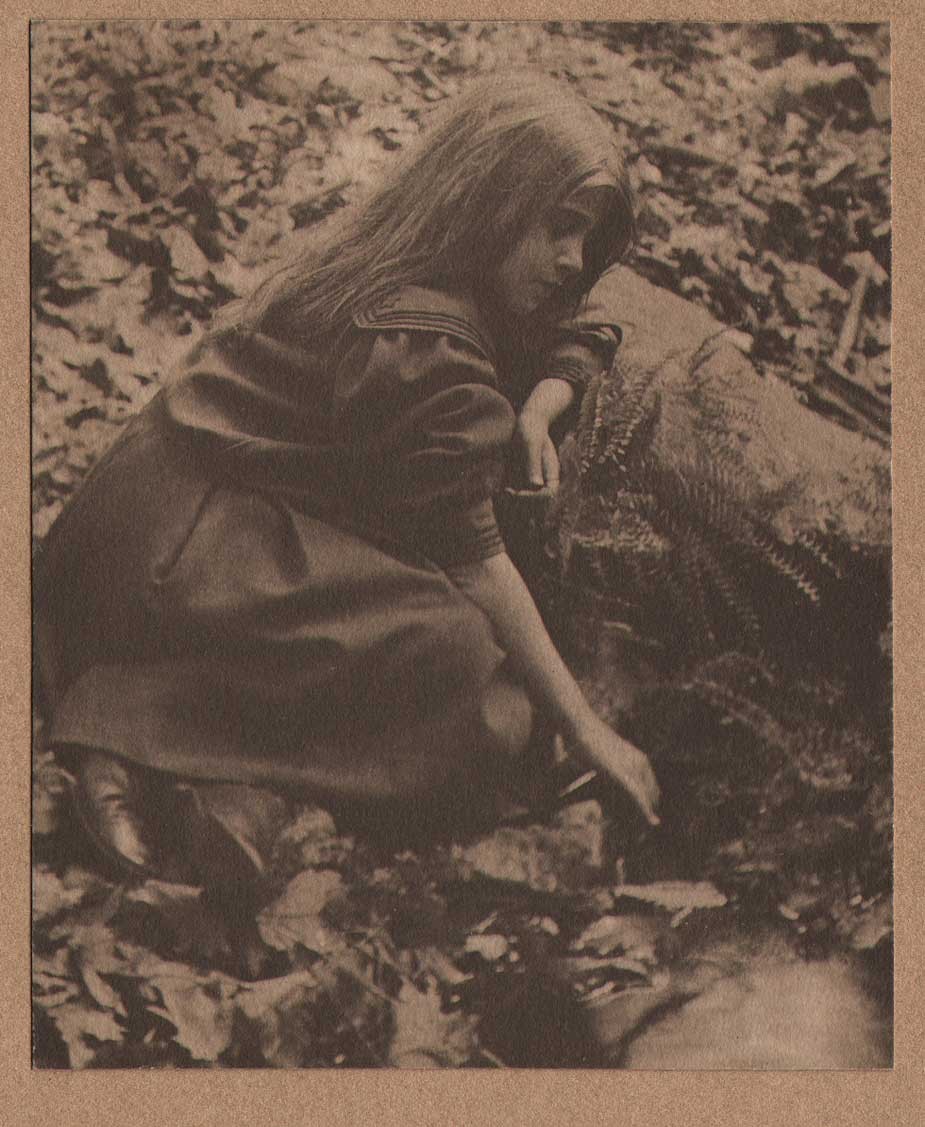 “Dorothy Tucker Gathering Ferns”: Charles Rollins Tucker, American (b. 1868): ca. 1910: mounted brown-toned platinum print: 9.4 x 7.7 cm | 31.2 x 16.0 cm. Born in August, 1899, Dorothy Tucker, a constant photographic subject for her father, then a high school physics teacher at Curtis High School on Staten Island, New York state, holds a spray of freshly-picked ferns while investigating the edge of a stream in the woods. From: PhotoSeed Archive
“Dorothy Tucker Gathering Ferns”: Charles Rollins Tucker, American (b. 1868): ca. 1910: mounted brown-toned platinum print: 9.4 x 7.7 cm | 31.2 x 16.0 cm. Born in August, 1899, Dorothy Tucker, a constant photographic subject for her father, then a high school physics teacher at Curtis High School on Staten Island, New York state, holds a spray of freshly-picked ferns while investigating the edge of a stream in the woods. From: PhotoSeed Archive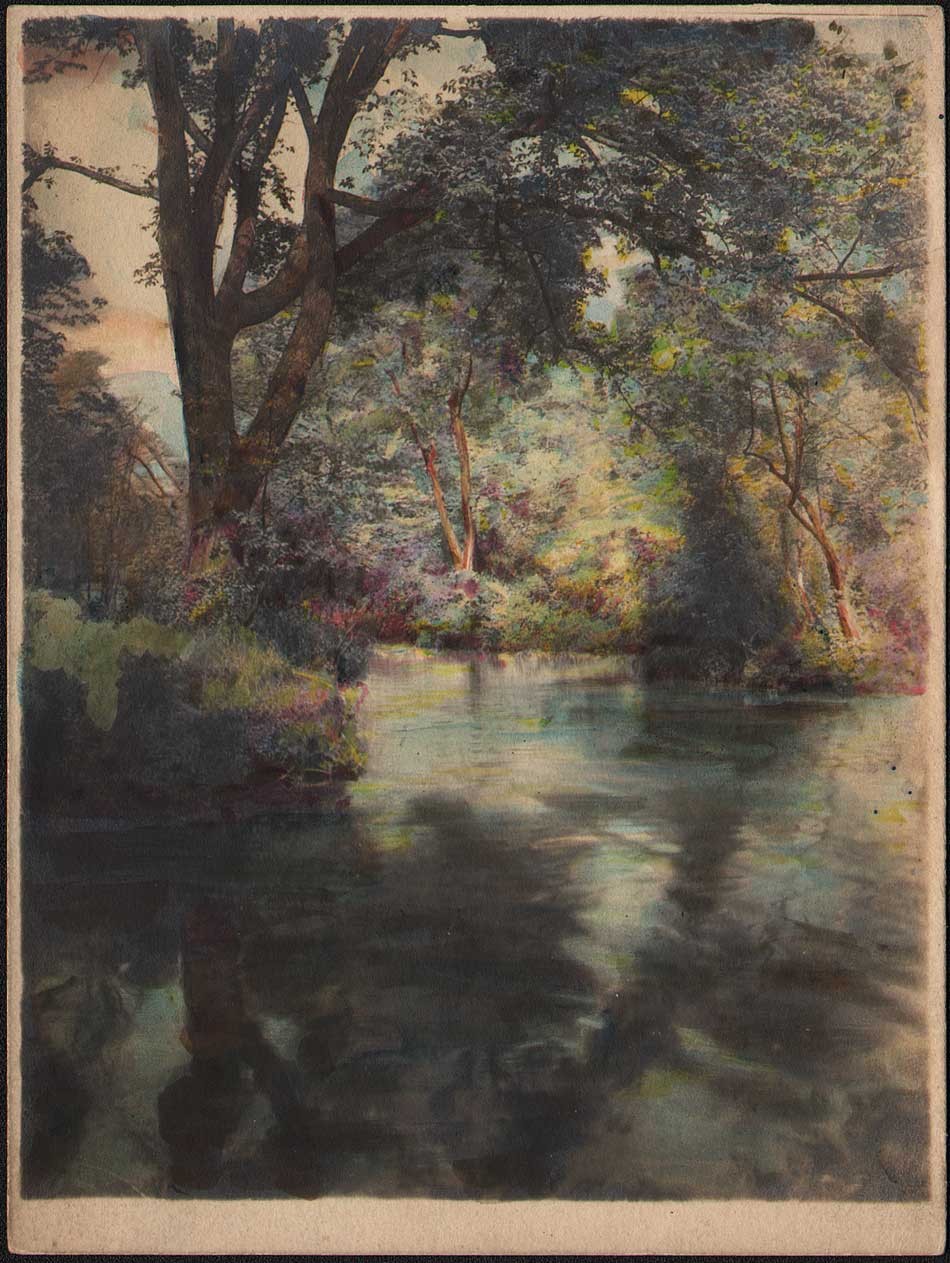 “Stream or Pond at Prospect Park"(Brooklyn, New York): ca. 1910-20: Unknown Brooklyn photographer: hand-colored gelatin silver print: 11.7 x 8.9 cm | 12.4 x 9.3 cm: From: PhotoSeed Archive
“Stream or Pond at Prospect Park"(Brooklyn, New York): ca. 1910-20: Unknown Brooklyn photographer: hand-colored gelatin silver print: 11.7 x 8.9 cm | 12.4 x 9.3 cm: From: PhotoSeed Archive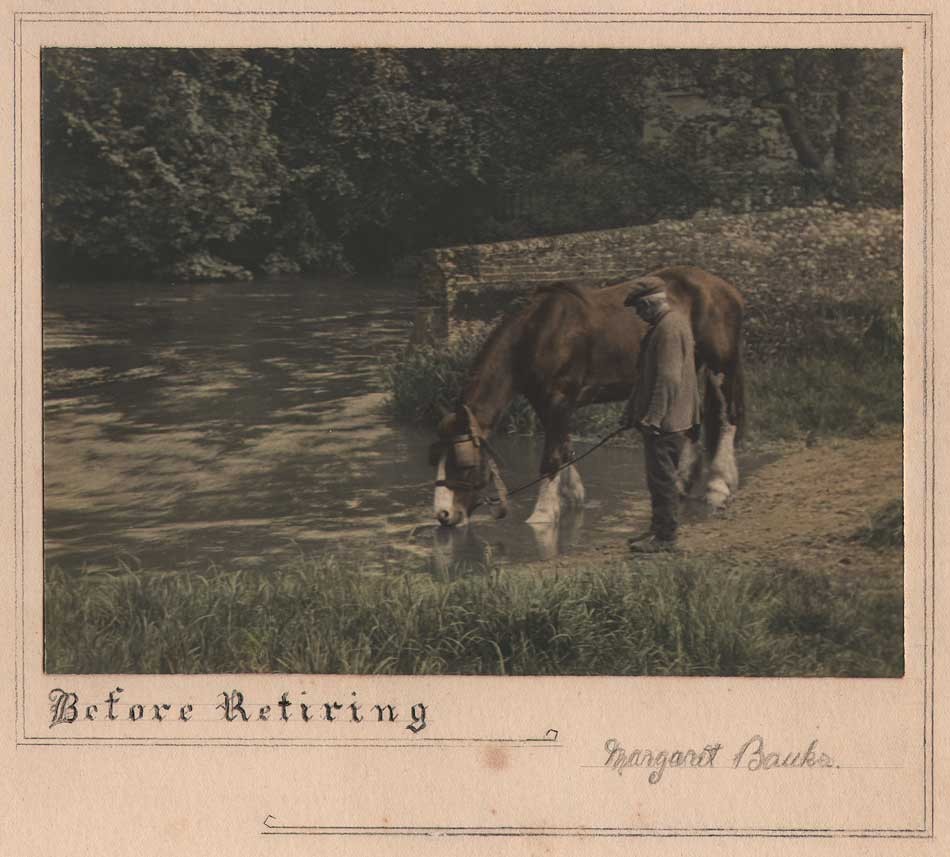 “Before Retiring”: ca. 1910-20: Margaret Bauks, British- (possibly Margaret Florence Bauks: b. 1872?) : hand-colored gelatin silver print: 11.6 x 15.9 cm | 27.8 x 22.8 cm: From: PhotoSeed Archive
“Before Retiring”: ca. 1910-20: Margaret Bauks, British- (possibly Margaret Florence Bauks: b. 1872?) : hand-colored gelatin silver print: 11.6 x 15.9 cm | 27.8 x 22.8 cm: From: PhotoSeed Archive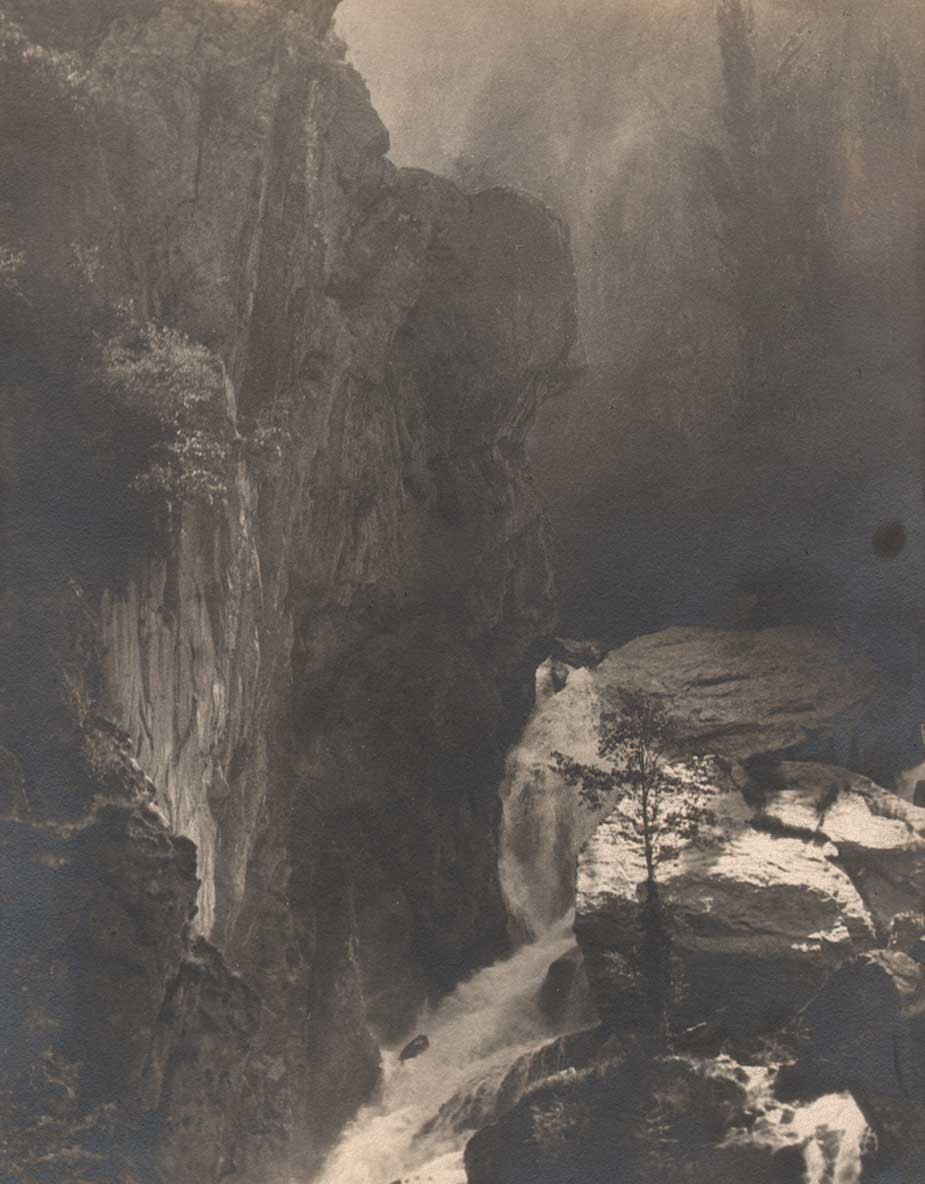 “A Stream of Savoy”: ca. 1927: this print exhibited 1935: Frank Roy Fraprie, American (1874-1951): vintage Bromide print: 24.0 x 18.6 cm | 30.5 x 25.4 cm: As noted in the 1946 American Annual of Photography, (p. 170) Fraprie had been taking photographs in June of 1926 in Eastern France. The area, located in the Haute-Savoie, or Upper Savoy, is a mountainous region of spectacular beauty which includes Lake Annecy, one of France’s largest freshwater lakes. Photographic historian Christian Peterson’s biography of Fraprie gives some background on this important photographer and editor: “Fraprie was the most influential author/publisher of American pictorial photography during the period following the Photo-Secession. From the 1910s to the 1940s, he wrote books and countless articles on all aspects of pictorialism. He edited photographic monthlies and annuals for nearly the entire first half of the twentieth century. In addition, he created his own highly successful pictorial photographs and exhibited them extensively.” From: PhotoSeed Archive
“A Stream of Savoy”: ca. 1927: this print exhibited 1935: Frank Roy Fraprie, American (1874-1951): vintage Bromide print: 24.0 x 18.6 cm | 30.5 x 25.4 cm: As noted in the 1946 American Annual of Photography, (p. 170) Fraprie had been taking photographs in June of 1926 in Eastern France. The area, located in the Haute-Savoie, or Upper Savoy, is a mountainous region of spectacular beauty which includes Lake Annecy, one of France’s largest freshwater lakes. Photographic historian Christian Peterson’s biography of Fraprie gives some background on this important photographer and editor: “Fraprie was the most influential author/publisher of American pictorial photography during the period following the Photo-Secession. From the 1910s to the 1940s, he wrote books and countless articles on all aspects of pictorialism. He edited photographic monthlies and annuals for nearly the entire first half of the twentieth century. In addition, he created his own highly successful pictorial photographs and exhibited them extensively.” From: PhotoSeed Archive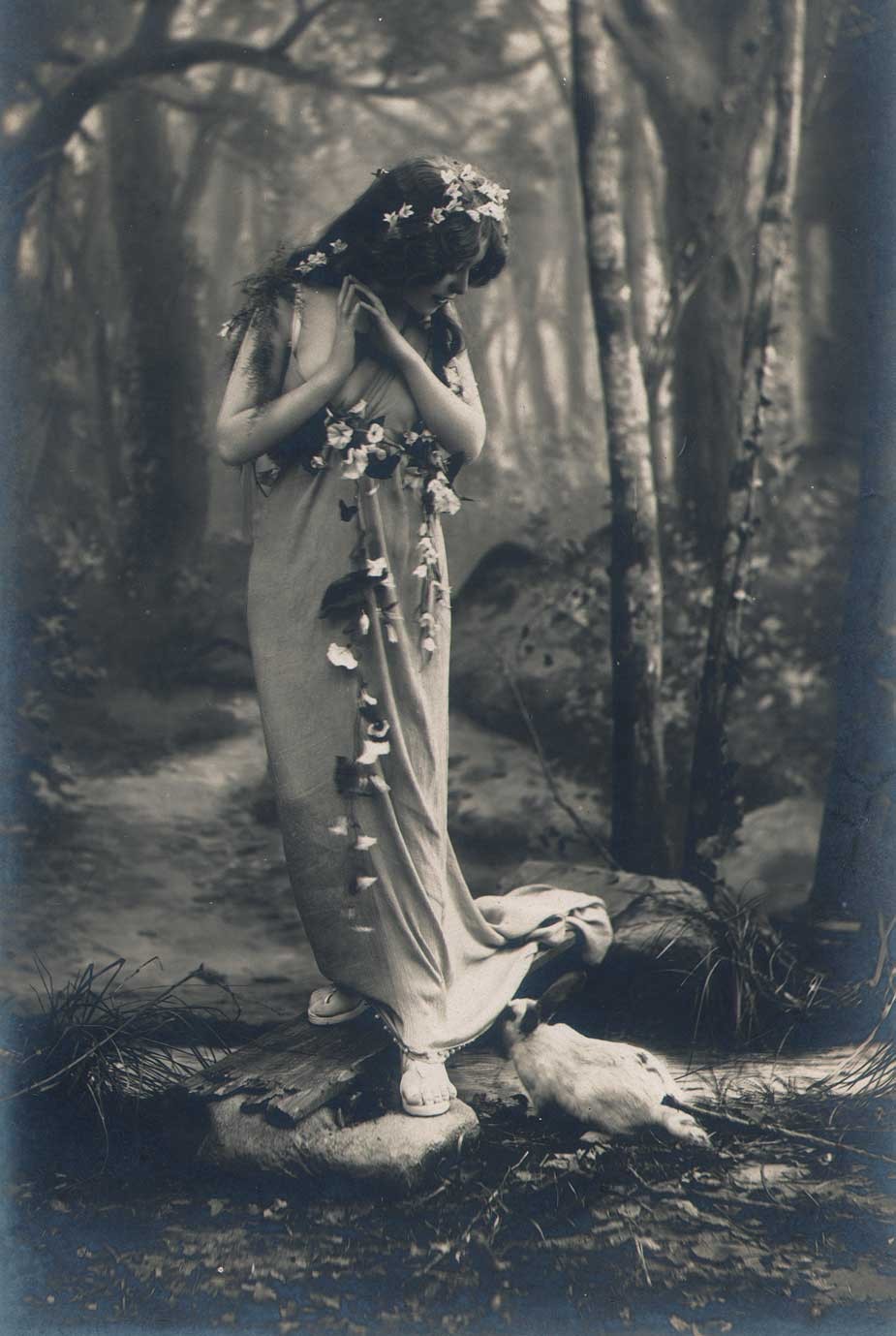 Detail: “Les Fleurs Dans Le Bois” : Léopold-Émile Reutlinger: French (1863-1937): vintage Bromide photograph, ca. 1905. 22.3 x 14.1 | 34.0 x 24.2 cm. Featuring a painted backdrop and wood board placed over a “stream”, this studio photograph features a white rabbit investigating the Belle Epoque era model identified from other variants as “Miss Doll”.(proper identification of this model would be of interest as she has remained a popular subject seen in countless vintage postcards, many hand-tinted) This example was printed by the Milan atelier Maison Tensi and included as a full-page plate in the February, 1905 issue of “La Fotographia Artistica”, a French/Italian photographic journal. From: PhotoSeed Archive
Detail: “Les Fleurs Dans Le Bois” : Léopold-Émile Reutlinger: French (1863-1937): vintage Bromide photograph, ca. 1905. 22.3 x 14.1 | 34.0 x 24.2 cm. Featuring a painted backdrop and wood board placed over a “stream”, this studio photograph features a white rabbit investigating the Belle Epoque era model identified from other variants as “Miss Doll”.(proper identification of this model would be of interest as she has remained a popular subject seen in countless vintage postcards, many hand-tinted) This example was printed by the Milan atelier Maison Tensi and included as a full-page plate in the February, 1905 issue of “La Fotographia Artistica”, a French/Italian photographic journal. From: PhotoSeed Archive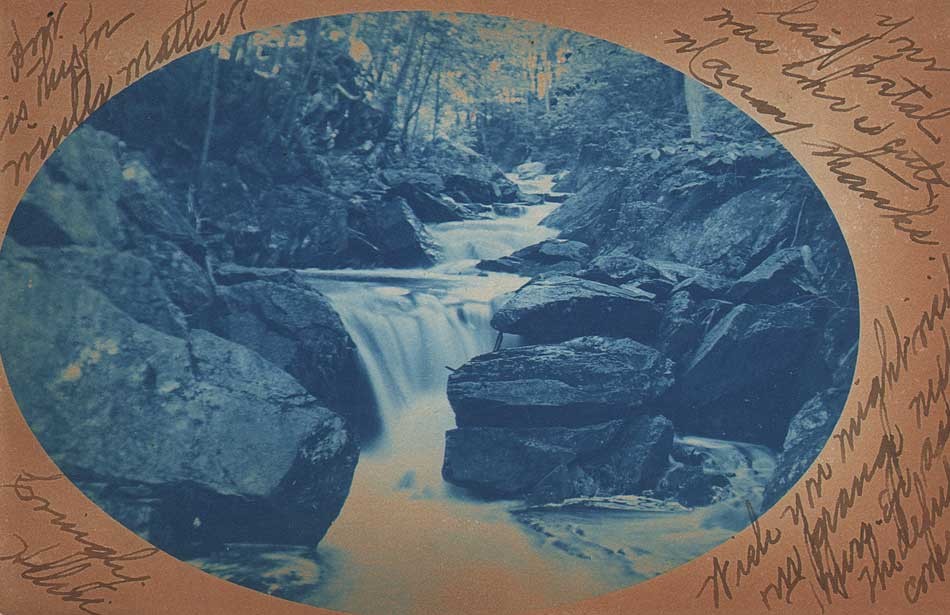 “A Rocky Brook” (New England?) : ca. 1906: Unknown American photographer: vintage cyanotype rppc: 8.9 x 13.8 cm. This idyllic cascading waterfall may depict the Minnewawa Glen in Marlborough, New Hampshire. Signed on the recto: “Lovingly Helen” in the lower left corner, it’s postmarked November 15, 1906 from Marlboro, N.H. addressed to Miss Nettie A. Hastings of East Sullivan, N.H. From: PhotoSeed Archive
“A Rocky Brook” (New England?) : ca. 1906: Unknown American photographer: vintage cyanotype rppc: 8.9 x 13.8 cm. This idyllic cascading waterfall may depict the Minnewawa Glen in Marlborough, New Hampshire. Signed on the recto: “Lovingly Helen” in the lower left corner, it’s postmarked November 15, 1906 from Marlboro, N.H. addressed to Miss Nettie A. Hastings of East Sullivan, N.H. From: PhotoSeed Archive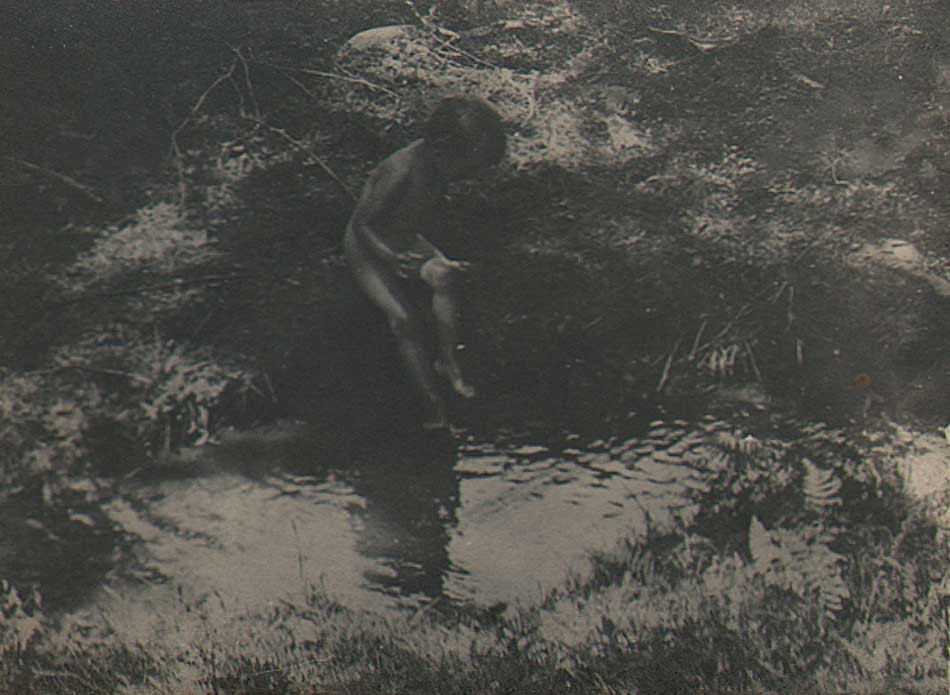 “John Robert Tucker Skinny Dipping”: Charles Rollins Tucker, American (b. 1868): ca. 1915: unmounted platinum print: 3.8 x 5.2 cm. Born in March, 1914, John Robert Tucker, was the second of three children born to the former Mary Carruthers and photographer Charles R. Tucker. Here, the young boy plays in a woodland stream, with the photograph most likely taken in New England. John, according to his 1941 marriage certificate, was an electrical engineer by training. He died in 1991 in La Habra, Orange County, CA. From: PhotoSeed Archive
“John Robert Tucker Skinny Dipping”: Charles Rollins Tucker, American (b. 1868): ca. 1915: unmounted platinum print: 3.8 x 5.2 cm. Born in March, 1914, John Robert Tucker, was the second of three children born to the former Mary Carruthers and photographer Charles R. Tucker. Here, the young boy plays in a woodland stream, with the photograph most likely taken in New England. John, according to his 1941 marriage certificate, was an electrical engineer by training. He died in 1991 in La Habra, Orange County, CA. From: PhotoSeed Archive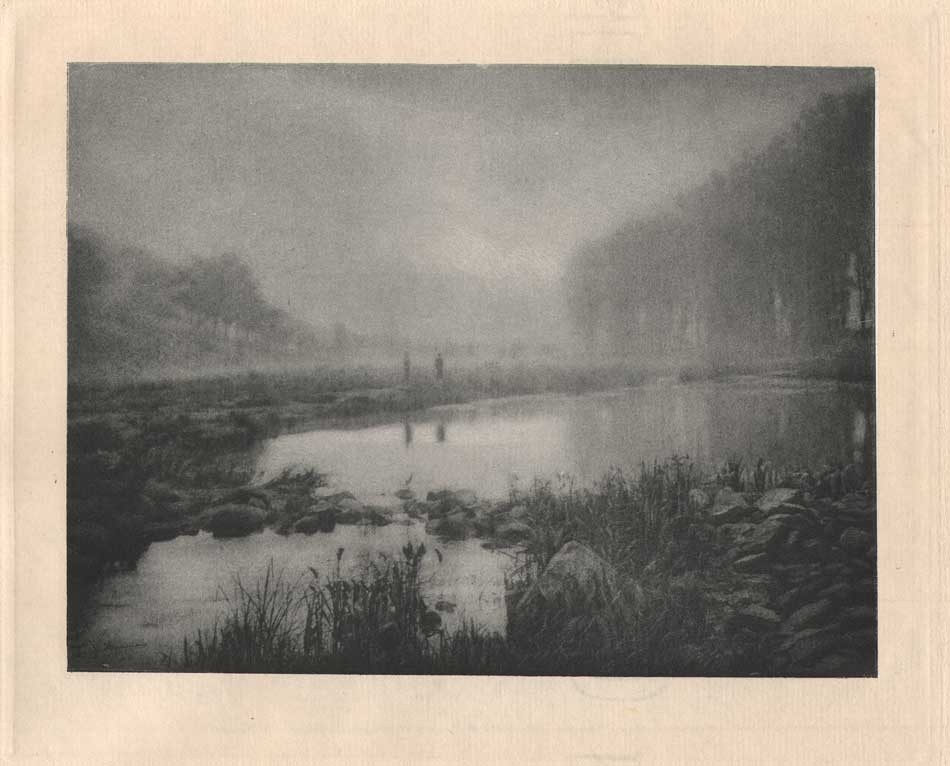 “Brume après la Pluie”: (1906) 1908: Gustave Marissiaux, Belgian (1872-1929) Photogravure on Van Gelder Zonen laid paper: 13.4 x 17.6 | 28.4 x 39.9 cm. Plate XXVI from Marissiaux’s tour-de-force gravure folio “Visions D’Artiste” comprised of 30 plates dating 1899-1908. Translating to “Mist after the Rain”, two figures in the distance stand looking out over an enlarged pond or stream located in "La Terre Wallonne” as identified in the portfolio index: more commonly known today as Wallonia- the southern region of Belgium. From: PhotoSeed Archive
“Brume après la Pluie”: (1906) 1908: Gustave Marissiaux, Belgian (1872-1929) Photogravure on Van Gelder Zonen laid paper: 13.4 x 17.6 | 28.4 x 39.9 cm. Plate XXVI from Marissiaux’s tour-de-force gravure folio “Visions D’Artiste” comprised of 30 plates dating 1899-1908. Translating to “Mist after the Rain”, two figures in the distance stand looking out over an enlarged pond or stream located in "La Terre Wallonne” as identified in the portfolio index: more commonly known today as Wallonia- the southern region of Belgium. From: PhotoSeed Archive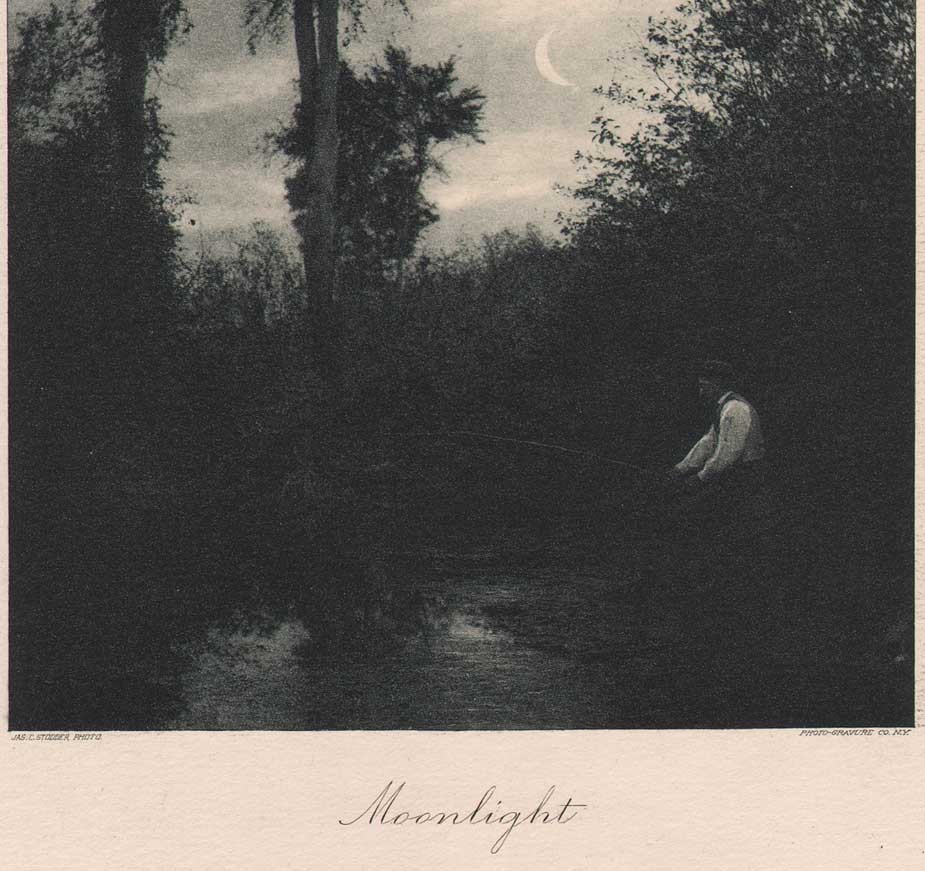 Detail: “Moonlight”: James C. Stodder, American: (1838-1917). 1890. Hand-pulled photogravure published in periodical "Sun & Shade”, New York: November, 1890: whole #27: N.Y. Photogravure Co.: 18.3 x 11.9 | 35.0 x 27.4 cm. A crescent moon rises above a wooded landscape at dusk while a gentleman fishes from the banks of a pond or stream. Stodder graduated from Rensselaer Polytechnic Institute in 1859 and moved to Bangor, Maine, where he first learned the wet-plate process of photography. A lawyer, he was son of a Boston jeweler, (obit) and financially well off. In 1876, he accompanied famed Hudson River School painter Frederic E. Church to the Mount Katahdin region of Maine. From: PhotoSeed Archive
Detail: “Moonlight”: James C. Stodder, American: (1838-1917). 1890. Hand-pulled photogravure published in periodical "Sun & Shade”, New York: November, 1890: whole #27: N.Y. Photogravure Co.: 18.3 x 11.9 | 35.0 x 27.4 cm. A crescent moon rises above a wooded landscape at dusk while a gentleman fishes from the banks of a pond or stream. Stodder graduated from Rensselaer Polytechnic Institute in 1859 and moved to Bangor, Maine, where he first learned the wet-plate process of photography. A lawyer, he was son of a Boston jeweler, (obit) and financially well off. In 1876, he accompanied famed Hudson River School painter Frederic E. Church to the Mount Katahdin region of Maine. From: PhotoSeed Archive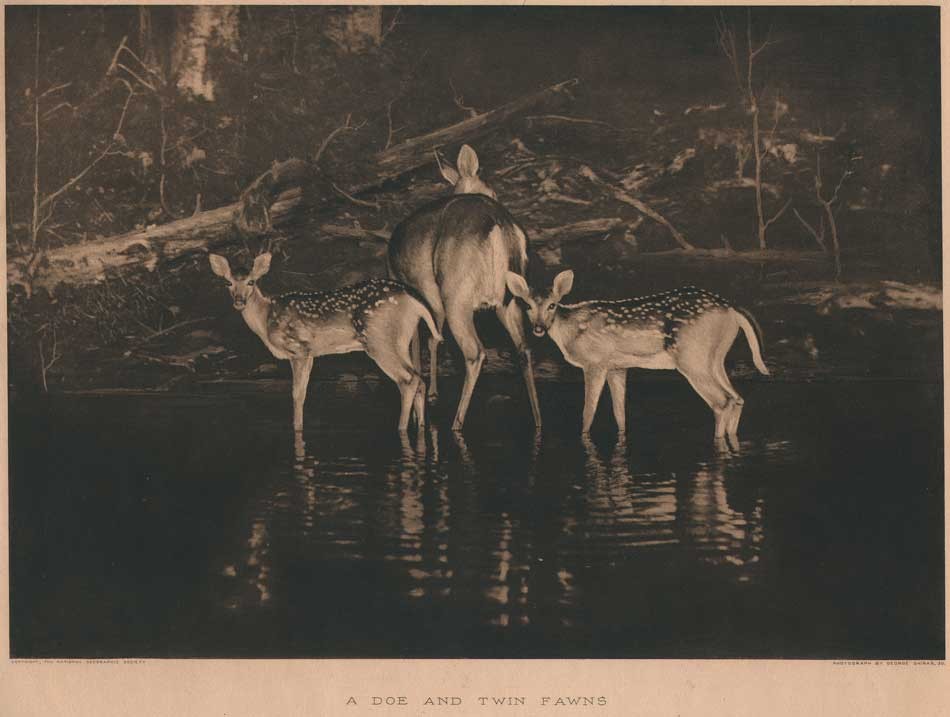 “A Doe and Twin Fawns” (taken 1896) 1916: George Shiras 3rd, American (1859-1942) Vintage photogravure published by the National Geographic Society, Washington, D.C. : 21.2 x 30.3 | 40.5 x 50.8 cm. A pioneer of using flashlight photography to record wildlife in their natural environments at night, Shiras used the method of “Jacklighting”, a form of hunting using a fixed continuous light source mounted in the bow of a canoe to draw the attention of wildlife: in this case three deer, while then utilizing magnesium flash-powder to freeze the scene in-camera. His series of twelve midnight views, including “A Doe and Twin Fawns”-also known as “Innocents Abroad” would earn Shiras international acclaim and many important awards. A one-term Congressman for the state of Michigan, (his father George Shiras Sr. was a former Justice of the U.S. Supreme Court) he was also an important naturalist who helped placed migratory birds and fish under Federal control. (The eventual 1918 Migratory Bird Treaty Act had groundings in legislation Shiras introduced to Congress in 1903 as the first comprehensive migratory bird law not voted on.) For additional background, see article by Matthew Brower in the journal History of Photography, Summer,2008: “George Shiras and the Circulation of Wildlife Photography”. From: PhotoSeed Archive
“A Doe and Twin Fawns” (taken 1896) 1916: George Shiras 3rd, American (1859-1942) Vintage photogravure published by the National Geographic Society, Washington, D.C. : 21.2 x 30.3 | 40.5 x 50.8 cm. A pioneer of using flashlight photography to record wildlife in their natural environments at night, Shiras used the method of “Jacklighting”, a form of hunting using a fixed continuous light source mounted in the bow of a canoe to draw the attention of wildlife: in this case three deer, while then utilizing magnesium flash-powder to freeze the scene in-camera. His series of twelve midnight views, including “A Doe and Twin Fawns”-also known as “Innocents Abroad” would earn Shiras international acclaim and many important awards. A one-term Congressman for the state of Michigan, (his father George Shiras Sr. was a former Justice of the U.S. Supreme Court) he was also an important naturalist who helped placed migratory birds and fish under Federal control. (The eventual 1918 Migratory Bird Treaty Act had groundings in legislation Shiras introduced to Congress in 1903 as the first comprehensive migratory bird law not voted on.) For additional background, see article by Matthew Brower in the journal History of Photography, Summer,2008: “George Shiras and the Circulation of Wildlife Photography”. From: PhotoSeed Archive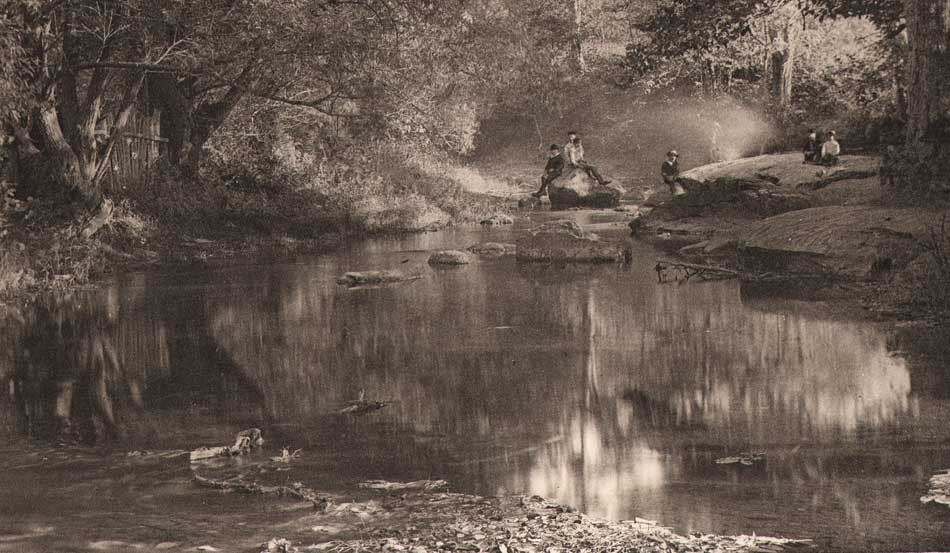 Detail: “A Corn Roast” Oliver Patterson Watts, American: (1865-1953). 1892. Hand-pulled photogravure published in periodical "Sun & Shade”, New York: June, 1892: whole #46: N.Y. Photogravure Co.: 14.7 x 23.2 | 34.6 x 27.4 cm. The index for the issue of Sun & Shade in which this photograph appears states: “Mr. Watts writes us that while wandering with his camera along “The Green,” a favorite picnic ground near Thomastown,(sic) Maine, he came upon this group of boys roasting corn and potatoes. At the sight of the camera they immediately grouped themselves, anxious to be “took.” The negative was made with a Scovill Favorite Camera, Waterbury lens, with an exposure of five seconds on a seed plate. It was developed with Pyro and Sodium Carbonate.” Dr. Oliver Patterson Watts was born in Thomaston, Maine, and graduated from Bowdoin College in 1889. Interestingly, in 1890, Potts and Dr. Julius Stieglitz, the brother of Alfred Stieglitz, were fellow scholars in chemistry at the newly opened Clark University in Worcester, MA. He later entered the University of Wisconsin in 1905 and took charge of the Carnegie Research on Electrolytic Iron under Dr. Charles F. Burgess. According to an Oct. 2009 article on Potts for the online resource Plating & Surface Finishing, the most important of his fifty-nine papers on plating and corrosion is probably “Rapid Nickel Plating,” presented before the Electrochemical Society in 1915. From: PhotoSeed Archive
Detail: “A Corn Roast” Oliver Patterson Watts, American: (1865-1953). 1892. Hand-pulled photogravure published in periodical "Sun & Shade”, New York: June, 1892: whole #46: N.Y. Photogravure Co.: 14.7 x 23.2 | 34.6 x 27.4 cm. The index for the issue of Sun & Shade in which this photograph appears states: “Mr. Watts writes us that while wandering with his camera along “The Green,” a favorite picnic ground near Thomastown,(sic) Maine, he came upon this group of boys roasting corn and potatoes. At the sight of the camera they immediately grouped themselves, anxious to be “took.” The negative was made with a Scovill Favorite Camera, Waterbury lens, with an exposure of five seconds on a seed plate. It was developed with Pyro and Sodium Carbonate.” Dr. Oliver Patterson Watts was born in Thomaston, Maine, and graduated from Bowdoin College in 1889. Interestingly, in 1890, Potts and Dr. Julius Stieglitz, the brother of Alfred Stieglitz, were fellow scholars in chemistry at the newly opened Clark University in Worcester, MA. He later entered the University of Wisconsin in 1905 and took charge of the Carnegie Research on Electrolytic Iron under Dr. Charles F. Burgess. According to an Oct. 2009 article on Potts for the online resource Plating & Surface Finishing, the most important of his fifty-nine papers on plating and corrosion is probably “Rapid Nickel Plating,” presented before the Electrochemical Society in 1915. From: PhotoSeed Archive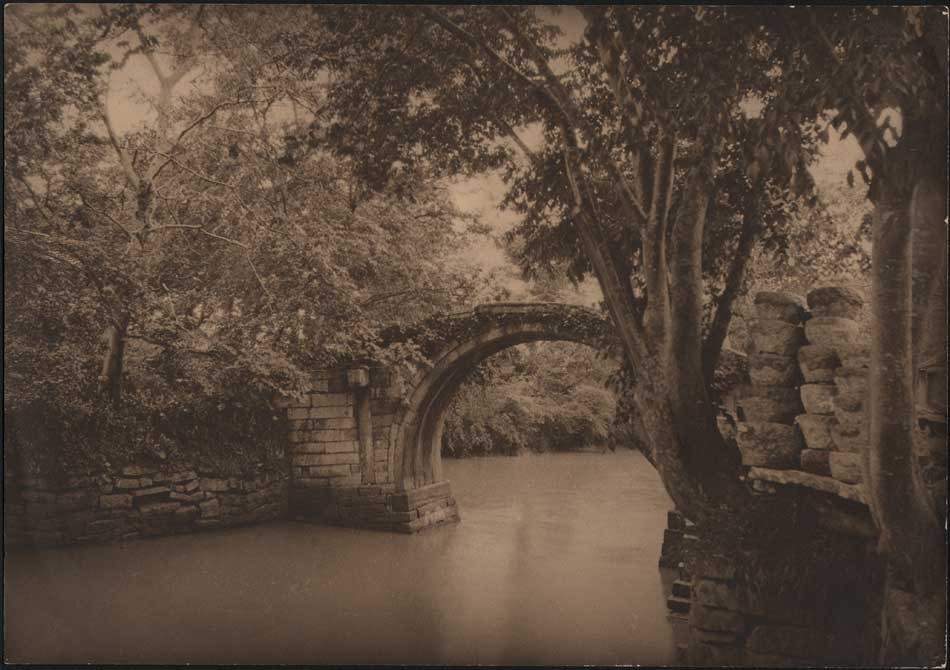 “Mutu Bridge”: Donald Mennie, Scottish (1875-1944) 1922: Vintage unmounted bromide print: 24.2 x 34.6 cm. This picturesque Chinese river scene first appeared as a full-page plate variant in the 1914 volume “My Lady of the Chinese Courtyard” (between pp. 254-5) by author Elizabeth Cooper and then as Plate #7 “Mutu Bridge” in the photographer’s ca. 1914 work “Picturesque China: A Series of Vandyck Photogravures illustrating Chinese Life and Surroundings”. From: PhotoSeed Archive
“Mutu Bridge”: Donald Mennie, Scottish (1875-1944) 1922: Vintage unmounted bromide print: 24.2 x 34.6 cm. This picturesque Chinese river scene first appeared as a full-page plate variant in the 1914 volume “My Lady of the Chinese Courtyard” (between pp. 254-5) by author Elizabeth Cooper and then as Plate #7 “Mutu Bridge” in the photographer’s ca. 1914 work “Picturesque China: A Series of Vandyck Photogravures illustrating Chinese Life and Surroundings”. From: PhotoSeed Archive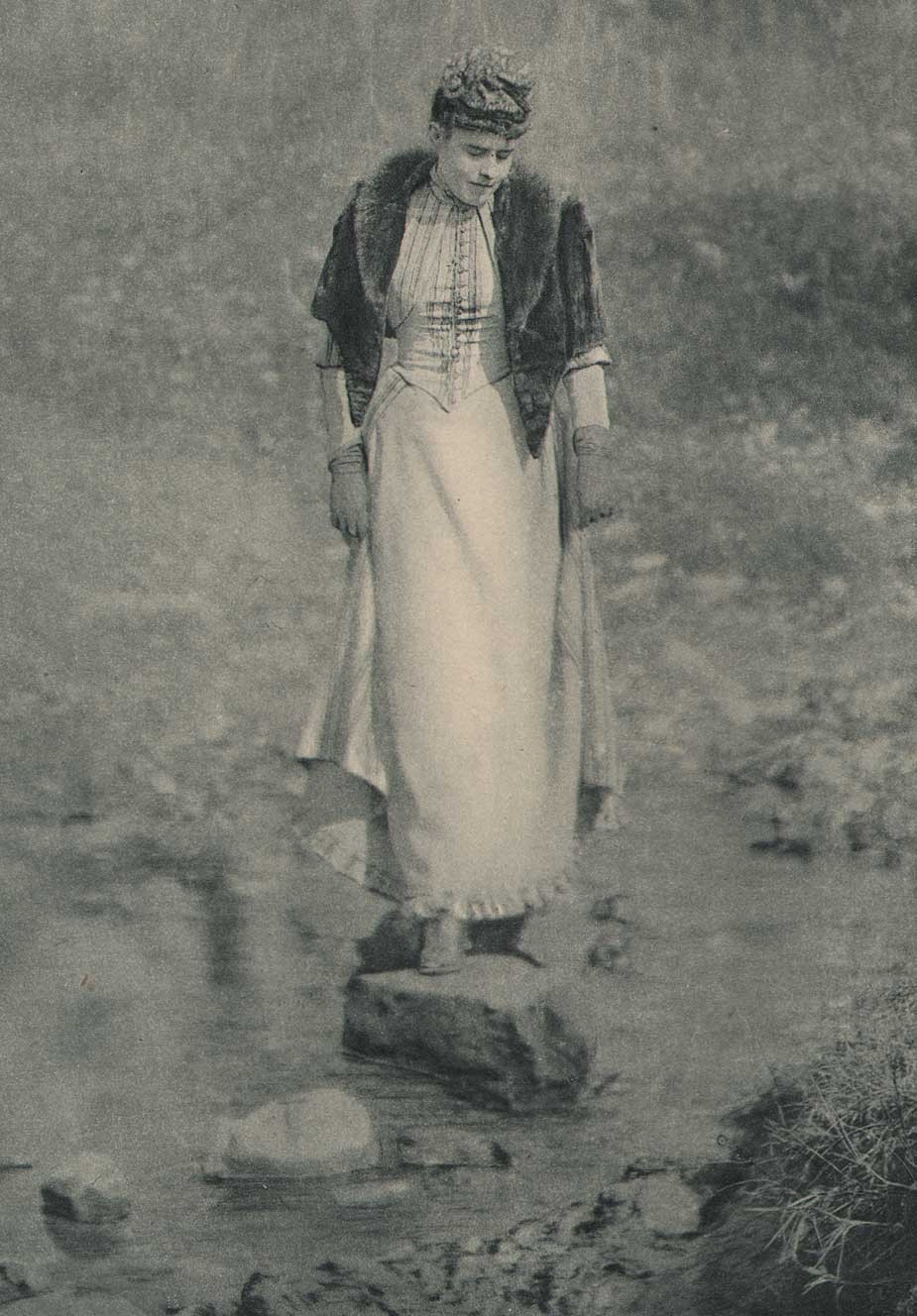 Detail: “Stepping Stones” George Bacon Wood Jr., American: (1832-1909). 1894. Hand-pulled photogravure published in periodical "Sun & Shade”, New York: January, 1894: whole #65: N.Y. Photogravure Co.: 20.5 x 11.7 | 34.9 x 27.5 cm. The index for the issue of Sun & Shade in which this photograph appears states: “To the meditative woman crossing the brook with careful steps upon the projecting stones, Oliver Wendell Holmes’ words, in his “Professor at the Breakfast Table,” can be appropriately applied: “The wisest woman you talk with is ignorant of something that you know, but an elegant woman never forgets her elegance.” With no eye to see her, as she crosses the woodland stream, the figure in the picture appears reposeful, full of thought, and unconsciously elegant in pose. This is a charming photograph from nature, simple, truthful and artistic.” From: PhotoSeed Archive
Detail: “Stepping Stones” George Bacon Wood Jr., American: (1832-1909). 1894. Hand-pulled photogravure published in periodical "Sun & Shade”, New York: January, 1894: whole #65: N.Y. Photogravure Co.: 20.5 x 11.7 | 34.9 x 27.5 cm. The index for the issue of Sun & Shade in which this photograph appears states: “To the meditative woman crossing the brook with careful steps upon the projecting stones, Oliver Wendell Holmes’ words, in his “Professor at the Breakfast Table,” can be appropriately applied: “The wisest woman you talk with is ignorant of something that you know, but an elegant woman never forgets her elegance.” With no eye to see her, as she crosses the woodland stream, the figure in the picture appears reposeful, full of thought, and unconsciously elegant in pose. This is a charming photograph from nature, simple, truthful and artistic.” From: PhotoSeed Archive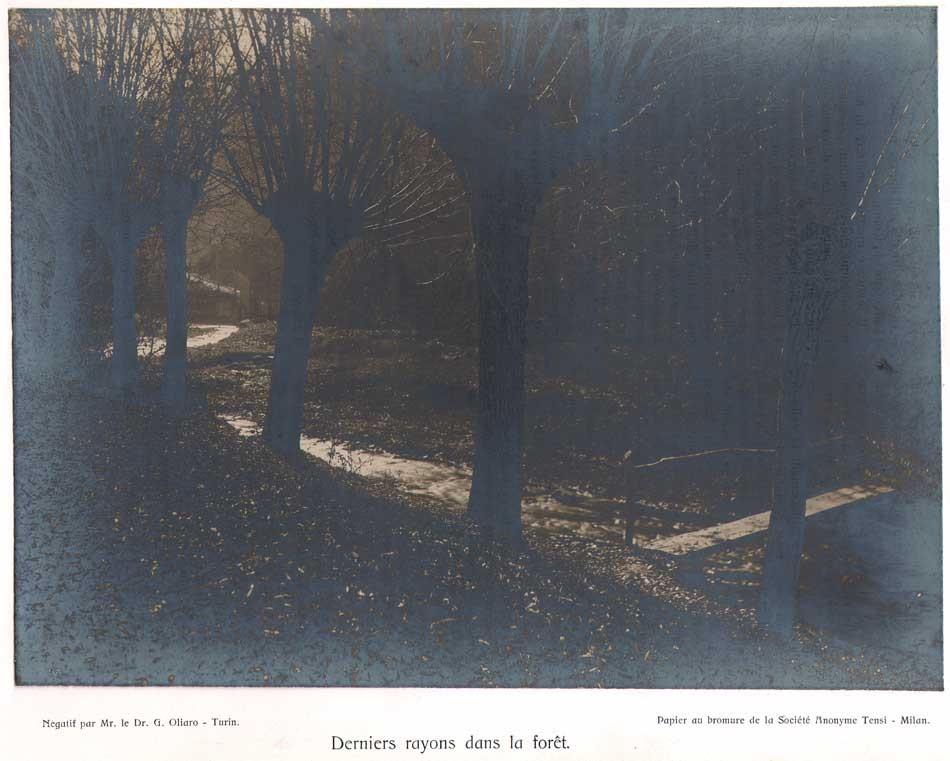 “Derniers Rayons Dans la Forêt”: Guglielmo Oliaro, Italian: (1874 -1936) vintage Bromide photograph, ca. 1900? 1907: 16.6 x 22.5 | 23.5 x 32.7 cm. Translating to “Last Rays In The Forest”, this bucolic scene at dusk features a rushing stream and footbridge bisecting a a silhouetted line of Pollarded Willow trees. From Turin, amateur photographer Dr. Guglielmo Oliaro was very interested in the arts, founding a medical publishing house that survives to this day: From the InterFairs online resource: “Minerva Medica was the brainchild of a Turin GP (General Practitioner -ed.) Dr. Guglielmo Oliaro, a scientist with a passion for literature, art and music. It was on December 8 1925 that Dr. Oliaro got together with a small group of partners to set up the original company, Tipografia Editrice Minerva based in Turin. The creation of that company was a response to the growing success both in Italy and abroad, of Minerva Medica, a weekly journal for the general practitioner that first came out in 1909. Edizioni Minerva Medica S.p.A. was set up as a limited company by Dr. Guglielmo Oliaro on June 9 1934, for the purpose of supplying the Italian medical profession with text-books and scientific journals.” This example of Oliaro’s work was printed by the Milan atelier Maison Tensi and included as a full-page plate in the April, 1907 issue of “La Fotographia Artistica”, a French/Italian photographic journal. From: PhotoSeed Archive
“Derniers Rayons Dans la Forêt”: Guglielmo Oliaro, Italian: (1874 -1936) vintage Bromide photograph, ca. 1900? 1907: 16.6 x 22.5 | 23.5 x 32.7 cm. Translating to “Last Rays In The Forest”, this bucolic scene at dusk features a rushing stream and footbridge bisecting a a silhouetted line of Pollarded Willow trees. From Turin, amateur photographer Dr. Guglielmo Oliaro was very interested in the arts, founding a medical publishing house that survives to this day: From the InterFairs online resource: “Minerva Medica was the brainchild of a Turin GP (General Practitioner -ed.) Dr. Guglielmo Oliaro, a scientist with a passion for literature, art and music. It was on December 8 1925 that Dr. Oliaro got together with a small group of partners to set up the original company, Tipografia Editrice Minerva based in Turin. The creation of that company was a response to the growing success both in Italy and abroad, of Minerva Medica, a weekly journal for the general practitioner that first came out in 1909. Edizioni Minerva Medica S.p.A. was set up as a limited company by Dr. Guglielmo Oliaro on June 9 1934, for the purpose of supplying the Italian medical profession with text-books and scientific journals.” This example of Oliaro’s work was printed by the Milan atelier Maison Tensi and included as a full-page plate in the April, 1907 issue of “La Fotographia Artistica”, a French/Italian photographic journal. From: PhotoSeed Archive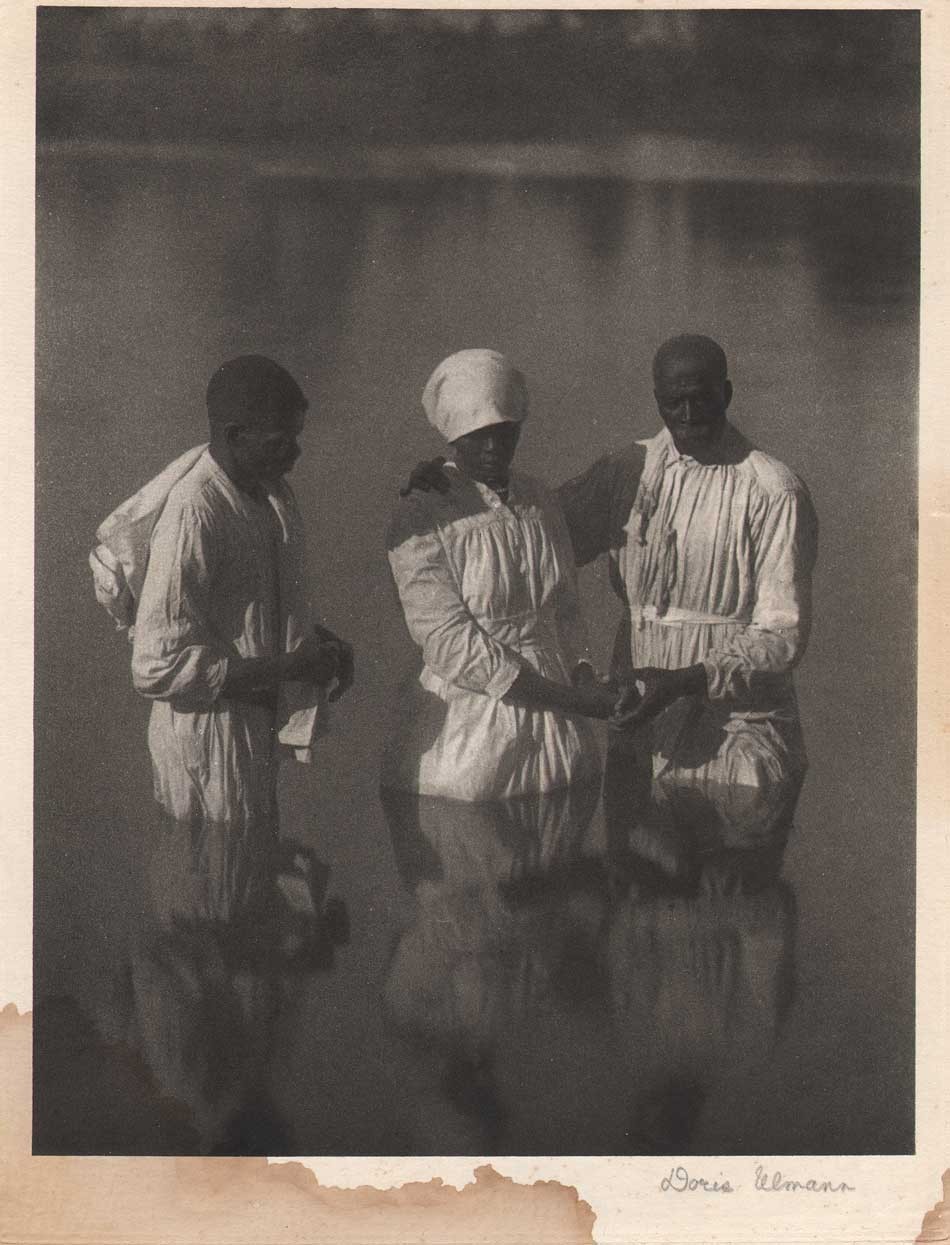 “Baptismal Scene” : Doris Ulmann, American: (1882 –1934) 1933: Signed, hand-pulled photogravure included as additional loose plate from deluxe edition of “Roll, Jordan, Roll”: 21.3 x 16.4 | 28.3 x 20.7 cm. In a rather interesting coincidence, this particular example of a summer stream showing a well-known river baptism by Ulmann has been partially immersed by moisture along the lower margin. From p. 116 of the volume: “A candidate for admission into the church must first be baptized. The Methodists have water sprinkled on their heads, but Baptists must be publicly immersed. These “baptisms” attract large crowds of onlookers. The candidates all arrive at the “pool” dressed in long white robes, which are carefully put away after the ceremony to serve as their shrouds some day. When they are assembled, the preacher and the leader, also dressed in white robes, lead the first candidate down into the water, where he is dipped three times, once in the name of the Father, once in the name of the Son, and once in the name of the Holy Ghost. As he is lead up out of the water, all his sins are left behind, drowned and buried in a watery grave. His soul is cleansed white as snow and he is ready to be received into full church membership. Unless he “falls” into sin and gets “turned out” of the church, he will some day be received into fellowship with God’s holy angels up in heaven.” The following review of Roll, Jordon, Roll comes from Steve Watson and was included on the Amon Carter Museum of American Art website, first published in 2016: Photographer Doris Ulmann came from an affluent white New York City family. She took teacher training with photographer Lewis Hine at the Ethical Culture School and subsequently studied psychology and law at Columbia University. She also studied photography with Clarence H. White, a founding member of the Photo-Secession movement known for teaching the Pictorialist style. Ulmann collaborated with novelist Julia Peterkin on a book project titled Roll, Jordan, Roll(New York: R.O. Ballou, 1933). The book focuses on the lives of former slaves and their descendants on a plantation in the Gullah coastal region of South Carolina. Peterkin, who won the Pulitzer Prize for her novel Scarlet Sister Mary (Indianapolis: Bobbs-Merrill, 1928), was born in South Carolina and raised by a black nursemaid who taught her the Gullah dialect. She married the heir to Lang Syne, a 2,000-acre cotton plantation, which became the setting for Roll, Jordan, Roll. Ulmann began photographing there in 1929. Roll, Jordan, Roll is titled after the spiritual written by English Methodist leader Charles Wesley in the 18th century which became well-known among slaves in the United States during the 19th century. Appropriated as a coded message for escape, by the end of the American Civil War it had become known through much of the eastern United States. In the 20th century it helped inspire the blues, and it remains a staple in gospel music. Roll, Jordan, Roll was illustrated with 90 photogravure plates made from Ulmann’s large-format negatives. Although they comprise an amazing ethnographic study, today Ulmann’s Pictorialist aesthetic seems a strange choice for making documentary images. The hazy, soft-focus photographs lend a sentimental, nostalgic impression that belies the underlying exploitative history of her subjects. From: PhotoSeed Archive
“Baptismal Scene” : Doris Ulmann, American: (1882 –1934) 1933: Signed, hand-pulled photogravure included as additional loose plate from deluxe edition of “Roll, Jordan, Roll”: 21.3 x 16.4 | 28.3 x 20.7 cm. In a rather interesting coincidence, this particular example of a summer stream showing a well-known river baptism by Ulmann has been partially immersed by moisture along the lower margin. From p. 116 of the volume: “A candidate for admission into the church must first be baptized. The Methodists have water sprinkled on their heads, but Baptists must be publicly immersed. These “baptisms” attract large crowds of onlookers. The candidates all arrive at the “pool” dressed in long white robes, which are carefully put away after the ceremony to serve as their shrouds some day. When they are assembled, the preacher and the leader, also dressed in white robes, lead the first candidate down into the water, where he is dipped three times, once in the name of the Father, once in the name of the Son, and once in the name of the Holy Ghost. As he is lead up out of the water, all his sins are left behind, drowned and buried in a watery grave. His soul is cleansed white as snow and he is ready to be received into full church membership. Unless he “falls” into sin and gets “turned out” of the church, he will some day be received into fellowship with God’s holy angels up in heaven.” The following review of Roll, Jordon, Roll comes from Steve Watson and was included on the Amon Carter Museum of American Art website, first published in 2016: Photographer Doris Ulmann came from an affluent white New York City family. She took teacher training with photographer Lewis Hine at the Ethical Culture School and subsequently studied psychology and law at Columbia University. She also studied photography with Clarence H. White, a founding member of the Photo-Secession movement known for teaching the Pictorialist style. Ulmann collaborated with novelist Julia Peterkin on a book project titled Roll, Jordan, Roll(New York: R.O. Ballou, 1933). The book focuses on the lives of former slaves and their descendants on a plantation in the Gullah coastal region of South Carolina. Peterkin, who won the Pulitzer Prize for her novel Scarlet Sister Mary (Indianapolis: Bobbs-Merrill, 1928), was born in South Carolina and raised by a black nursemaid who taught her the Gullah dialect. She married the heir to Lang Syne, a 2,000-acre cotton plantation, which became the setting for Roll, Jordan, Roll. Ulmann began photographing there in 1929. Roll, Jordan, Roll is titled after the spiritual written by English Methodist leader Charles Wesley in the 18th century which became well-known among slaves in the United States during the 19th century. Appropriated as a coded message for escape, by the end of the American Civil War it had become known through much of the eastern United States. In the 20th century it helped inspire the blues, and it remains a staple in gospel music. Roll, Jordan, Roll was illustrated with 90 photogravure plates made from Ulmann’s large-format negatives. Although they comprise an amazing ethnographic study, today Ulmann’s Pictorialist aesthetic seems a strange choice for making documentary images. The hazy, soft-focus photographs lend a sentimental, nostalgic impression that belies the underlying exploitative history of her subjects. From: PhotoSeed Archive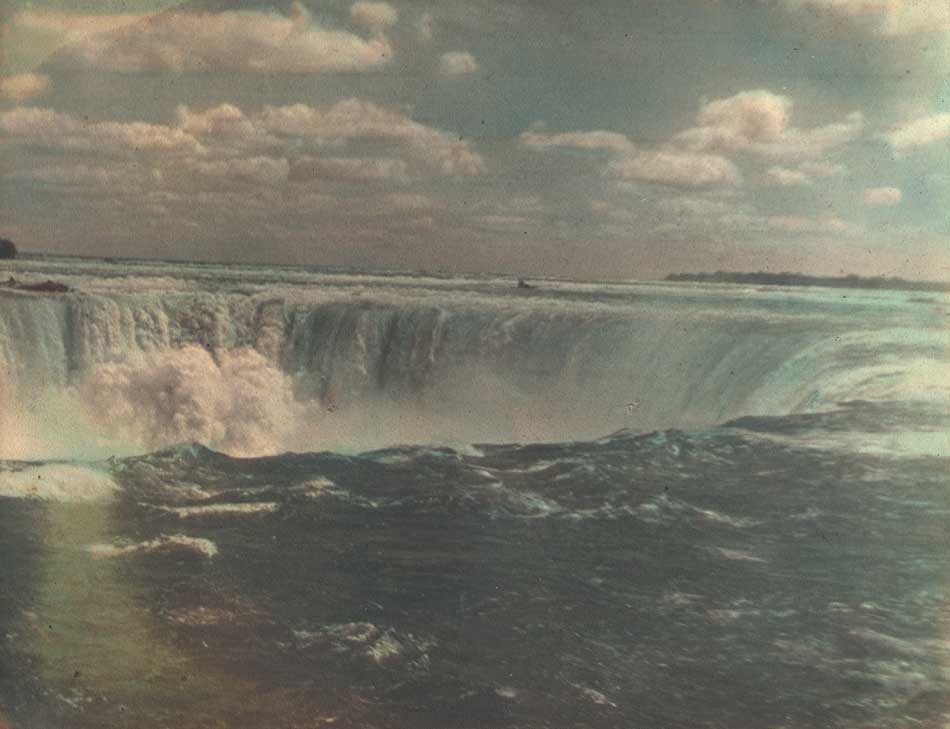 “Niagara Falls”: attributed to Arthur Hammond, American: born England: 1880-1962: hand-colored gelatin silver print mounted to album leaf, ca. 1930-1940: 19.2 x 24.2 | 25.0 x 32.7 cm. To conclude our post is a view of the ultimate Summer Stream: a view showing the Niagara River’s Horseshoe Falls from the Canadian side. From a personal album of nearly 100 photographs attributed to Hammond dating from around 1910-1940. Born in London, photographer Arthur Hammond arrived in America at Ellis Island in New York Harbor on July 31, 1909 and established himself with his own studio in Natick, MA outside Boston by 1912. In 1920, he authored the foundational book "Pictorial Composition in Photography" and became a leading voice for pictorialism in America through his position as associate editor of American Photography magazine that lasted 30 years from 1918-1949. From: PhotoSeed Archive
“Niagara Falls”: attributed to Arthur Hammond, American: born England: 1880-1962: hand-colored gelatin silver print mounted to album leaf, ca. 1930-1940: 19.2 x 24.2 | 25.0 x 32.7 cm. To conclude our post is a view of the ultimate Summer Stream: a view showing the Niagara River’s Horseshoe Falls from the Canadian side. From a personal album of nearly 100 photographs attributed to Hammond dating from around 1910-1940. Born in London, photographer Arthur Hammond arrived in America at Ellis Island in New York Harbor on July 31, 1909 and established himself with his own studio in Natick, MA outside Boston by 1912. In 1920, he authored the foundational book "Pictorial Composition in Photography" and became a leading voice for pictorialism in America through his position as associate editor of American Photography magazine that lasted 30 years from 1918-1949. From: PhotoSeed Archive
By the Stream
Paul Laurence Dunbar (1872-1906)
By the stream I dream in calm delight, and watch as in a glass,
How the clouds like crowds of snowy-hued and white-robed
maidens pass,
And the water into ripples breaks and sparkles as it spreads,
Like a host of armored knights with silver helmets on their heads.
And I deem the stream an emblem fit of human life may go,
For I find a mind may sparkle much and yet but shallows show,
And a soul may glow with myriad lights and wondrous mysteries,
When it only lies a dormant thing and mirrors what it sees.
Goodbye, Sagamore Farm
Posted October 2018 in Alternate Processes, Childhood Photography, New Additions, Painters|Photographers, Scientific Photography
I recently trekked to the New Hampshire seacoast to investigate the origins of two cyanotype photogram albums recently posted to this site. There, botanical specimens gathered by Helen Chase Gage when she was a child on her family’s country estate known as “Sagamore Farm” in Rye, New Hampshire were compiled during the summer months of 1929 and 1930.
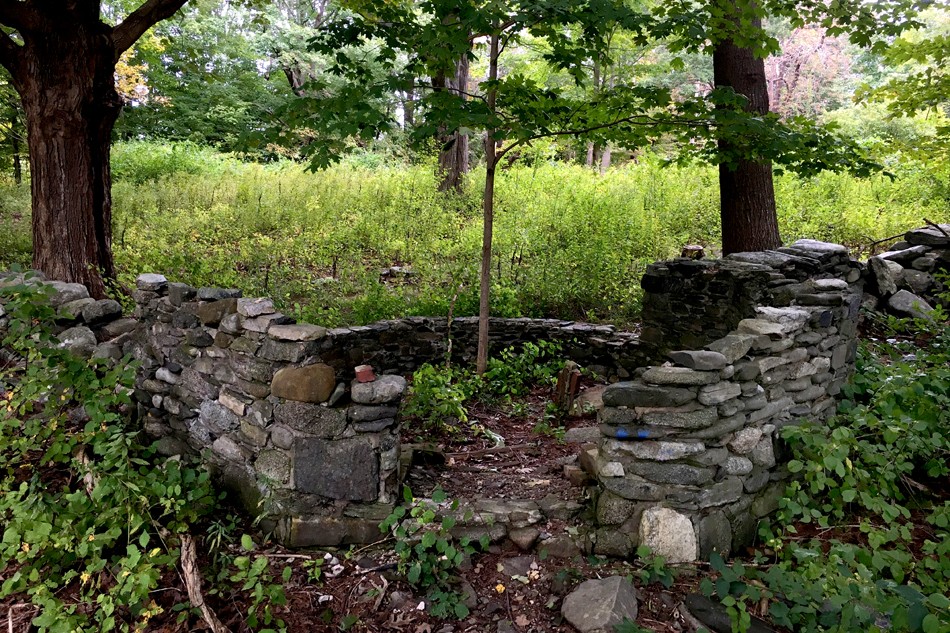 At Odiorne Point State Park in Rye, New Hampshire, remnants of foundation walls belonging to "Sagamore Farm" can be seen in this view looking west towards the seacoast photographed October 1, 2018. Helen Chase Gage (Miller) 1917-1982 was a schoolgirl when she roamed near here during the summers of 1929 & 1930 collecting botanical specimens used to make two albums of cyanotype photographs. The estate, a grand sixteen-room summer home built in 1892 by Dr. William Duncan McKim, (1855-1935) was purchased by Helen's parents in 1918 and eventually condemned and demolished by the US Federal Government in 1942 with other homes in order to build Fort Dearborn, which provided a coastal defense for the United States on the Atlantic seaboard during and after the World War II era. Photo by David Spencer for PhotoSeed Archive.
At Odiorne Point State Park in Rye, New Hampshire, remnants of foundation walls belonging to "Sagamore Farm" can be seen in this view looking west towards the seacoast photographed October 1, 2018. Helen Chase Gage (Miller) 1917-1982 was a schoolgirl when she roamed near here during the summers of 1929 & 1930 collecting botanical specimens used to make two albums of cyanotype photographs. The estate, a grand sixteen-room summer home built in 1892 by Dr. William Duncan McKim, (1855-1935) was purchased by Helen's parents in 1918 and eventually condemned and demolished by the US Federal Government in 1942 with other homes in order to build Fort Dearborn, which provided a coastal defense for the United States on the Atlantic seaboard during and after the World War II era. Photo by David Spencer for PhotoSeed Archive.
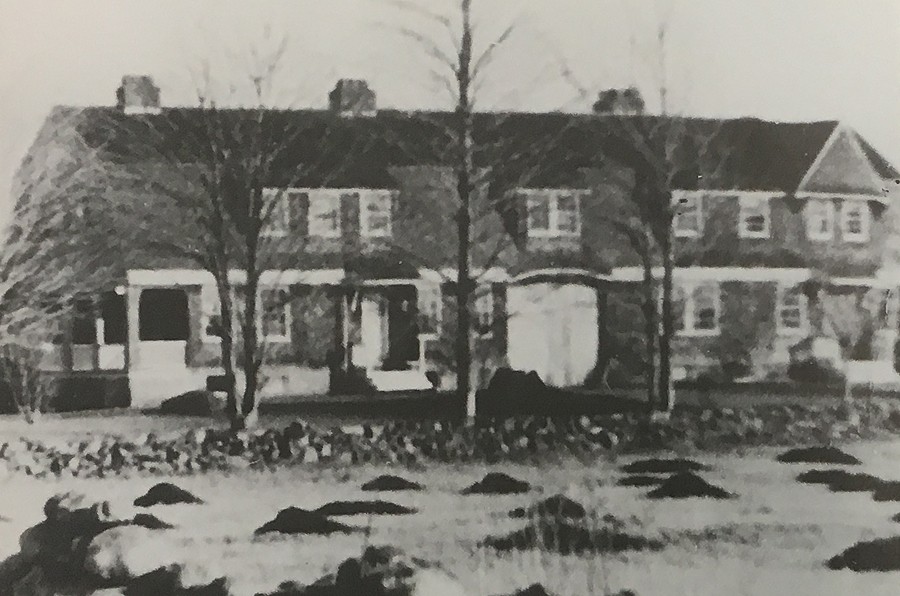 A surviving photograph of "Sagamore Farm" located in Rye New Hampshire, the summer country home where schoolgirl photographer Helen Chase Gage made her cyanotype albums during the summers of 1929-30. A sixteen-room home originally built in 1892 by Dr. William Duncan McKim, (1855-1935) it's described in the 1994 volume Footprints in Time: A Walk where New Hampshire Began as: "This was a large house with two matching sides separated by a porte cochere (a carriage drive-through) which went through the house to the large barn behind." Notice the stone wall in front of the home, indicating the presence of farm fields that criss-crossed the future Odiorne Point State Park property. Photo courtesy Seacoast Science Center.
A surviving photograph of "Sagamore Farm" located in Rye New Hampshire, the summer country home where schoolgirl photographer Helen Chase Gage made her cyanotype albums during the summers of 1929-30. A sixteen-room home originally built in 1892 by Dr. William Duncan McKim, (1855-1935) it's described in the 1994 volume Footprints in Time: A Walk where New Hampshire Began as: "This was a large house with two matching sides separated by a porte cochere (a carriage drive-through) which went through the house to the large barn behind." Notice the stone wall in front of the home, indicating the presence of farm fields that criss-crossed the future Odiorne Point State Park property. Photo courtesy Seacoast Science Center.
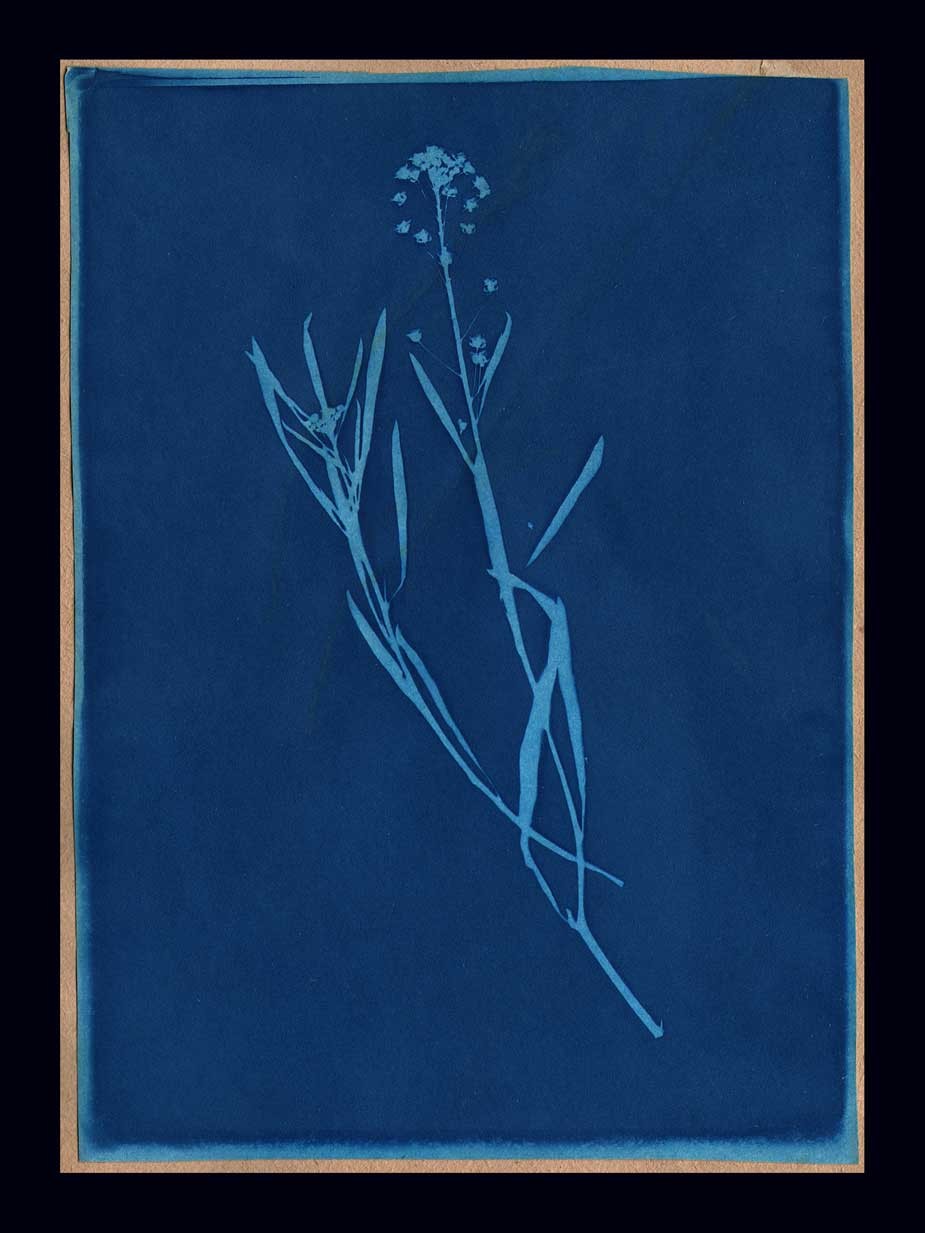 "Sweet Alyssum" (Lobularia maritima) Helen Chase Gage- American: 1917-1982; Cyanotype: 1930: (18.0 x 12.9 | 21.6 x 14.6 cm) Inscribed on opposite album page: Sweet Alyssum Blue Print made August 17, 1930 At Sagamore Farm, N.H. By Helen C. Gage. From: PhotoSeed Archive
"Sweet Alyssum" (Lobularia maritima) Helen Chase Gage- American: 1917-1982; Cyanotype: 1930: (18.0 x 12.9 | 21.6 x 14.6 cm) Inscribed on opposite album page: Sweet Alyssum Blue Print made August 17, 1930 At Sagamore Farm, N.H. By Helen C. Gage. From: PhotoSeed Archive
Known today as Odiorne Point State Park, Helen’s family summer home was located on land at Frost Point at the mouth of the Piscataqua River and Gulf of Maine. In 1942 during World War II, the US federal government appropriated nearly 265 acres making up the future park boundaries through eminent domain, including the Sagamore Farm estate and other properties owned by 24 families. (11 homes are said to have been demolished) This was done in order to build Fort Dearborn, a coastal outpost manned by large gun emplacements designed to protect the nearby Portsmouth Naval Ship Yard on the Piscataqua.
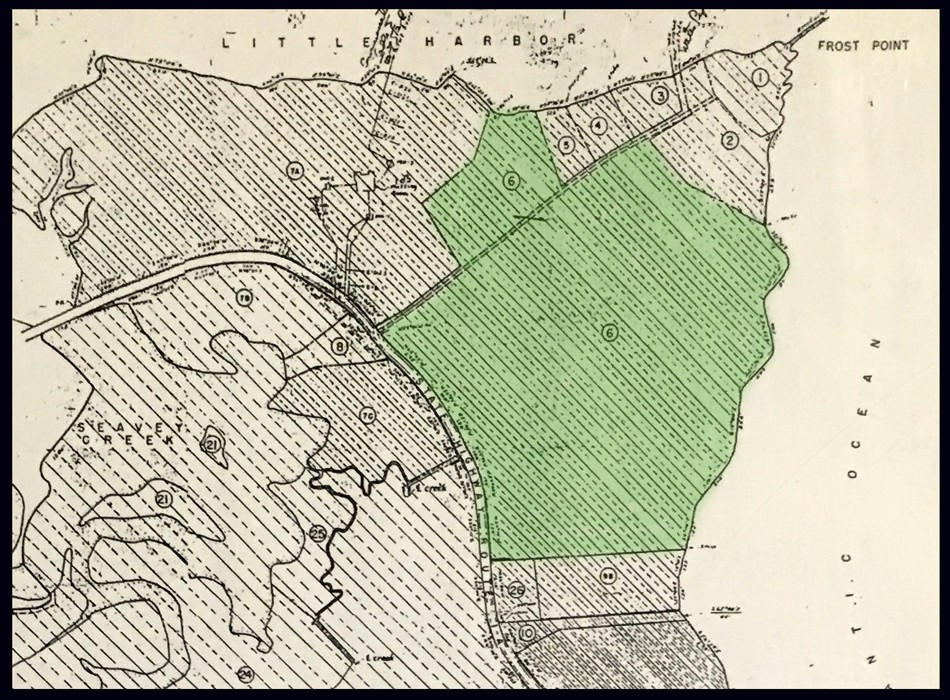 This ca. 1942 US War Department map shows the future area of Odiorne Point State Park in Rye, New Hampshire. Using the color green, this website has shaded the parcel belonging to photographer Helen Chase Gage's family- 43.6 acres. The US Government appropriated nearly 265 acres owned by 24 families through eminent domain in order to build Fort Dearborn, which took three years to complete. Graphic courtesy Seacoast Science Center.
This ca. 1942 US War Department map shows the future area of Odiorne Point State Park in Rye, New Hampshire. Using the color green, this website has shaded the parcel belonging to photographer Helen Chase Gage's family- 43.6 acres. The US Government appropriated nearly 265 acres owned by 24 families through eminent domain in order to build Fort Dearborn, which took three years to complete. Graphic courtesy Seacoast Science Center.
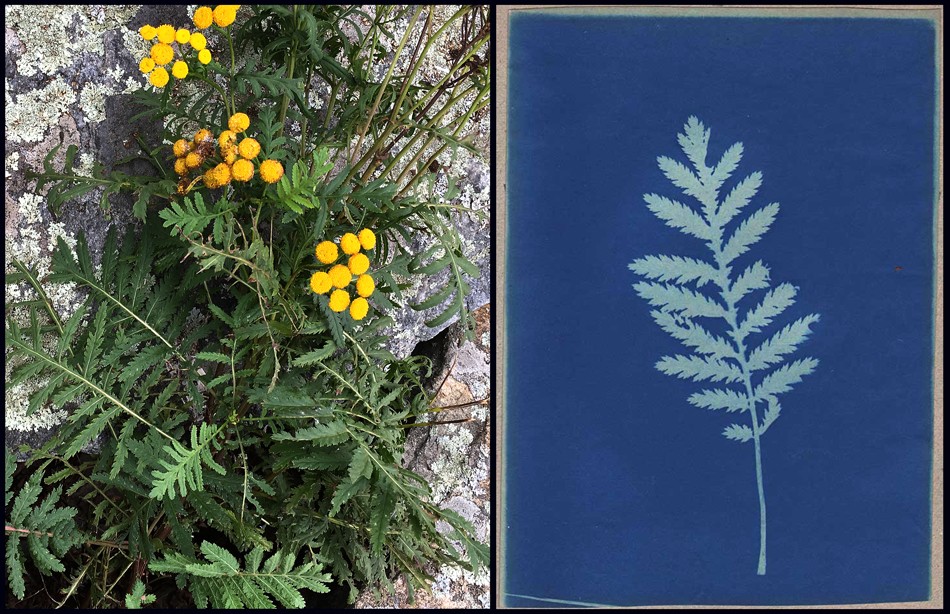 Left: Tansy flowers in bloom at Odiorne Point State Park in Rye, New Hampshire photographed October 1, 2018. Photo by David Spencer for PhotoSeed Archive. Right: "Tansy" (Tanacetum vulgare) Helen Chase Gage- American: 1917-1982; Cyanotype: 1929: (17.6 x 12.5 | 30.0 x 22.8 cm) Inscribed on same album page: Tansy: Blue Print made on July 17, 1929 at Sagamore Farm By Helen C. Gage. From: PhotoSeed Archive
Left: Tansy flowers in bloom at Odiorne Point State Park in Rye, New Hampshire photographed October 1, 2018. Photo by David Spencer for PhotoSeed Archive. Right: "Tansy" (Tanacetum vulgare) Helen Chase Gage- American: 1917-1982; Cyanotype: 1929: (17.6 x 12.5 | 30.0 x 22.8 cm) Inscribed on same album page: Tansy: Blue Print made on July 17, 1929 at Sagamore Farm By Helen C. Gage. From: PhotoSeed Archive
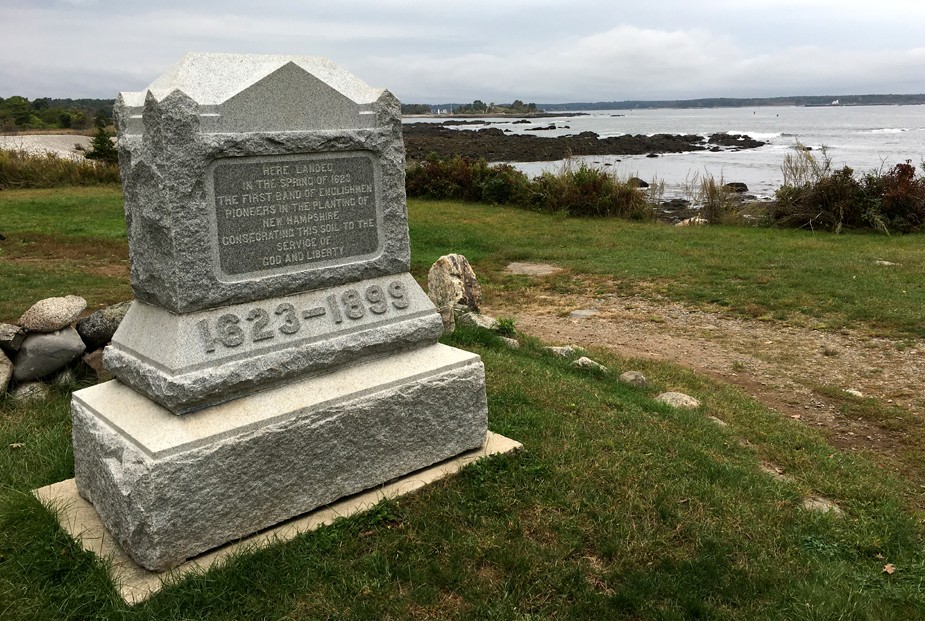 This granite marker on the coastline at Odiorne Point State Park marks the location in the Spring of 1623 where English immigrant David Thomson (1593-1628) of Plymouth, England established the first European settlement on land that would become the future American state of New Hampshire. Originally installed in 1899, the marker was eventually moved but re-installed and re-dedicated in its' original spot in 2007: "Here Landed In the Spring of 1623 The First Band of Englishmen. Pioneers in The Planting of New Hampshire. Consecrating This Soil to The Service of God and Liberty. Photographed on October 1, 2018 by David Spencer for PhotoSeed Archive.
This granite marker on the coastline at Odiorne Point State Park marks the location in the Spring of 1623 where English immigrant David Thomson (1593-1628) of Plymouth, England established the first European settlement on land that would become the future American state of New Hampshire. Originally installed in 1899, the marker was eventually moved but re-installed and re-dedicated in its' original spot in 2007: "Here Landed In the Spring of 1623 The First Band of Englishmen. Pioneers in The Planting of New Hampshire. Consecrating This Soil to The Service of God and Liberty. Photographed on October 1, 2018 by David Spencer for PhotoSeed Archive.The area is rich in American history: at Odiorne Point within the present-day state park, a large granite marker (installed 1899 |rededicated 2007) marks the location in the Spring of 1623 where English immigrant David Thomson (1593-1628) of Plymouth, England established the first European settlement on land that would become the future American state of New Hampshire.
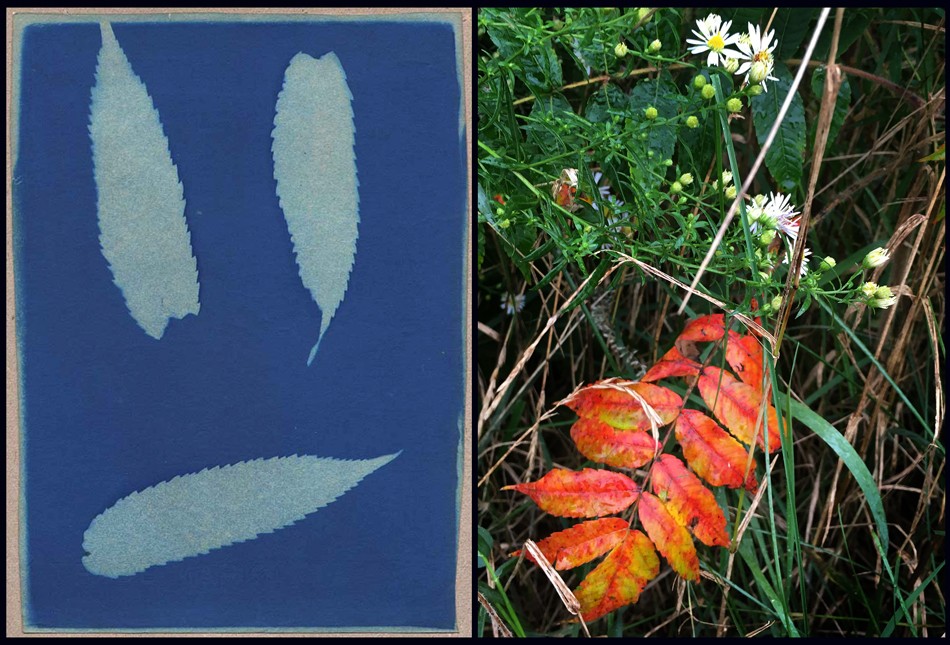 Left: "Sumack" (Rhus coriaria?) Helen Chase Gage- American: 1917-1982; Cyanotype: 1929: (18.0 x 13.0 cm | 21.6 x 14.6 cm) Inscribed on album page: Sumack: Blue Print made on July 23, 1929 at Sagamore Farm By Helen C. Gage. From: PhotoSeed Archive. Right: Sumac leaves from a shrub showing off their fall colors at Odiorne Point State Park in Rye, New Hampshire photographed October 1, 2018. Photo by David Spencer for PhotoSeed Archive.
Left: "Sumack" (Rhus coriaria?) Helen Chase Gage- American: 1917-1982; Cyanotype: 1929: (18.0 x 13.0 cm | 21.6 x 14.6 cm) Inscribed on album page: Sumack: Blue Print made on July 23, 1929 at Sagamore Farm By Helen C. Gage. From: PhotoSeed Archive. Right: Sumac leaves from a shrub showing off their fall colors at Odiorne Point State Park in Rye, New Hampshire photographed October 1, 2018. Photo by David Spencer for PhotoSeed Archive.
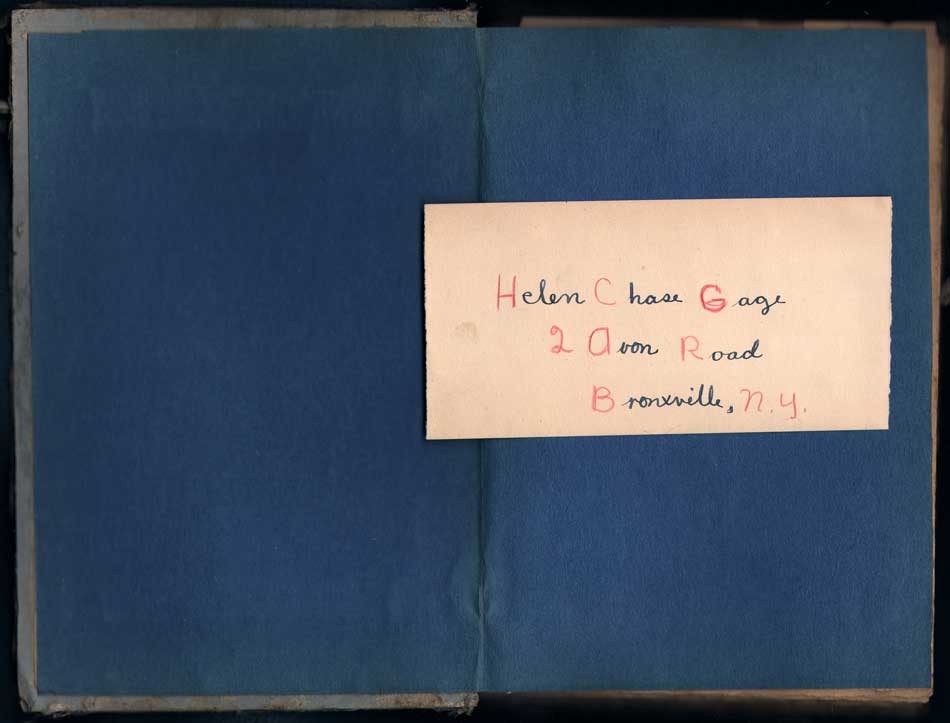 Helen Chase Gage hand-drawn calling card inserted within 1930 Blue Print album of botanical specimen photograms: Helen Chase Gage- American: 1917-1982: This hand-made album is shown opened with the front pastedown made from blue art paper extending full width of opened volume. Overall dimensions: 23.0 x 30.0 cm : Calling card: 7.6 x 15.1 cm. Helen Chase Gage spent her early childhood at 2 Avon Road in Bronxville, New York but assembled this album and another in 1929 at Sagamore Farm in Rye, New Hampshire. From: PhotoSeed Archive
Helen Chase Gage hand-drawn calling card inserted within 1930 Blue Print album of botanical specimen photograms: Helen Chase Gage- American: 1917-1982: This hand-made album is shown opened with the front pastedown made from blue art paper extending full width of opened volume. Overall dimensions: 23.0 x 30.0 cm : Calling card: 7.6 x 15.1 cm. Helen Chase Gage spent her early childhood at 2 Avon Road in Bronxville, New York but assembled this album and another in 1929 at Sagamore Farm in Rye, New Hampshire. From: PhotoSeed Archive
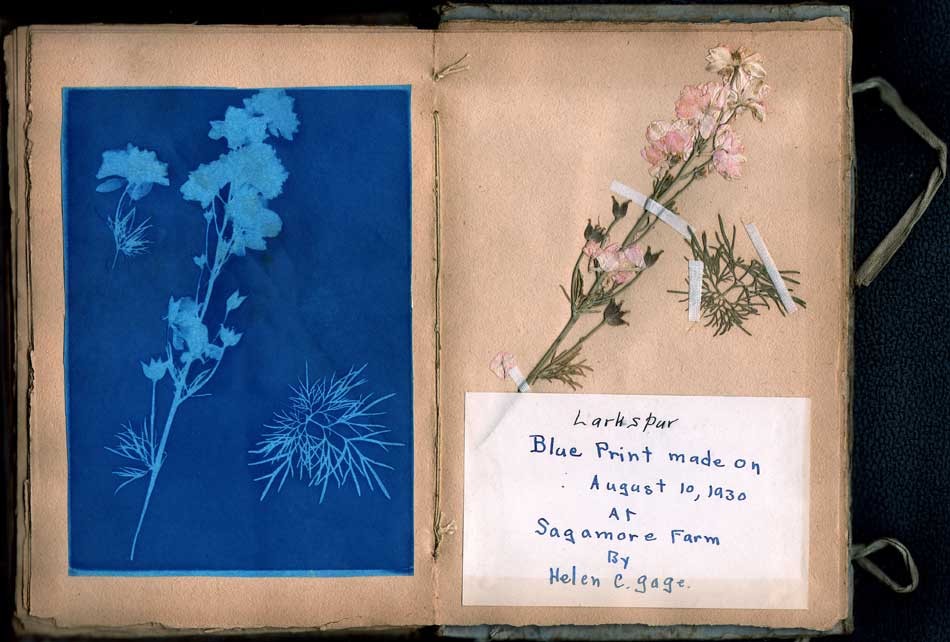 "Larkspur" (Scientific name: Delphinium; Family: Ranunculaceae) Helen Chase Gage- American: 1917-1982; Cyanotype: 1930: (17.7 x 12.6 cm | 21.6 x 14.6 cm x2) Inscribed on opposite album page: Larkspur: Blue Print made August 10, 1930 At Sagamore Farm By Helen C. Gage. This representative album spread from Helen's 1930 collected cyanotypes is unusual because the original collected botanical specimens are featured as part of the volume. Thirty-one individual prints are included within the album closed by means of cloth ties, seen at far right of frame. From: PhotoSeed Archive
"Larkspur" (Scientific name: Delphinium; Family: Ranunculaceae) Helen Chase Gage- American: 1917-1982; Cyanotype: 1930: (17.7 x 12.6 cm | 21.6 x 14.6 cm x2) Inscribed on opposite album page: Larkspur: Blue Print made August 10, 1930 At Sagamore Farm By Helen C. Gage. This representative album spread from Helen's 1930 collected cyanotypes is unusual because the original collected botanical specimens are featured as part of the volume. Thirty-one individual prints are included within the album closed by means of cloth ties, seen at far right of frame. From: PhotoSeed Archive
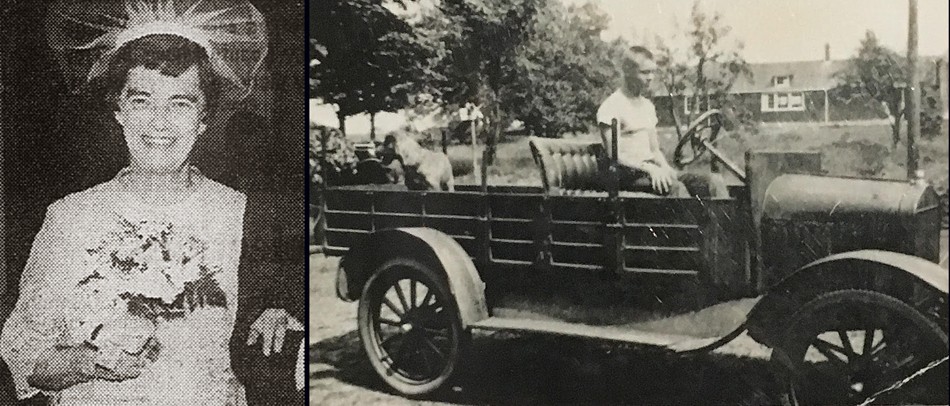 "Big Sister, Little Brother" Left: This cropped photograph of Helen Chase Gage Miller accompanied her 1970 wedding announcement in the Bronxville (New York) Review Press and Reporter newspaper. A graduate of Bronxville High School and Pratt Institute in Brooklyn earlier in life, she also attended Ursinus College. Later, the young photographer is known to have worked at Lord and Taylor, a department store in New York City, and was a member of the Reformed Church in Bronxville, the Anne Hutchinson Chapter of the Daughters of the American Revolution and the League for Service. Right: In 1935, Helen's younger brother Edward Augustus Gage (1919-2007) is shown behind the wheel of a 1918 Model T Ford depot wagon, along with his dog Ski at rear, in a photograph believed to have been taken near the family's summer property in Rye. The caption for this photograph which appeared in the volume "Footprints in Time" states: "Edward Gage later played an important role in trying to get the government to sell Odiorne land back to its pre-war owners." His 2007 obituary mentions he was a pilot and flight instructor in World War II and finished in the Naval Reserves at the rank of lieutenant commander. Trained as a lawyer, in 1970 he was appointed to serve as judge of the Exeter District Court in New Hampshire until his retirement in 2003. Photo courtesy Seacoast Science Center.
"Big Sister, Little Brother" Left: This cropped photograph of Helen Chase Gage Miller accompanied her 1970 wedding announcement in the Bronxville (New York) Review Press and Reporter newspaper. A graduate of Bronxville High School and Pratt Institute in Brooklyn earlier in life, she also attended Ursinus College. Later, the young photographer is known to have worked at Lord and Taylor, a department store in New York City, and was a member of the Reformed Church in Bronxville, the Anne Hutchinson Chapter of the Daughters of the American Revolution and the League for Service. Right: In 1935, Helen's younger brother Edward Augustus Gage (1919-2007) is shown behind the wheel of a 1918 Model T Ford depot wagon, along with his dog Ski at rear, in a photograph believed to have been taken near the family's summer property in Rye. The caption for this photograph which appeared in the volume "Footprints in Time" states: "Edward Gage later played an important role in trying to get the government to sell Odiorne land back to its pre-war owners." His 2007 obituary mentions he was a pilot and flight instructor in World War II and finished in the Naval Reserves at the rank of lieutenant commander. Trained as a lawyer, in 1970 he was appointed to serve as judge of the Exeter District Court in New Hampshire until his retirement in 2003. Photo courtesy Seacoast Science Center.
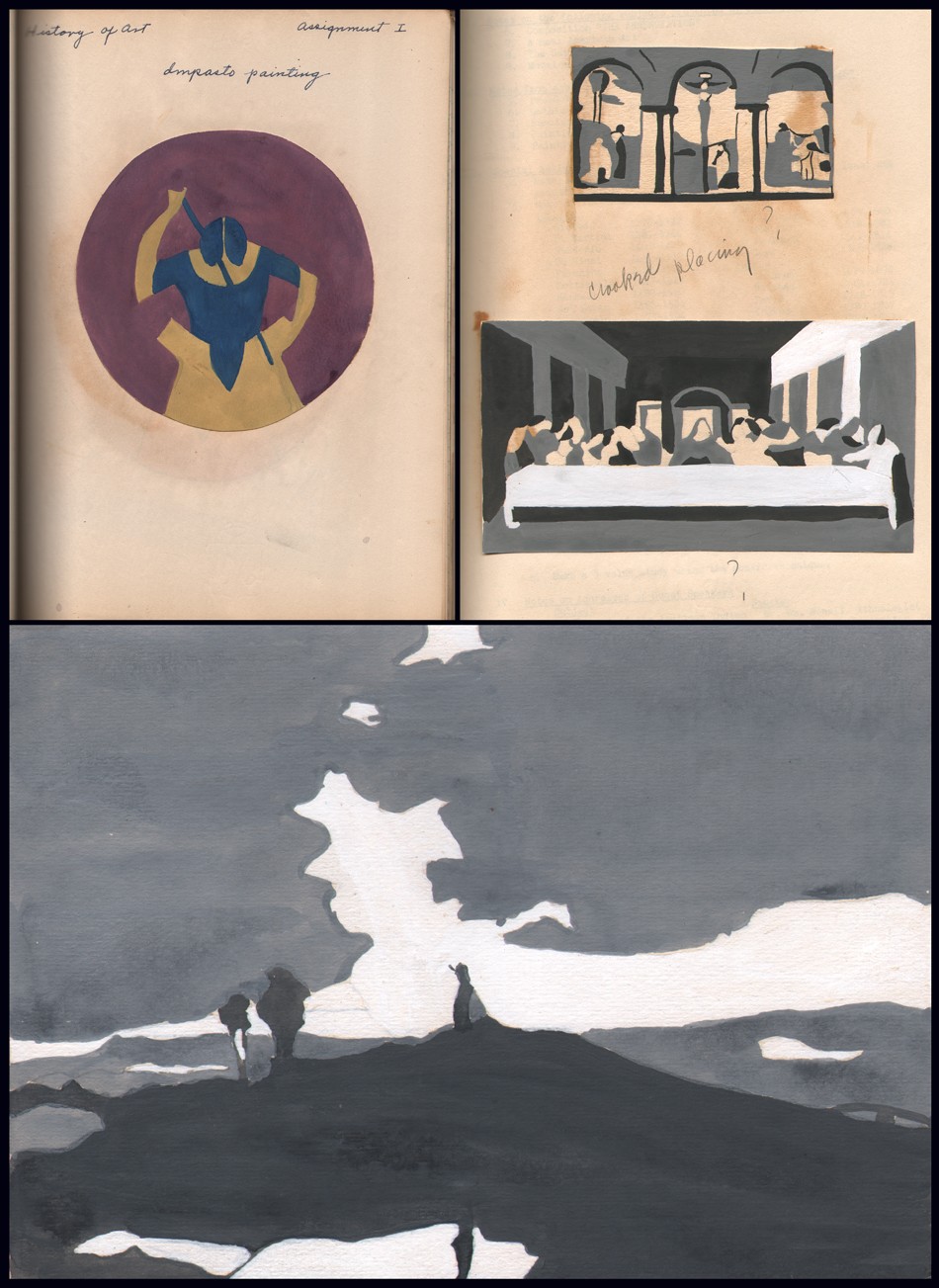 The pursuit of art was evident for Helen Chase Gage after early childhood. Although it's not known if she pursued it in any professional capacity later in life, Helen did attend Pratt Institute-School of Fine and Applied Arts in Brooklyn, New York from 1939-40, graduating in June, 1940. Above are several examples of original artwork by Gage used in her Art History course she was enrolled in as part of a series of lessons on painting presented by school Director James C. Boudreau kept in a notebook held by the PhotoSeed Archive. Top left: a tondo (13.8 cm) female form frontal view by Helen Chase Gage as an example of Impasto painting done using tempera paint. Top right: tempera study (5.5 x 9.5 cm) by Helen Chase Gage of the fresco "Pazzi Crucifixion" by Pietro Perugino; bottom: tempera study (8.4 x 15.9 cm) by Helen Chase Gage of Leonardo Da Vinci's "Last Supper". Bottom: tempera study (12.9 x 18.1 cm) by Helen Chase Gage of a painting by English artist Joseph Mallord William Turner titled "A Heath Scene" in the Gage notebook. From: PhotoSeed Archive
The pursuit of art was evident for Helen Chase Gage after early childhood. Although it's not known if she pursued it in any professional capacity later in life, Helen did attend Pratt Institute-School of Fine and Applied Arts in Brooklyn, New York from 1939-40, graduating in June, 1940. Above are several examples of original artwork by Gage used in her Art History course she was enrolled in as part of a series of lessons on painting presented by school Director James C. Boudreau kept in a notebook held by the PhotoSeed Archive. Top left: a tondo (13.8 cm) female form frontal view by Helen Chase Gage as an example of Impasto painting done using tempera paint. Top right: tempera study (5.5 x 9.5 cm) by Helen Chase Gage of the fresco "Pazzi Crucifixion" by Pietro Perugino; bottom: tempera study (8.4 x 15.9 cm) by Helen Chase Gage of Leonardo Da Vinci's "Last Supper". Bottom: tempera study (12.9 x 18.1 cm) by Helen Chase Gage of a painting by English artist Joseph Mallord William Turner titled "A Heath Scene" in the Gage notebook. From: PhotoSeed Archive
Jumping to the present day, the focal point of the park is the Seacoast Science Center, a non-profit marine science education organization. When I visited on October 1st recently, I had the pleasure of speaking with the center’s president Jim Chase, who gave me a brief history of the property and was helpful with directions to the area where Sagamore Farm was once located. He told me of the park’s efforts in clearing out some of the invasive plants on the property and about one of Seacoast’s more popular activities- BioBlitz, described as a “daylong species scavenger hunt…..where families explore alongside scientists and field experts to find and record data on as many different species in the Park as possible in one day.”
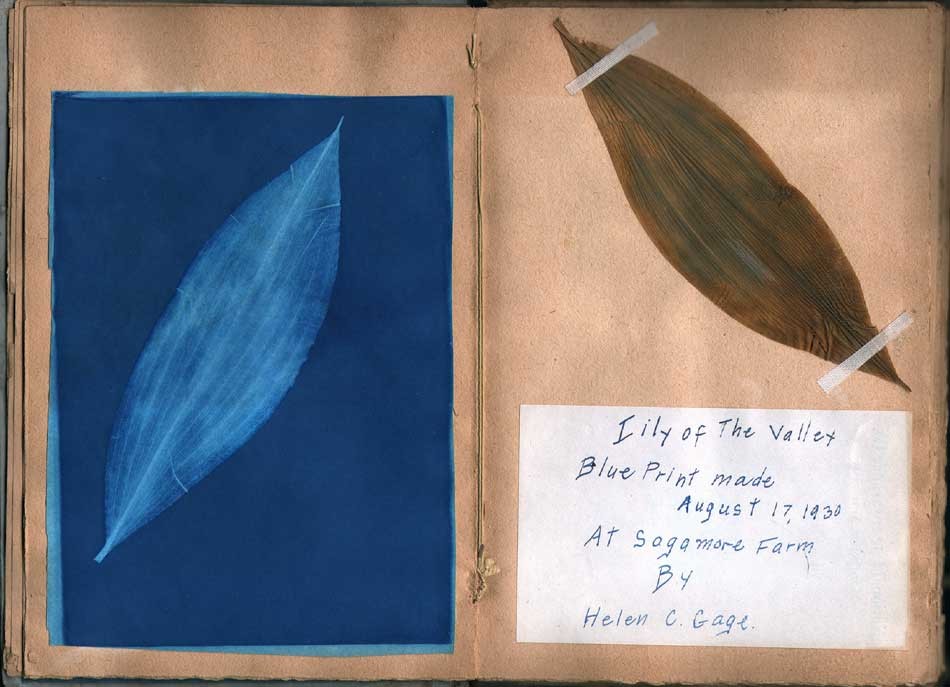 "Lily of The Valley" (Convallaria majalis) Helen Chase Gage- American: 1917-1982; Cyanotype: 1930: (18.1 x 13.0 cm | 21.6 x 14.6 cm x2) Inscribed on opposite album page: Lily of The Valley: Blue Print made August 17, 1930 At Sagamore Farm By Helen C. Gage. This representative album spread from Helen's 1930 collected cyanotypes is unusual because the original collected botanical specimens are featured as part of the volume. Thirty-one individual prints are included within the album. From: PhotoSeed Archive
"Lily of The Valley" (Convallaria majalis) Helen Chase Gage- American: 1917-1982; Cyanotype: 1930: (18.1 x 13.0 cm | 21.6 x 14.6 cm x2) Inscribed on opposite album page: Lily of The Valley: Blue Print made August 17, 1930 At Sagamore Farm By Helen C. Gage. This representative album spread from Helen's 1930 collected cyanotypes is unusual because the original collected botanical specimens are featured as part of the volume. Thirty-one individual prints are included within the album. From: PhotoSeed Archive
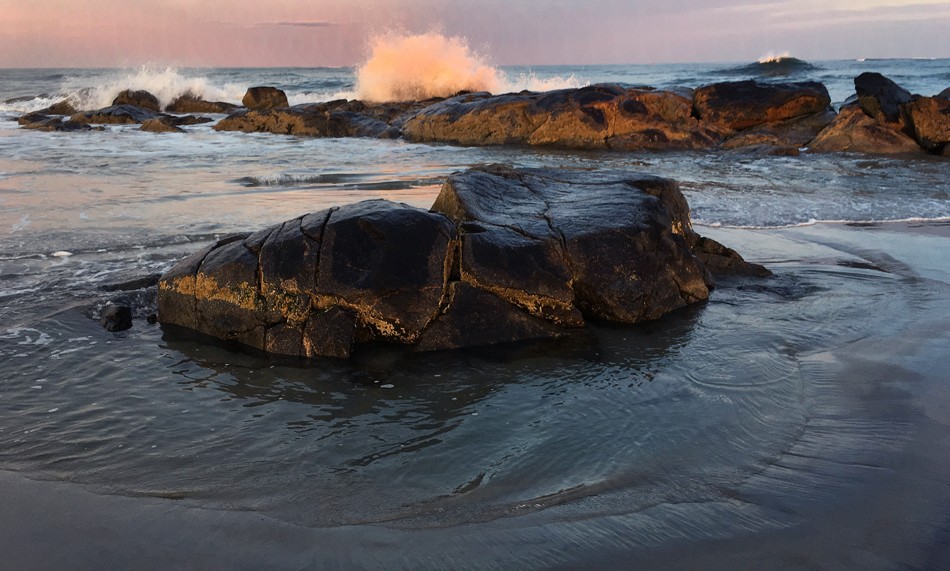 At dusk, waves crash on a rock outcropping at Hampton Beach, New Hampshire on September 30, 2018. Located twelve miles south of the present day Odiorne Point State Park along New Hampshire Route 1A, the popular summer destination spot for tourists is known for its' scenic beauty on the New Hampshire coastline, which measures in at 18.57 miles, the shortest ocean coastline of any US state. (or 235 miles of “estuarine shoreline!) Attractions and geographical proximity such as this give ample reason for visitors to visit both locales. Photo by David Spencer for PhotoSeed Archive
At dusk, waves crash on a rock outcropping at Hampton Beach, New Hampshire on September 30, 2018. Located twelve miles south of the present day Odiorne Point State Park along New Hampshire Route 1A, the popular summer destination spot for tourists is known for its' scenic beauty on the New Hampshire coastline, which measures in at 18.57 miles, the shortest ocean coastline of any US state. (or 235 miles of “estuarine shoreline!) Attractions and geographical proximity such as this give ample reason for visitors to visit both locales. Photo by David Spencer for PhotoSeed Archive
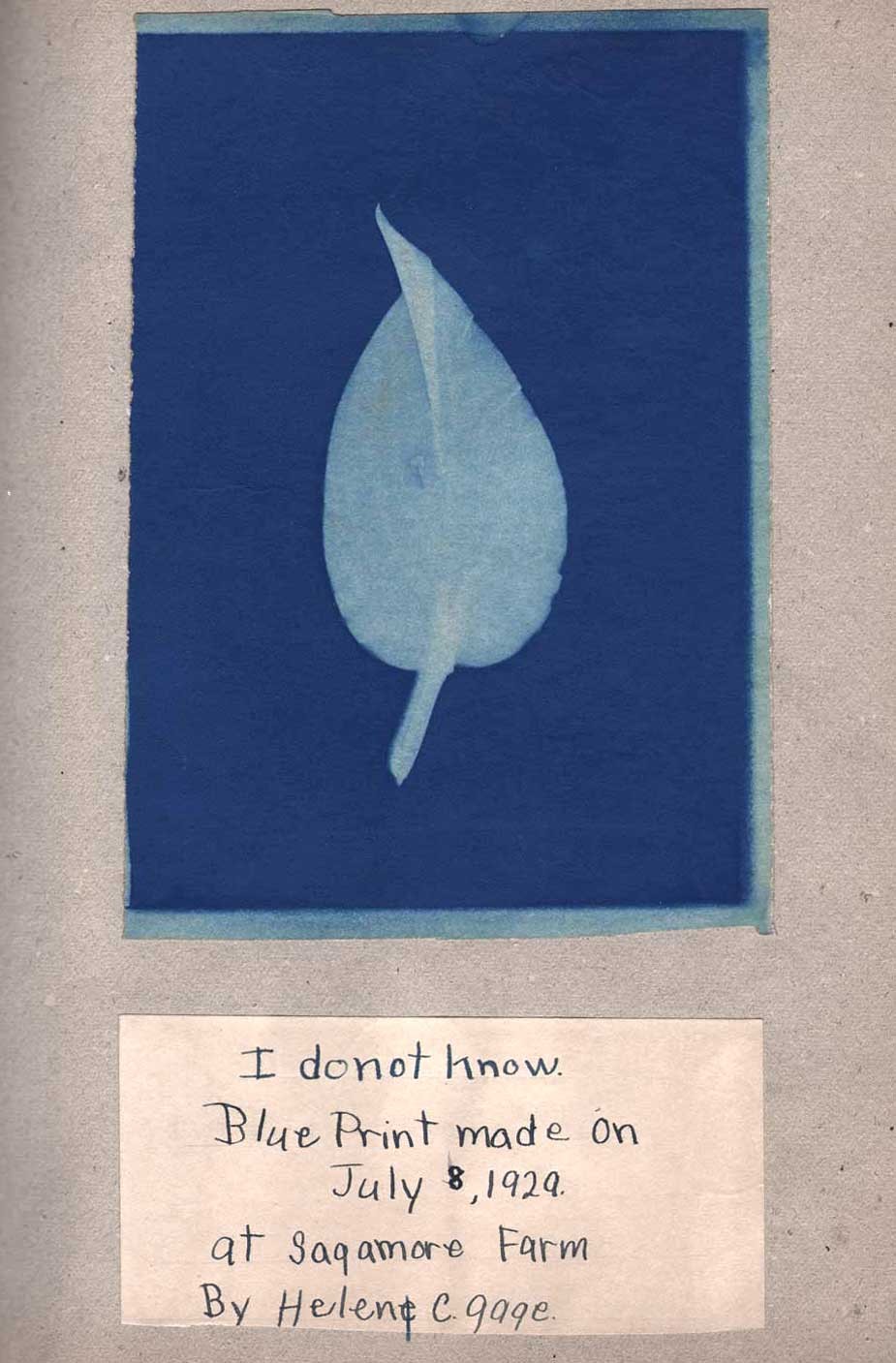 "I Do Not Know" Helen Chase Gage- American: 1917-1982; Cyanotype: 1929: (18.0 x 12.5 cm | 30.0 x 22.8 cm) Inscribed on same album page: I do not know.: Blue Print made July 8, 1929 At Sagamore Farm By Helen C. Gage. Perhaps one of the most interesting cyanotypes in both albums is this unidentified leaf specimen-endearing because the young artist who collected it was just being honest with her knowledge and told us so. As I've mentioned previously with these overall works, a few of the specimens may not be “right” botanically and possibly misidentified in some cases. Your expertise is welcomed! From: PhotoSeed Archive
"I Do Not Know" Helen Chase Gage- American: 1917-1982; Cyanotype: 1929: (18.0 x 12.5 cm | 30.0 x 22.8 cm) Inscribed on same album page: I do not know.: Blue Print made July 8, 1929 At Sagamore Farm By Helen C. Gage. Perhaps one of the most interesting cyanotypes in both albums is this unidentified leaf specimen-endearing because the young artist who collected it was just being honest with her knowledge and told us so. As I've mentioned previously with these overall works, a few of the specimens may not be “right” botanically and possibly misidentified in some cases. Your expertise is welcomed! From: PhotoSeed Archive
Feeling like a kid myself, I used my phone to show Jim one of the many fine botanical specimens Helen had made into a cyanotype from the 1930 album and realized she could have been rightly called one of the first BioBlitz scavenger hunters. As I left and walked outside the Seacoast Center, I found confirmation for Helen’s love of place on the New Hampshire seaboard all those years ago: a large group of school children getting ready to set out on their own happy discoveries.
David Spencer- October, 2018
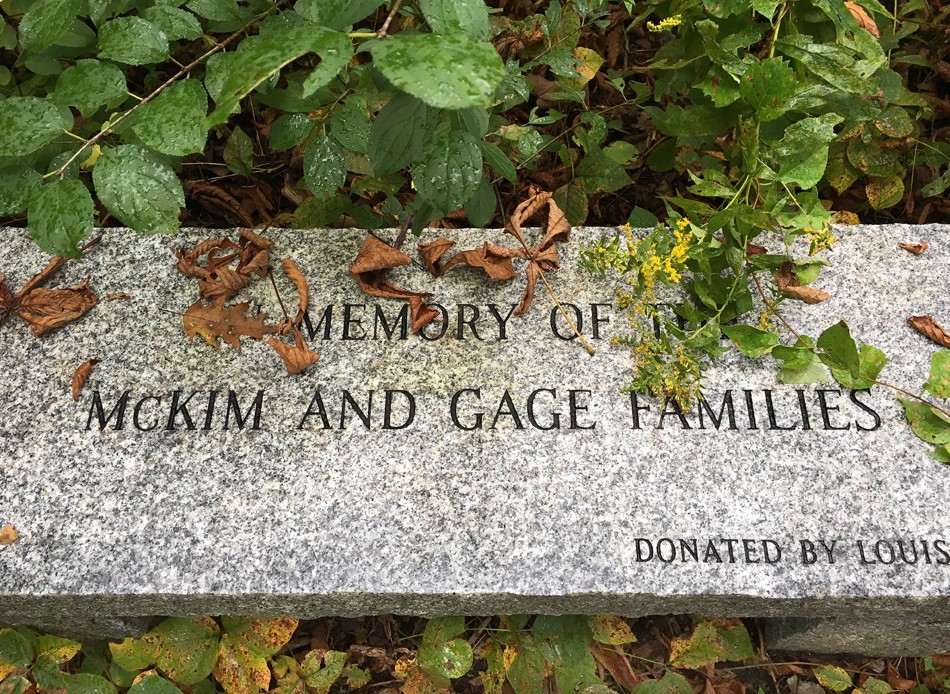 A Special Place Indeed: a poignant reminder of the property where Helen Chase Gage collected her plant specimens in order to make precious blue prints so many summers ago yields some new opportunities in the form of fall leaves and Goldenrod resting on this granite bench dedicated to the memory of the McKim and Gage families inside Rye's Odiorne Point State Park where "Sagamore Farm" once stood. Photographed October 1, 2018 by David Spencer for PhotoSeed Archive
A Special Place Indeed: a poignant reminder of the property where Helen Chase Gage collected her plant specimens in order to make precious blue prints so many summers ago yields some new opportunities in the form of fall leaves and Goldenrod resting on this granite bench dedicated to the memory of the McKim and Gage families inside Rye's Odiorne Point State Park where "Sagamore Farm" once stood. Photographed October 1, 2018 by David Spencer for PhotoSeed Archive
Afterword
An interesting segment from New Hampshire Public Radio from 2016 reports on how Odiorne Point State Park in New Hampshire was developed in the aftermath of World War II. The voice of Helen’s younger brother Edward Gage, (1919-2007) who went on to become a lawyer and spent decades trying to reclaim his family’s property is included in the report. To the credit of the park in not glossing over the loss to the Gage family and others-specifically the namesake Odiorne family who had owned property here since the 1660’s, signage outlining this history can be seen inside the Seacoast Science Center:
“In 1942,when the U.S. government took over Odiorne Point, homeowners were given short notice to vacate their beloved vacation homes and, in the case of the Odiornes, a farm that had been in their family almost three hundred years.
After the war, a debated legislative technicality at the federal level prevented Odiorne Point landowners from regaining their property. In ensuing years, discussion over what would become of the land covered the full range of development and preservation schemes.
In the end, thanks to preservation activist Annette Cottrell and the interest of New Hampshire Park Director Russell B. Tobey, the state-owned land became a park. The park is now the site of the Seacoast Science Center.
The story of Odiorne Point continues. Visitors and students from around the world are making new use of the park through the Seacoast Science Center and its educational programs. This little point of land seems destined to make more history.”
Additional Reading
-Footprints in Time: A Walk where New Hampshire Began. Compiled by Howard S. Crosby, Wendy W. Lull, and Richard T. MacIntyre: Arcardia Publishing, 1994
-Writer Anna Soper contributes additional scholarship on these albums in her article These Stunning Botanical Images Are Blueprints of the Past found on the Atlas Obscura website published October 8, 2019.
Nature's Camera
Posted May 2015 in Alternate Processes, History of Photography, Scientific Photography
Spring, that time of rebirth for the temperate regions of the world, is thankfully showing itself off again. With new growth on trees, flowers showing off and the lingering sweet smells of airborne pollen, these are but a few signs of the season.
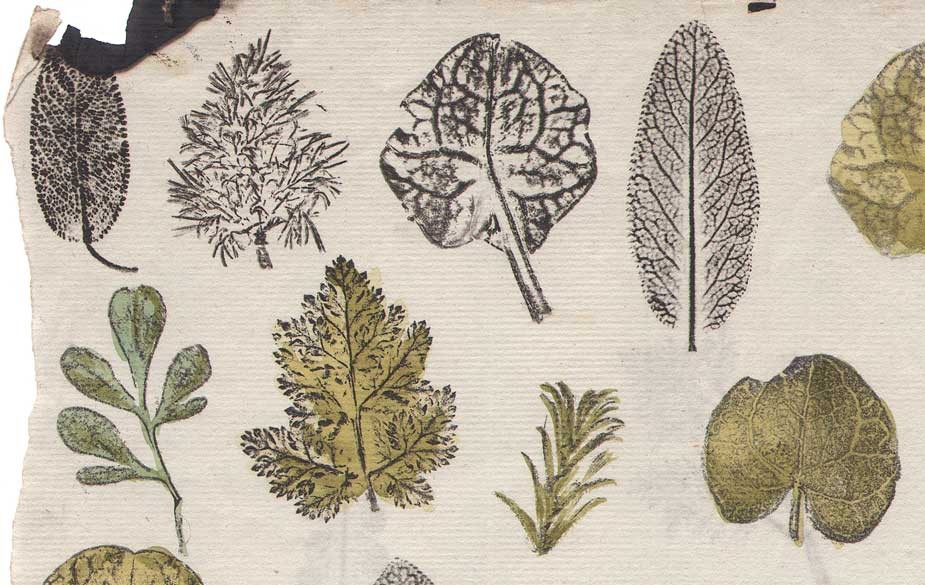 Detail: Nature prints: English: unknown maker: (recto) leaf specimens with selective hand-coloring: ca. 1775-1825: 30.5 x 38.3 cm: laid paper leaf (separated) with Britannia shield and C&S watermarks. from: PhotoSeed Archive
Detail: Nature prints: English: unknown maker: (recto) leaf specimens with selective hand-coloring: ca. 1775-1825: 30.5 x 38.3 cm: laid paper leaf (separated) with Britannia shield and C&S watermarks. from: PhotoSeed Archive
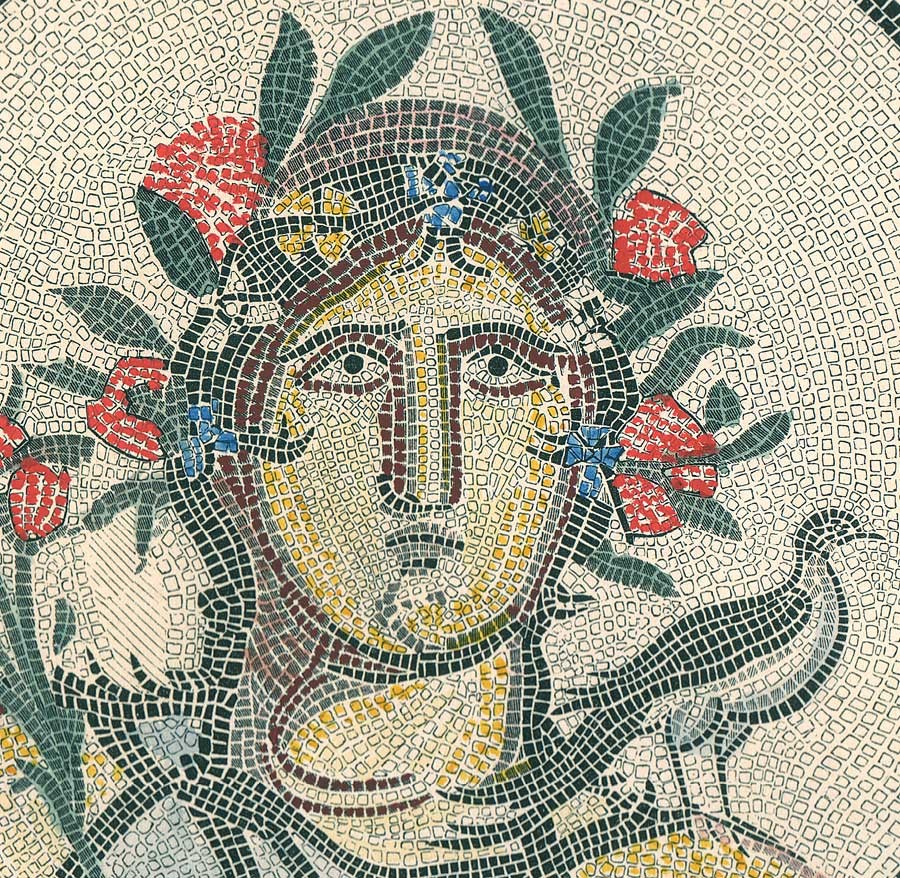 Detail: "Flora", the Roman goddess of Spring and flowers: 1850: hand-colored lithograph from Talbotype by Philip Henry Delamotte (1821-1889) of hand-drawn and colored tracing of Roman mosaic (mid 2nd Century A.D.) at Cirencester, England. 14.5 x 10.2 cm: reproduced as plate V in: "Illustrations of the Remains of Roman Art, in Cirencester, The Site of Antient Corinium": London. This floor mosaic of Flora was one of three seasonal mosaics excavated at Cirencester in 1849. From: PhotoSeed Archive
Detail: "Flora", the Roman goddess of Spring and flowers: 1850: hand-colored lithograph from Talbotype by Philip Henry Delamotte (1821-1889) of hand-drawn and colored tracing of Roman mosaic (mid 2nd Century A.D.) at Cirencester, England. 14.5 x 10.2 cm: reproduced as plate V in: "Illustrations of the Remains of Roman Art, in Cirencester, The Site of Antient Corinium": London. This floor mosaic of Flora was one of three seasonal mosaics excavated at Cirencester in 1849. From: PhotoSeed Archive
As children, our very first “photographs” joyously executed in winter climes would have taken the form of angelic impressions left in the newly fallen snow, or tropical: designs left on sandy seashores.
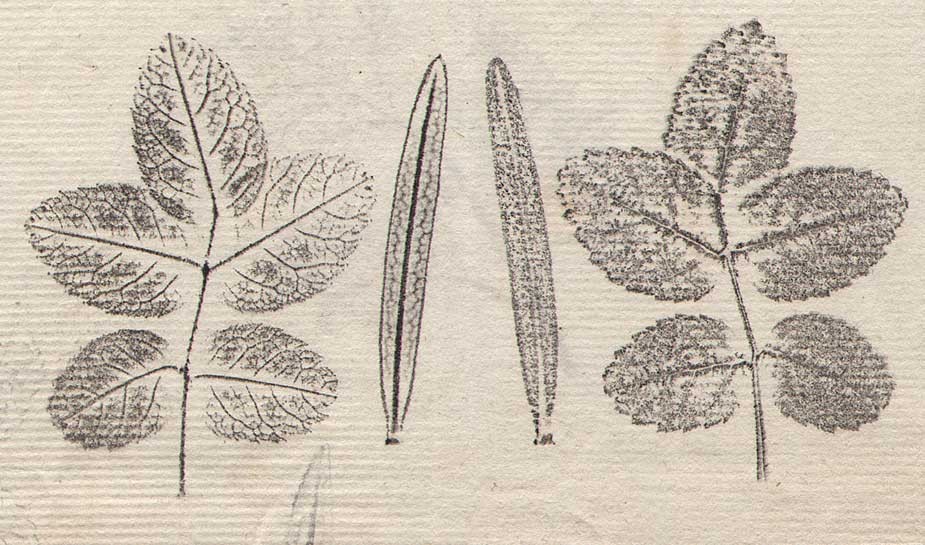 Detail: Nature prints: English: unknown maker: mirror impression of unknown grass and leaf cluster specimens: ca. 1775-1825: 30.5 x 38.3 cm: laid paper leaf (separated) with Britannia shield and C&S watermarks. from: PhotoSeed Archive
Detail: Nature prints: English: unknown maker: mirror impression of unknown grass and leaf cluster specimens: ca. 1775-1825: 30.5 x 38.3 cm: laid paper leaf (separated) with Britannia shield and C&S watermarks. from: PhotoSeed Archive
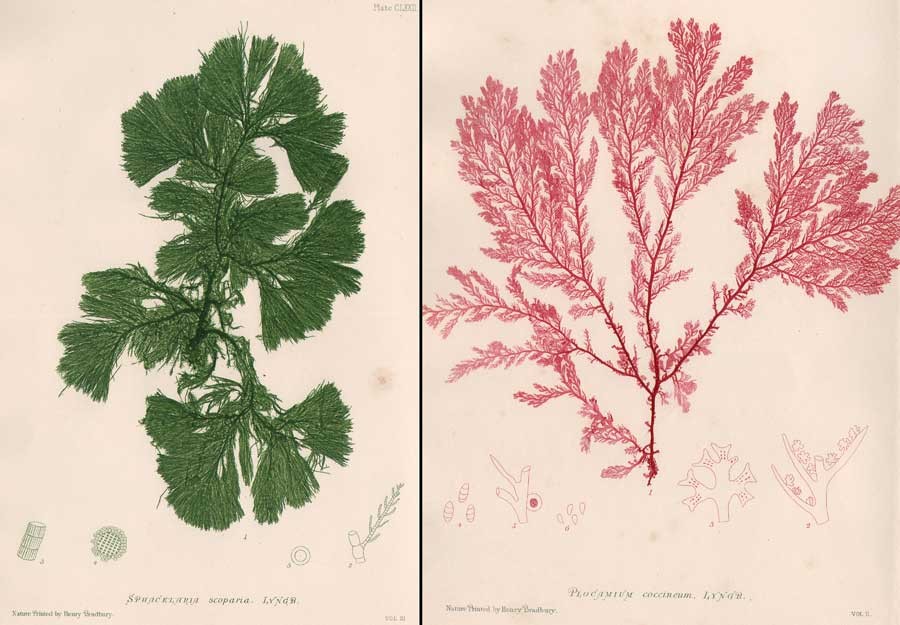 Examples of nature-printed British Seaweeds printed in intaglio by Henry Bradbury, English. (1831-1860) Left: Sphacelaria Scoparia Lyngb.: 1860; 23.9 x 15.5 cm: plate CLXXII from vol. III: "The Nature-Printed British Sea-Weeds: A History, Accompanied by figures and dissections, of the algae of the British Isles" : London: Bradbury and Evans. Right: Plocamium Coccineum, Lyngb.: 1859; 23.9 x 15.5 cm: plate LXVIII from vol. II: "The Nature-Printed British Sea-Weeds": Bradbury's technique commercialized nature printing for the masses-he adapted an 1852 process invented by Viennese engravers Alois Auer and Andreas Worring creating a matrix by placing botanical specimens between a sheet of soft lead and steel which were then electroplated, inked and printed. from: PhotoSeed Archive
Examples of nature-printed British Seaweeds printed in intaglio by Henry Bradbury, English. (1831-1860) Left: Sphacelaria Scoparia Lyngb.: 1860; 23.9 x 15.5 cm: plate CLXXII from vol. III: "The Nature-Printed British Sea-Weeds: A History, Accompanied by figures and dissections, of the algae of the British Isles" : London: Bradbury and Evans. Right: Plocamium Coccineum, Lyngb.: 1859; 23.9 x 15.5 cm: plate LXVIII from vol. II: "The Nature-Printed British Sea-Weeds": Bradbury's technique commercialized nature printing for the masses-he adapted an 1852 process invented by Viennese engravers Alois Auer and Andreas Worring creating a matrix by placing botanical specimens between a sheet of soft lead and steel which were then electroplated, inked and printed. from: PhotoSeed Archive
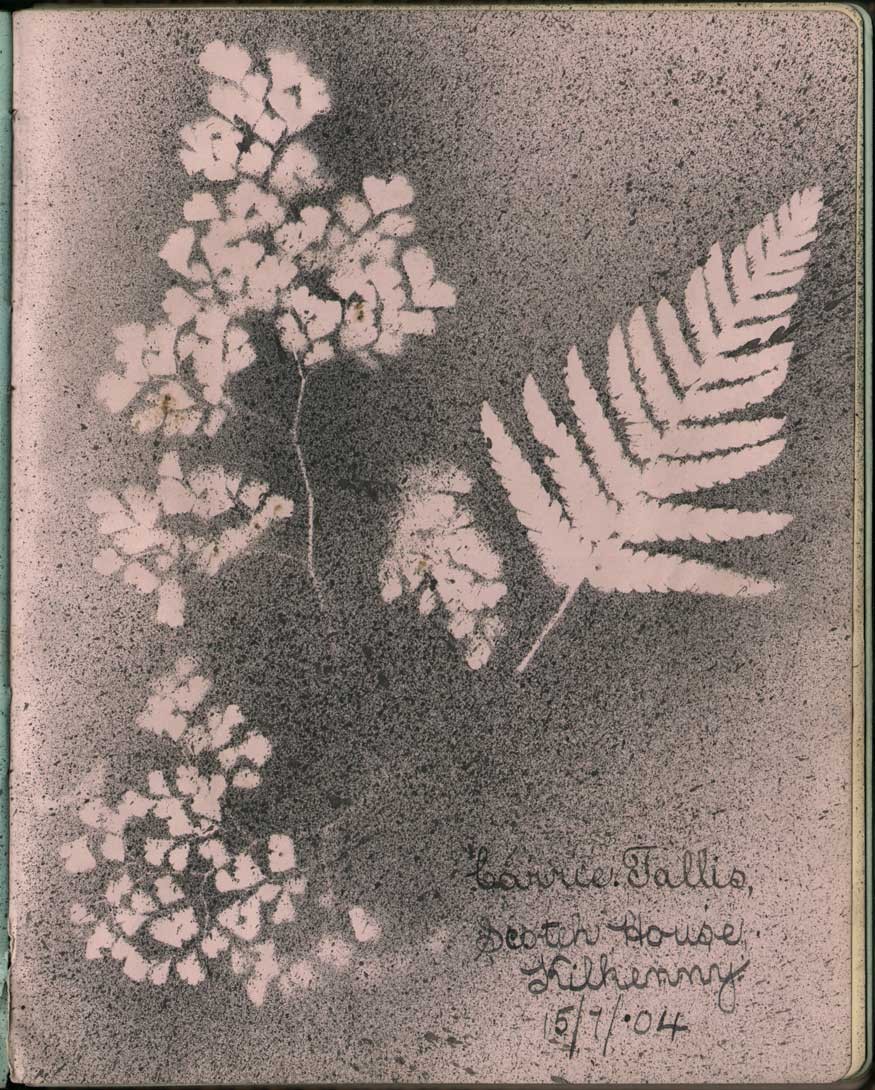 "Ink Splatter Photogram of Fern and Flowers on Paper", 1904: by amateur Irish artist Caroline Emily Tallis, (1889-1972) (21.9 x 17.2 cm): single page from English or Irish compiled Edwardian album signed lower right: "Carrie Tallis, Scotch House Kilkenny 15/7/04": from: PhotoSeed Archive
"Ink Splatter Photogram of Fern and Flowers on Paper", 1904: by amateur Irish artist Caroline Emily Tallis, (1889-1972) (21.9 x 17.2 cm): single page from English or Irish compiled Edwardian album signed lower right: "Carrie Tallis, Scotch House Kilkenny 15/7/04": from: PhotoSeed ArchiveOur very own Pencils of Nature.
An impression of ourselves for sure, but also quickly obliterated-or not, like nature herself. Photography in this form has in a way been part of Earth’s plant and animal fossil record stretching back millions of years, with Mankind’s permanent efforts barely stretching back to the early 19th Century.
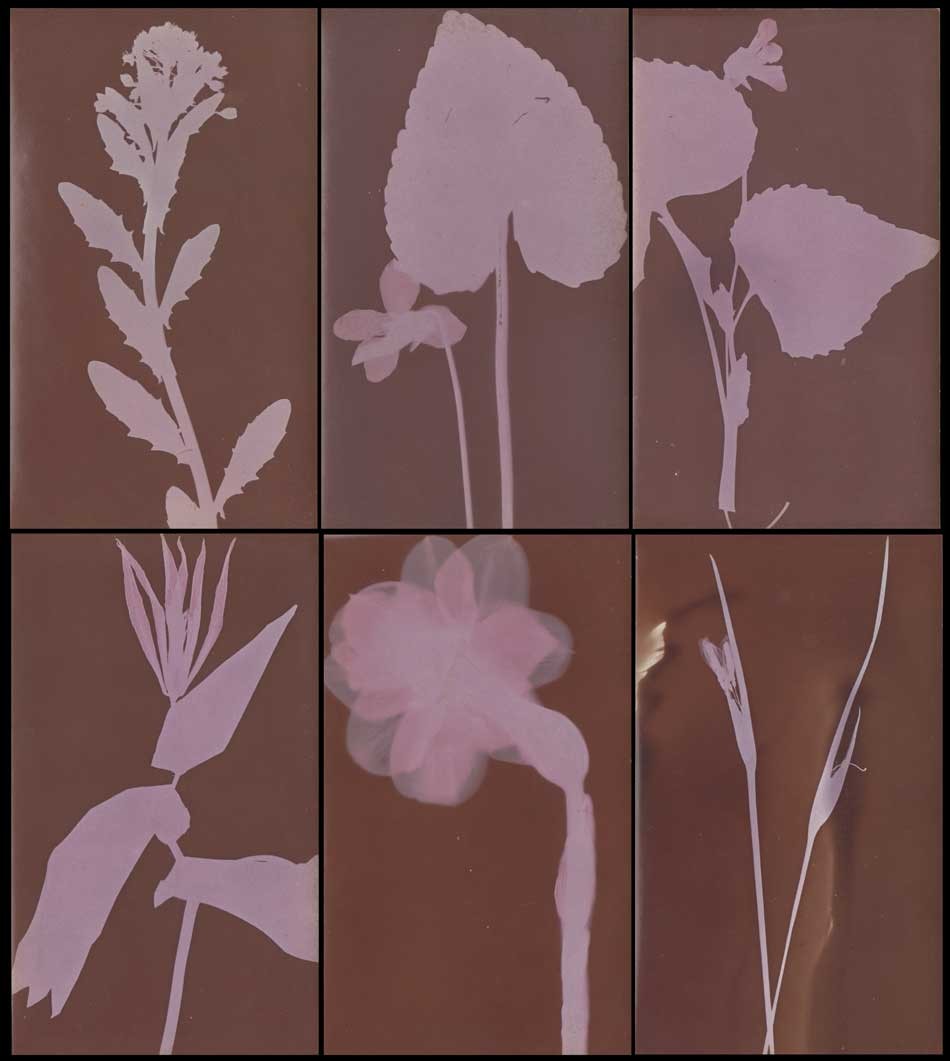 (6) individual Photograms, ca. 1925, by unknown American photographer on Kodak Self-Toning, single-weight glossy paper. (gelatin-silver developing out paper) each: 10.8 x 6.4 cm. Even before he discovered how to permanently "fix" what eventually became known as paper photographs in order to prevent their fading, Englishman William Henry Fox Talbot (1800-1877) first used his Photogenic Drawing method in 1834 to produce photograms. To do this he first placed a botanical specimen on a sheet of salt and silver nitrate-coated sheet of writing paper which produced a temporary, exact image of it when exposed to the Sun. Soon after, the lustrous blue Cyanotype process, perhaps best known today by the artistic plant studies perfected by Englishwoman Anna Atkins (1799-1871) made between 1843-53, gave way to even cheaper commercial methods for the photogram. Using store-bought, pre-sensitized photographic paper which home darkroom hobbyists readily exploited-similar to these examples- the art form was popularized even more in the early 20th Century. Specimens: top row, left to right: Shepherd's Purse, Purple Violet, Yellow Violet; Bottom row, left to right: Bell Wort, Narcissus, Blue-Eyed Grass. all from: PhotoSeed Archive
(6) individual Photograms, ca. 1925, by unknown American photographer on Kodak Self-Toning, single-weight glossy paper. (gelatin-silver developing out paper) each: 10.8 x 6.4 cm. Even before he discovered how to permanently "fix" what eventually became known as paper photographs in order to prevent their fading, Englishman William Henry Fox Talbot (1800-1877) first used his Photogenic Drawing method in 1834 to produce photograms. To do this he first placed a botanical specimen on a sheet of salt and silver nitrate-coated sheet of writing paper which produced a temporary, exact image of it when exposed to the Sun. Soon after, the lustrous blue Cyanotype process, perhaps best known today by the artistic plant studies perfected by Englishwoman Anna Atkins (1799-1871) made between 1843-53, gave way to even cheaper commercial methods for the photogram. Using store-bought, pre-sensitized photographic paper which home darkroom hobbyists readily exploited-similar to these examples- the art form was popularized even more in the early 20th Century. Specimens: top row, left to right: Shepherd's Purse, Purple Violet, Yellow Violet; Bottom row, left to right: Bell Wort, Narcissus, Blue-Eyed Grass. all from: PhotoSeed Archive
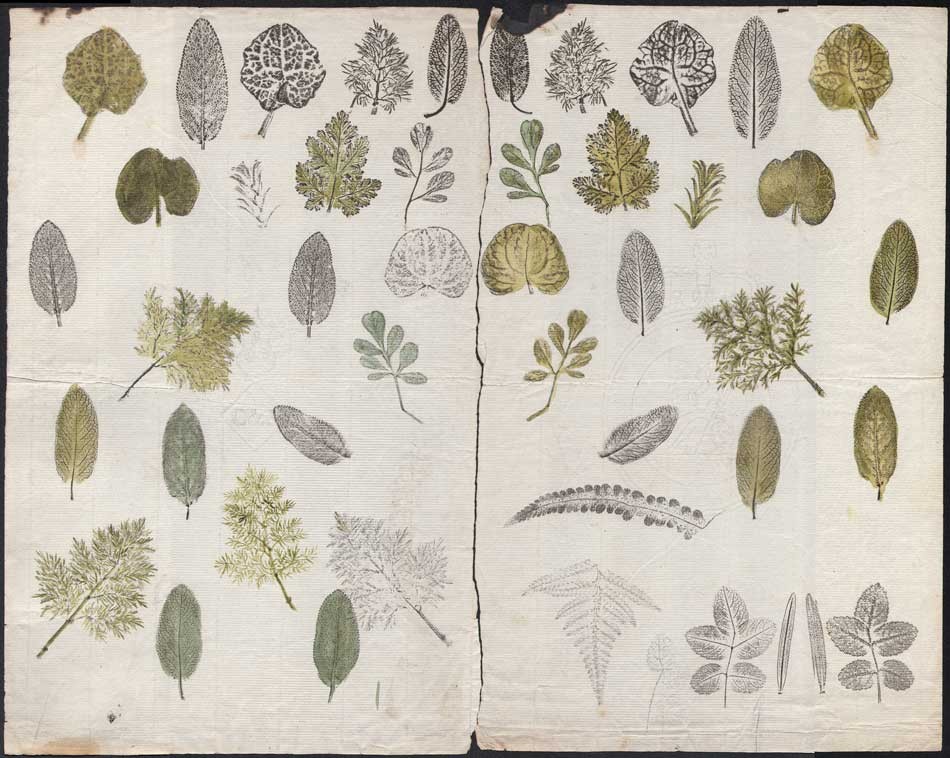 Nature prints: English: unknown maker: ca. 1775-1825: multiple, mirror impressions of unknown grass and leaf cluster specimens done with black printers ink & selective hand-coloring on laid paper leaf. (separated at middle) Britannia shield and C&S watermarks: 30.5 x 38.3 cm. Addressing an 1857 meeting of the Royal Society of the Arts, English Aesthetic Movement designer Christopher Dresser (1834-1904) gave the following historical account of the art of nature printing, of which this sheet is a rare surviving example, although ink rather than carbon black was used: "The earliest mode with which we are acquainted of producing impressions of plants was this:—The plant, after being dried, was held over the smoke of a candle or oil lamp, when it became blackened by a deposit of soot, after which it was placed between two sheets of paper and rubbed with a smoothing-bone, which caused the soot to leave the prominences of the leaf and adhere to the paper. In this way an impression of the plant was produced. This method of procuring impressions was employed as early as the year A.D. 1650." from: PhotoSeed Archive
Nature prints: English: unknown maker: ca. 1775-1825: multiple, mirror impressions of unknown grass and leaf cluster specimens done with black printers ink & selective hand-coloring on laid paper leaf. (separated at middle) Britannia shield and C&S watermarks: 30.5 x 38.3 cm. Addressing an 1857 meeting of the Royal Society of the Arts, English Aesthetic Movement designer Christopher Dresser (1834-1904) gave the following historical account of the art of nature printing, of which this sheet is a rare surviving example, although ink rather than carbon black was used: "The earliest mode with which we are acquainted of producing impressions of plants was this:—The plant, after being dried, was held over the smoke of a candle or oil lamp, when it became blackened by a deposit of soot, after which it was placed between two sheets of paper and rubbed with a smoothing-bone, which caused the soot to leave the prominences of the leaf and adhere to the paper. In this way an impression of the plant was produced. This method of procuring impressions was employed as early as the year A.D. 1650." from: PhotoSeed Archive
Enjoy this gallery of images celebrating the beauty of flora. From original Nature Prints ca. 1775-1825: inked leaves placed between a sheet of paper and pulled through a printing press; to mosaic red flowers adorning the head of a Roman goddess imagined by an artist around 250 A.D. transcribed and copied by the radical Talbotype process and published in 1850; to delicate British seaweeds copied into lead and printed 1859-60 to modern examples still nearly a century old: six silhouetted jewels ca. 1925 from the time photographic hobbyists gazed in wonderment at their first efforts emerging from developer trays in home darkrooms.
Beauty, Underwater
Posted October 2014 in History of Photography, New Additions, Scientific Photography, Significant Photographs
With Autumn upon us in the more seasonal regions of the United States, a remembrance, particularly if we are young, of the joys of cooling off in the lakes, ponds, and rivers of our youth.
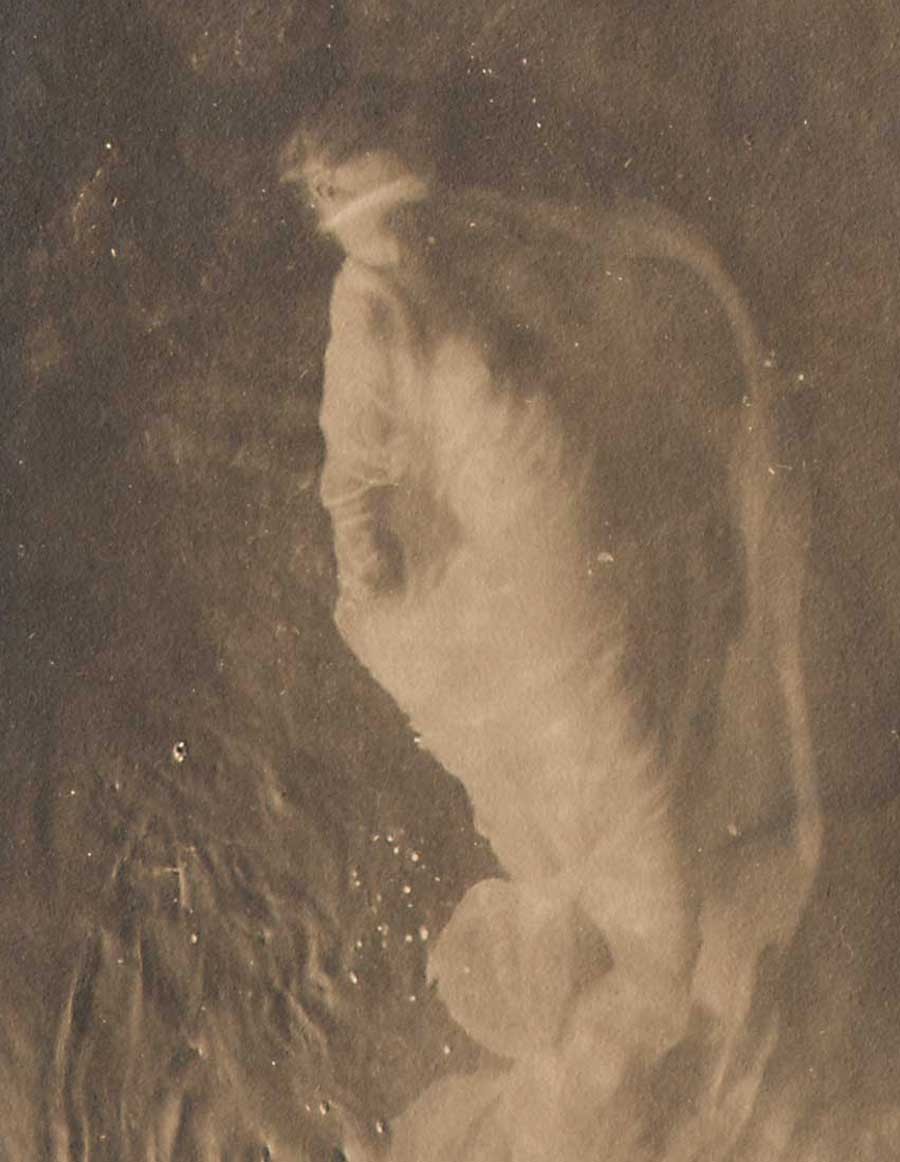 Detail: Gelatin silver print: "Mermaid Study : Ki-lo-des-ka": ca. 1914 or before: by Charlotte Vetter Gulick: image: 7.1 x 9.2 cm: mount: 16.7 x 22.7 cm. Subject shows Katharine "Kitty" Gulick swimming underwater at Camp Wohelo in Maine. from: PhotoSeed Archive
Detail: Gelatin silver print: "Mermaid Study : Ki-lo-des-ka": ca. 1914 or before: by Charlotte Vetter Gulick: image: 7.1 x 9.2 cm: mount: 16.7 x 22.7 cm. Subject shows Katharine "Kitty" Gulick swimming underwater at Camp Wohelo in Maine. from: PhotoSeed Archive
Memories made all the more indelible if we ever had the opportunity to attend summer camp.
So lets go further and think about taking a photograph of someone underwater. Not a photo taken with a camera underwater, a remarkable feat in itself accomplished beginning in 1893 by the Frenchman Louis Boutan, (1.) but from the outside looking in.
Before researching a series of photographs recently acquired for this archive showing a young woman swimming underwater, I would have thought no big deal- perhaps they were rare but could the subject matter actually be unique? After all, they were first published for a mass audience in Everybody’s Magazine in the U.S. in August of 1914, with the author exclaiming them to be “remarkable photographs…taken under conditions not easily duplicated, and have aroused great interest among artists and others who have seen the originals.” (2.)
No doubt other examples of this activity exist in the form of vintage photographs. Snapshots perhaps-but ones where actual intent existed in order to show the beauty of the human figure swimming underwater? Before or perhaps a decade or two after 1914? Somehow I doubt it. ✻
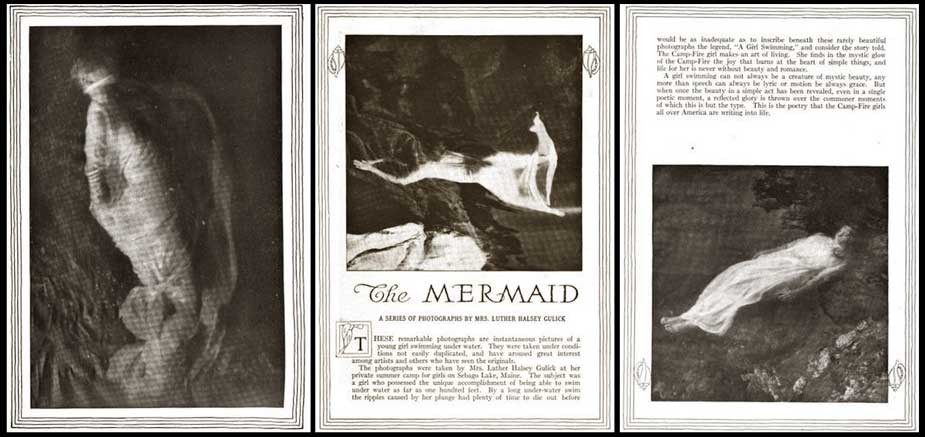 Three individual halftone and letterpress page spreads showing mermaid "Ki-lo-des-ka" (Katharine "Kitty" Gulick) swimming and lying submerged underwater: from: Everybody’s Magazine: New York: August, 1914: pp. 225-232
Three individual halftone and letterpress page spreads showing mermaid "Ki-lo-des-ka" (Katharine "Kitty" Gulick) swimming and lying submerged underwater: from: Everybody’s Magazine: New York: August, 1914: pp. 225-232
With a bit of research, I not only discovered the subject of the “mermaid” doing the swimming in the photos: Katharine “Kitty” Gulick, (1895-1968) but the remarkable story behind the amateur photographer who took them: her mother Charlotte Vetter Gulick. (1865-1928) Taken at Wohelo girls summer camp on the shore of Sebago Lake in Raymond, Maine, a camp founded in 1907 by Gulick and husband Luther Halsey Gulick (1865-1918) that is still going strong today, the following article from Everybody’s explains how these remarkable photos were taken and provides guiding principals behind the Camp Fire Girl movement founded by the photographer herself.
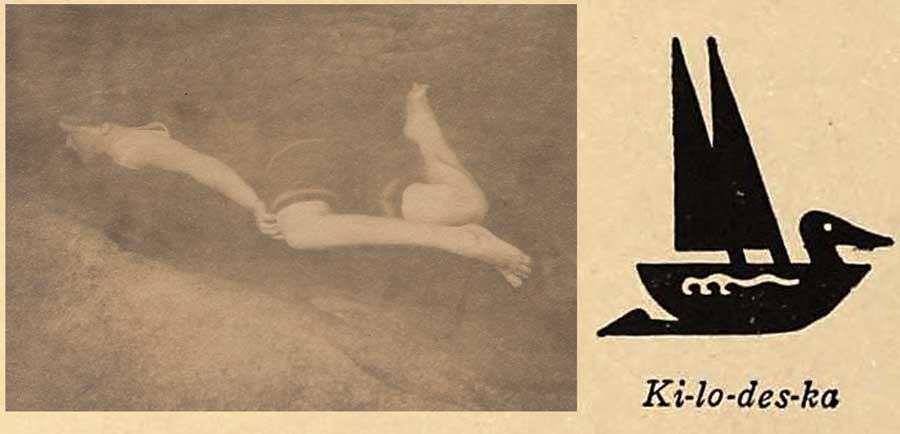 inset: detail: Gelatin silver print: "Mermaid Study : Ki-lo-des-ka" ca. 1914 or before: by Charlotte Vetter Gulick: image: 8.1 x 10.5 cm: mount: 16.8 x 23.2 cm: This was an early effort showing "Kitty" wearing a dark-colored bathing-suit "which was too nearly the tone of the rocks to give definition" before the garment was substituted for "a flowing garment of cheese-cloth" which showed up much better against the darkness of the water.: from: PhotoSeed Archive. Background: Camp Wohelo Indian symbol for "Ki-lo-des-ka" aka: "Water-bird": from 1915 volume by Ethel Rogers: "Sebago-Wohelo Camp Fire Girls"
inset: detail: Gelatin silver print: "Mermaid Study : Ki-lo-des-ka" ca. 1914 or before: by Charlotte Vetter Gulick: image: 8.1 x 10.5 cm: mount: 16.8 x 23.2 cm: This was an early effort showing "Kitty" wearing a dark-colored bathing-suit "which was too nearly the tone of the rocks to give definition" before the garment was substituted for "a flowing garment of cheese-cloth" which showed up much better against the darkness of the water.: from: PhotoSeed Archive. Background: Camp Wohelo Indian symbol for "Ki-lo-des-ka" aka: "Water-bird": from 1915 volume by Ethel Rogers: "Sebago-Wohelo Camp Fire Girls"
Illustrating the article were eight photographs of Wohelo camper “Ki-lo-des-ka”, or “Water-bird”, the aforementioned “Kitty” Gulick, with several of the originals formerly owned by her appearing with this post:
The Mermaid
A SERIES OF PHOTOGRAPHS BY MRS. LUTHER HALSEY GULICK
THESE remarkable photographs are instantaneous pictures of a young girl swimming under water. They were taken under conditions not easily duplicated, and have aroused great interest among artists and others who have seen the originals. The photographs were taken by Mrs. Luther Halsey Gulick at her private summer camp for girls on Sebago Lake, Maine. The subject was a girl who possessed the unique accomplishment of being able to swim under water as far as one hundred feet. By a long under-water swim the ripples caused by her plunge had plenty of time to die out before she passed the rock on which Mrs. Gulick stood with the camera.
The experiments were made on a brilliantly clear day. The water also was extraordinarily clear and the swimmer passed the camera’s field two or three feet below the surface. The final clue to success was found when a flowing garment of cheese-cloth was substituted for the dark-colored bathing-suit, which was too nearly the tone of the rocks to give definition. Both the figure and the draperies, under the equalizing buoyancy of the water, give a rare representation of poise, as they are entirely unaffected by the force of gravity.
How far short this description fails of conveying the art value of the photographs, their rhythm of line and beauty of form and tone, is significantly obvious; for in this margin of appeal to the imagination lies the motive that produced the pictures. They were taken at the birthplace of the Camp-Fire idea of which Mrs. Gulick is one of the chief sponsors.
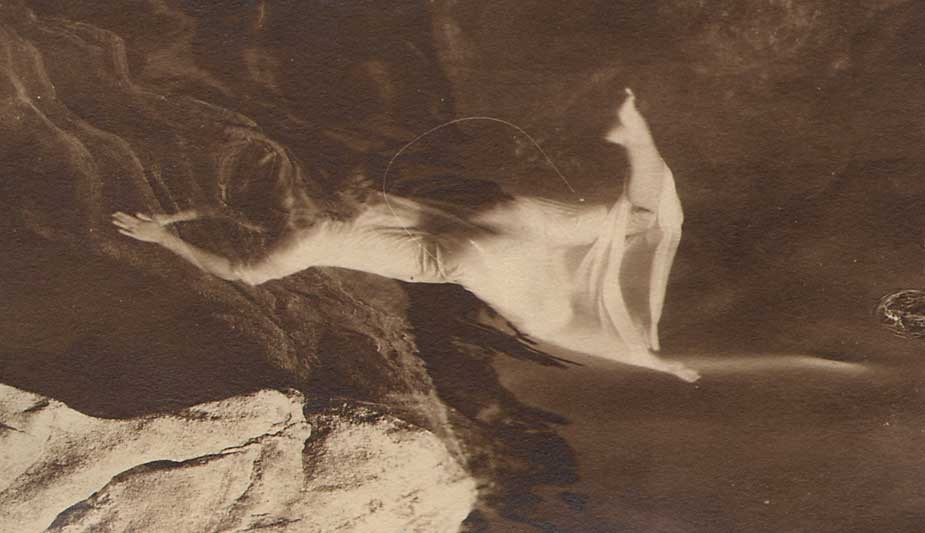 Detail: Gelatin silver or Bromide print: "Mermaid Swimming" ("Ki-lo-des-ka") ca. 1914 or before: by Charlotte Vetter Gulick: image: 8.7 x 11.2 cm: mount: 16.5 x 22.9 cm: reproduced as opening photo for article "The Mermaid" A SERIES OF PHOTOGRAPHS BY MRS. LUTHER HALSEY GULICK: in Everybody’s Magazine: New York: August, 1914: p. 225: note: hair at center of frame result of negligence from contact-printing from original negative. from: PhotoSeed Archive
Detail: Gelatin silver or Bromide print: "Mermaid Swimming" ("Ki-lo-des-ka") ca. 1914 or before: by Charlotte Vetter Gulick: image: 8.7 x 11.2 cm: mount: 16.5 x 22.9 cm: reproduced as opening photo for article "The Mermaid" A SERIES OF PHOTOGRAPHS BY MRS. LUTHER HALSEY GULICK: in Everybody’s Magazine: New York: August, 1914: p. 225: note: hair at center of frame result of negligence from contact-printing from original negative. from: PhotoSeed Archive
The photographs are a suggestive interpretation of the first law of the Camp-Fire, “Seek beauty;” a revelation of the poetic side of one of the simple, wholesome, normal acts of life. This is the principle, full of possibilities yet undeveloped, upon which the Camp-Fire ceremonial and symbolism are based.
The first ideal of the Camp-Fire girl is the development of a well proportioned physique; a body under perfect control and responsive to every call of the spirit within. Her other ideals include an all-around training in the art of home-keeping in the modern sense, which involves a knowledge of community conditions as well as of the simple processes of home activity. This points to the further ideal of patriotism in the sense of loyalty to country, to church, to humanity, and of service in its broadest meaning.
But to hold forth these aims and say “These are the Camp-Fire” would be as inadequate as to inscribe beneath these rarely beautiful photographs the legend, “A Girl Swimming,” and consider the story told. The Camp-Fire girl makes an art of living. She finds in the mystic glow of the Camp-Fire the joy that burns at the heart of simple things, and life for her is never without beauty and romance.
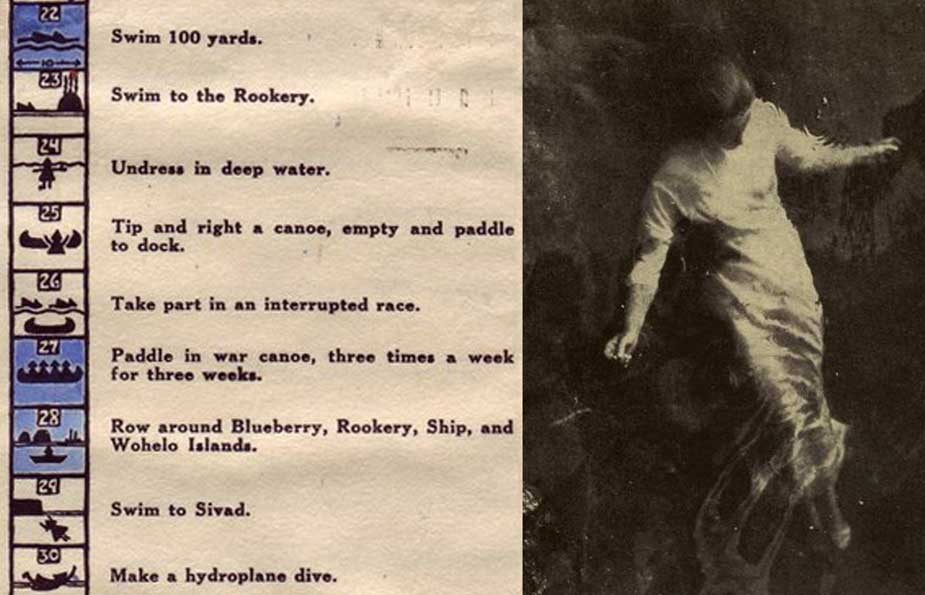 Left: example of Camp Wohelo water-related challenge symbol badges from 1920 Wohelo camp yearbook: courtesy: Gulick Family. Right: detail: full-page halftone: "Ki-lo-des-ka swimming under water" : from 1915 volume by Ethel Rogers: "Sebago-Wohelo Camp Fire Girls"
Left: example of Camp Wohelo water-related challenge symbol badges from 1920 Wohelo camp yearbook: courtesy: Gulick Family. Right: detail: full-page halftone: "Ki-lo-des-ka swimming under water" : from 1915 volume by Ethel Rogers: "Sebago-Wohelo Camp Fire Girls"
A girl swimming can not always be a creature of mystic beauty, any more than speech can always be lyric or motion be always grace. But when once the beauty in a simple act has been revealed, even in a single poetic moment, a reflected glory is thrown over the commoner moments of which this is but the type. This is the poetry that the Camp-Fire girls all over America are writing into life. (3.)
Camp Fire Girls, Basket Ball and More
Born Emma L. Vetter on Dec. 12, 1865 in Oberlin, Ohio to missionary parents, (4.) Charlotte “Lottie” Gulick was educated in Kansas public schools and undertook her secondary education at Washburn College (now Washburn University) in Topeka, Kansas doing college preparatory work. She then matriculated and earned a bachelor of arts degree from Drury College in Springfield, MO. (5.) It was at Drury that she met Luther Halsey Gulick , (1865-1918) whom she married in 1887.
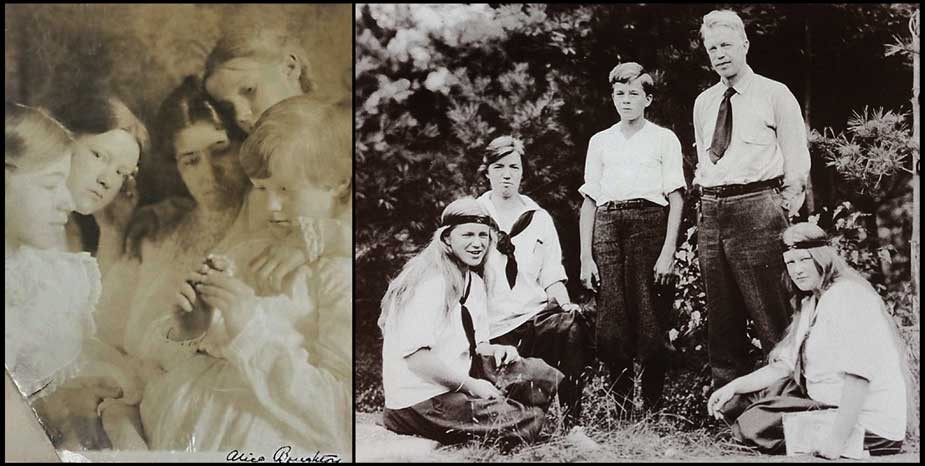 Left: photographer Charlotte Vetter Gulick is at center surrounded by her four daughters. Photograph by Alice Boughton ca. 1900. Katharine (Ki-lo-des-ka) is believed to be at right holding a flower. Reproduced later as an engraving in a New York Times article profiling the new Campfire Girls of America organization: "Girls take up the Boy Scout Idea and Band Together" (March 17, 1912) (private collection) Right: detail: members of the Gulick family from a photograph most likely taken by Charlotte Gulick around 1911. From left to right: Katharine "Kitty" Gulick (Curtis) (1895-1968); Frances "Franta" Gulick(1891-1936); Halsey Gulick; Dr. Luther Halsey Gulick (Timanous-1865-1918); Louise Gulick. (1888-1941): courtesy: Gulick Family
Left: photographer Charlotte Vetter Gulick is at center surrounded by her four daughters. Photograph by Alice Boughton ca. 1900. Katharine (Ki-lo-des-ka) is believed to be at right holding a flower. Reproduced later as an engraving in a New York Times article profiling the new Campfire Girls of America organization: "Girls take up the Boy Scout Idea and Band Together" (March 17, 1912) (private collection) Right: detail: members of the Gulick family from a photograph most likely taken by Charlotte Gulick around 1911. From left to right: Katharine "Kitty" Gulick (Curtis) (1895-1968); Frances "Franta" Gulick(1891-1936); Halsey Gulick; Dr. Luther Halsey Gulick (Timanous-1865-1918); Louise Gulick. (1888-1941): courtesy: Gulick Family
A strong advocate in the promotion of physical eduction as well as an organizer and author in his professional life, Dr. Luther Halsey Gulick also came from a missionary family, his father being missionary physician Luther Halsey Gulick Sr. (1828–1891) Receiving his medical degree from New York University in 1889, Dr. Gulick is perhaps best remembered today for his role in the development of the game of basketball, although this is but an interesting side story of a remarkable life. In 1891, while superintendent of the physical education department at the International YMCA Training School in Springfield, MA., (now Springfield College) he became the catalyst and inspiration for colleague James Naismith to first draw up rules for the new game of “Basket Ball”, with a peach basket nailed above the inside of a gymnasium playing court serving as the goal. His beliefs, as embodied in a poster issued after his death, were in the
”unity of body, mind and spirit, and in an education which includes all three. He devoted his life to establishing this ideal, by emphasizing the social and ethical values of physical exercise, especially through play and recreation.”
While at the YMCA, he was also responsible for designing the triangular logo which represented the YMCA philosophy of Mind, Body and Spirit. (6.)
Summer camp was an activity the Gulicks thrived on and made a lifestyle out of. Beginning in 1887, a year before their first child Louise was born, they established a camp on the shores of the Thames River in Gales Ferry CT. Co-educational, with the couples friends as well as extended Gulick family members acting as counselors to their own children and others, (7.) it operated for 20 years. In order to share what was learned to a larger audience of girls, the couple then established Camp Wohelo on Sebago Lake in 1907. An acronym comprised of the three virtues of work, health, and love, Wohelo was embodied from the start as outlined in 1915 by Charlotte Vetter Gulick:
I believe deeply and earnestly that spiritual health and development is a direct corollary of bodily vigor and control; that the joy that comes from the exercise of efficient muscles has its counterpart in the soul; that to exercise the one is to exercise the other.
Upon that rock has Wohelo been built, and its use of symbols is, perhaps, more than anything else, a working and ever-present declaration of the spiritual values inherent in all the humblest phases of our everyday life in the world. (8.)
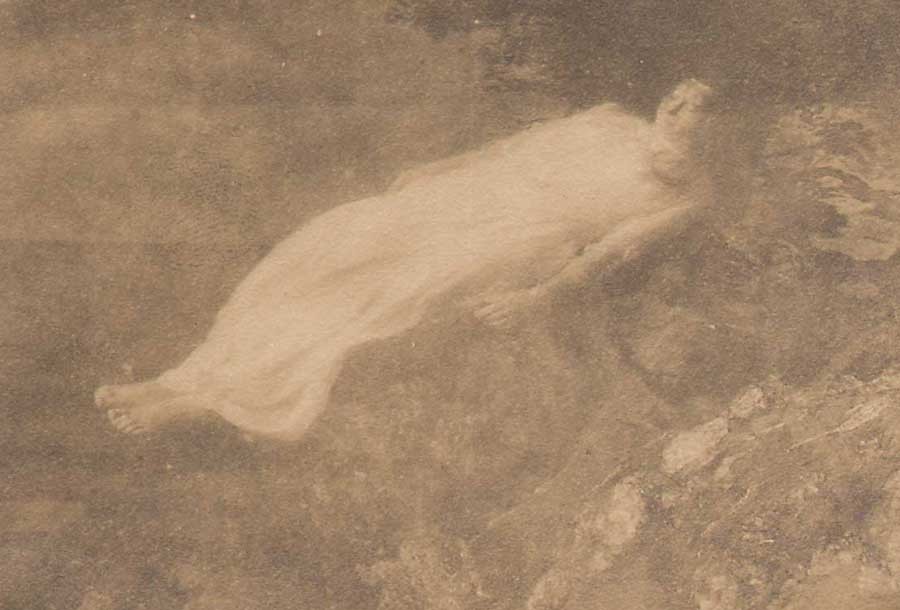 Detail: "Mermaid Study : Submerged": Gelatin silver print: ca. 1914 or before: by Charlotte Vetter Gulick: image: 8.4 x 10.8 cm: mount: 16.7 x 22.7 cm. : reproduced as final photo for article "The Mermaid" A SERIES OF PHOTOGRAPHS BY MRS. LUTHER HALSEY GULICK: in Everybody’s Magazine: New York: August, 1914: p. 232: from: PhotoSeed Archive
Detail: "Mermaid Study : Submerged": Gelatin silver print: ca. 1914 or before: by Charlotte Vetter Gulick: image: 8.4 x 10.8 cm: mount: 16.7 x 22.7 cm. : reproduced as final photo for article "The Mermaid" A SERIES OF PHOTOGRAPHS BY MRS. LUTHER HALSEY GULICK: in Everybody’s Magazine: New York: August, 1914: p. 232: from: PhotoSeed Archive
Five years before this philosophy was written, in 1910, Charlotte Gulick, known by her symbolic Indian name at the Wohelo camp as Hiiteni, which translated to “Life, more life”, came up with the idea for the Camp Fire Girls movement. An organization for girls much as the Boy Scouts of America was structured for boys, and coincidentally founded the same year, Camp Fire Girls promoted all the values she and her husband had already been teaching at their earlier camp at Gales Ferry and at Wohelo:
”The idea originated in the mind of Mrs. Gulick, and was at once indorsed by Dr. Gulick, who believes it to be logical and necessary to proper development of girls amid the changing conditions of our National life.” (9.)
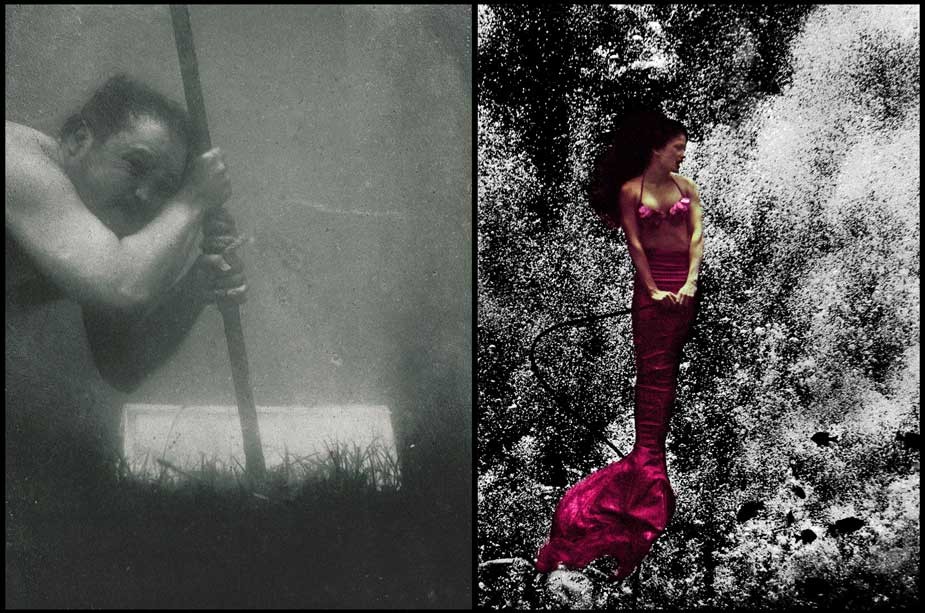 Left: detail: photo by "David": title: "Portrait Instantané D'un Plongeur" ("Instant Portrait of a Diver") : photogravure plate XI by Paul Dujardin showing French underwater photography pioneer Louis Marie-Auguste Boutan (1859-1934) holding himself steady underwater: from: 1900 volume "La Photographie Sous-Marine et Les Progres de La Photographie" (The Progress of Underwater Photography) (between pp. 210-211) : Gallica: National Library of France online resource. Right: a modern-day mermaid: Nicole Marino plays the starring role in "The Little Mermaid" at Florida's Weeki Wachee Springs Waterpark. In 1947, former Navy frogman Newton Perry conceived of the idea of using an air hose and perfected "hose breathing" here. Culturally, mermaids are a tourist attraction, and have entered the popular imagination through films like "The Incredible Mr. Limpet" starring Don Knotts. (1964): 1999 photo by David Spencer/The Palm Beach Post
Left: detail: photo by "David": title: "Portrait Instantané D'un Plongeur" ("Instant Portrait of a Diver") : photogravure plate XI by Paul Dujardin showing French underwater photography pioneer Louis Marie-Auguste Boutan (1859-1934) holding himself steady underwater: from: 1900 volume "La Photographie Sous-Marine et Les Progres de La Photographie" (The Progress of Underwater Photography) (between pp. 210-211) : Gallica: National Library of France online resource. Right: a modern-day mermaid: Nicole Marino plays the starring role in "The Little Mermaid" at Florida's Weeki Wachee Springs Waterpark. In 1947, former Navy frogman Newton Perry conceived of the idea of using an air hose and perfected "hose breathing" here. Culturally, mermaids are a tourist attraction, and have entered the popular imagination through films like "The Incredible Mr. Limpet" starring Don Knotts. (1964): 1999 photo by David Spencer/The Palm Beach Post
Today, the history of the Gulick’s shared virtues of work, health and love continue on in the summer operation of their Maine camps. In a promotional 1919 silent film on Wohelo released a year before women in the United States had the Constitutional protection of the right to vote, these changing conditions of America’s National life for young women were on display. Seated in teams of coordinated paddlers in three large over-sized canoes on Lake Sebago, the ideals of resourcefulness in working together shown in the film remains an ideal for young women still valued today.
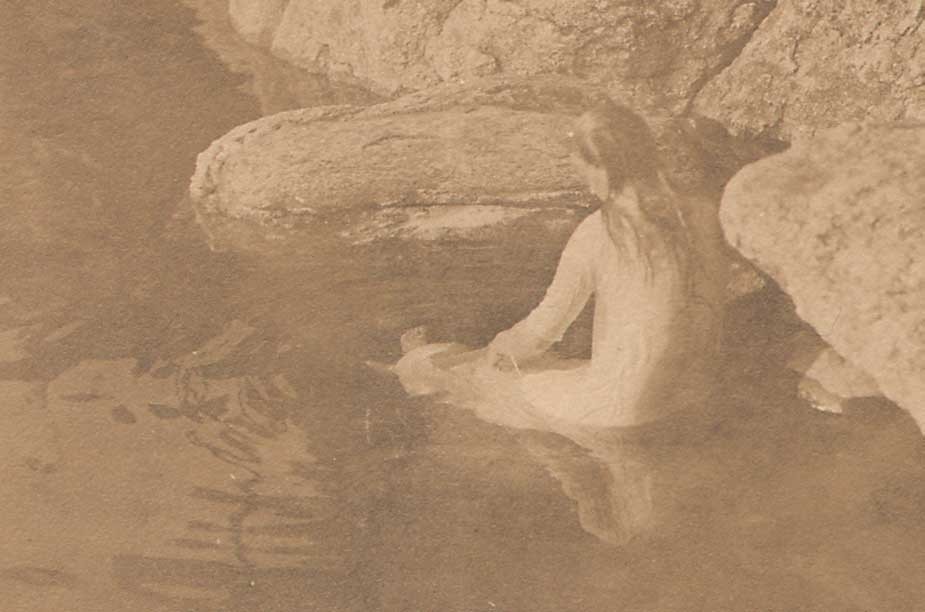 Detail: "Mermaid Sunbathing " ("Kitty" Gulick) : Gelatin silver print: ca. 1914 or before: by Charlotte Vetter Gulick: image: 7.3 x 10.8 cm: mount: 17.0 x 22.5 cm. : In this photo, a figure study of Katharine "Kitty" Gulick by her mother, "Ki-lo-des-ka" sunbathes next to granite boulders on the Sebago Lake shoreline in Maine.: from: PhotoSeed Archive
Detail: "Mermaid Sunbathing " ("Kitty" Gulick) : Gelatin silver print: ca. 1914 or before: by Charlotte Vetter Gulick: image: 7.3 x 10.8 cm: mount: 17.0 x 22.5 cm. : In this photo, a figure study of Katharine "Kitty" Gulick by her mother, "Ki-lo-des-ka" sunbathes next to granite boulders on the Sebago Lake shoreline in Maine.: from: PhotoSeed Archive
Much like these photos of Ki-lo-des-ka the mermaid, “her yellow hair glinting golden in the sunshine” (10.) reveal beauty to us in the physical form, lines from a poem by Ralph Waldo Emerson cited by the amateur photographer Charlotte Gulick after she mastered the art of water diving at the age of 35 brings forth a desire in the human spirit to symbolically enter the depths as well:
”To vision profounder
Man’s spirit must dive.“ (11.)
Notes:
1. Louis Marie-Auguste Boutan. (1859-1934) Boutan used specially-designed underwater camera housings, publishing his research conducted from 1892-1900 for a large audience in the 1900 volume “La Photographie Sous-Marine et Les Progres de La Photographie”. (The Progress of Underwater Photography)
2. from: The Mermaid: in: Everybody’s Magazine: New York: The Ridgway Company Publishers: August, 1914: p. 225
3. Ibid: pp. 225-232
4. 1870 U.S. Census. Gulick changed her name to Charlotte sometime after 1900 but was known as “Lottie”
5. Gulick background: Margaret R. and Dennis S. O’Leary: Adventures at Wohelo Camp - Summer of 1928: 2011: iUniverse: p. 24
6. 1921 poster of Luther Halsey Gulick: Makers of American Ideals poster issued by the National Child Welfare Association: Springfield College Digital online resource accessed Oct., 2014
7. background: Camp Timanous website accessed Oct., 2014. Owned by the Suitor family since the 1930’s, the camp was originally founded by Luther Halsey Gulick in 1917, whose symbolic Indian name Timanous- was “Guiding Spirit”. In the introduction to the 1915 Sebago-Wohelo Camp Fire Girls volume, Charlotte Gulick states as many as 75 people camped together at Gales Ferry before Wohelo was established.
8. excerpt: Introduction: Mrs. Luther Halsey Gulick: Ethel Rogers: Sebago-Wohelo Camp Fire Girls: Battle Creek, MI: Good Health Publishing Company: 1915: pp. 22-23
9. excerpt: Girls Take up the Boy Scout Idea and Band Together: Edward Marshall: in: The New York Times: March 17, 1912
10. Sebago-Wohelo Camp Fire Girls: p. 94
11. Ibid: p. 22
✻ : and of course I’m happy to be corrected
Oh Say Can you See?
Posted July 2014 in History of Photography, Scientific Photography, Significant Photographs
Walt Whitman certainly did. Just check out his eyeballs on this photograph taken in 1887 by George C. Cox for confirmation. Especially on this most personal of American holidays, the Fourth of July, the continuing birthday idea of our messy, evolving experiment of a democratic republic called the United States can never be said to be boring.
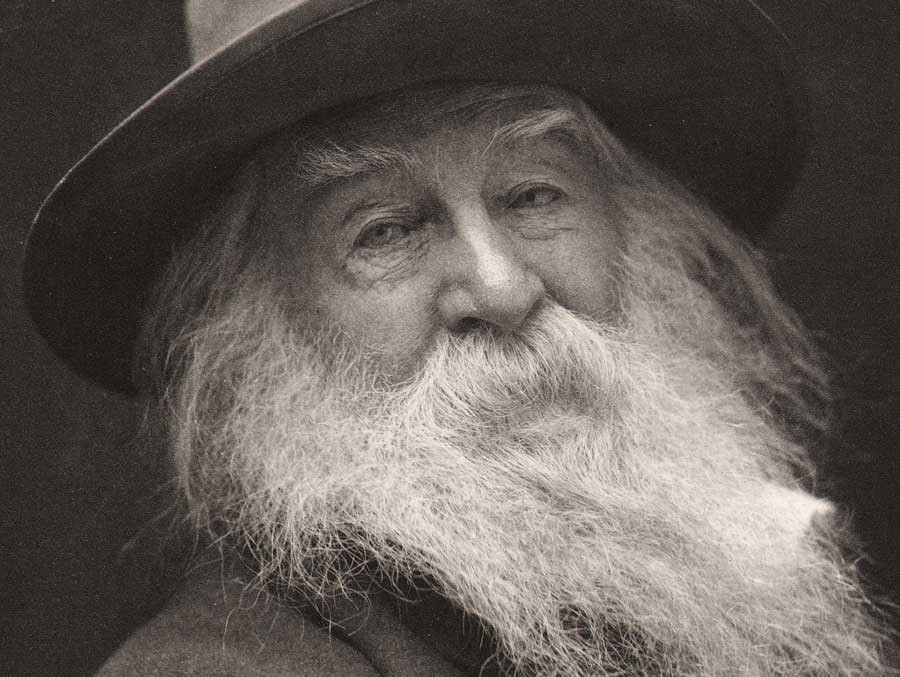 Detail: 1887: Walt Whitman-1819-1892 by George C. Cox: (portrait known as the "Laughing Philosopher") 23.9 x 18.8 cm | 45.2 x 33.3 cm: vintage large format, hand-pulled photogravure printed circa 1905-10 by the Photographische Gesellschaft in Berlin on Van Gelder Zonen plate paper. From: PhotoSeed Archive
Detail: 1887: Walt Whitman-1819-1892 by George C. Cox: (portrait known as the "Laughing Philosopher") 23.9 x 18.8 cm | 45.2 x 33.3 cm: vintage large format, hand-pulled photogravure printed circa 1905-10 by the Photographische Gesellschaft in Berlin on Van Gelder Zonen plate paper. From: PhotoSeed Archive
Need proof of his vision? - Whitman’s metaphorical call in this famous quote: “What is that you express in your eyes?” ; and response: “It seems to me more than all the print I have read in my life.”
You could say America’s poet (1819-1892) of the everyman didn’t need a camera, he was one. His genius of observation, something all great photographers possess, gave him the power to indelibly express his convictions. So when words flowed from his pen, they possessed the power of photographs, especially on the very idea of America in the aftermath of the Civil War:
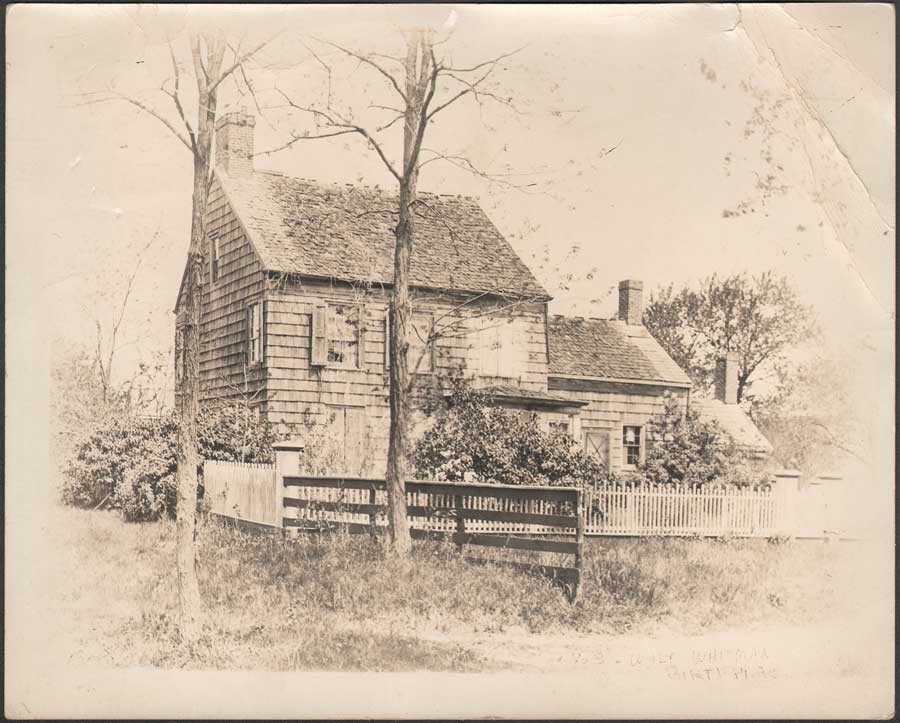 "Walt Whitman Birthplace in 1903" (South Huntington, New York): by Ben Conklin: 1903: vintage albumen print: 20.3 x 25.2 cm from: PhotoSeed Archive: (Benjamin Sargent Conklin: 1873-1964)
"Walt Whitman Birthplace in 1903" (South Huntington, New York): by Ben Conklin: 1903: vintage albumen print: 20.3 x 25.2 cm from: PhotoSeed Archive: (Benjamin Sargent Conklin: 1873-1964)
from Leaves of Grass: intro to “Thoughts”:
Of these years I sing,
How they pass and have pass’d through convuls’d pains, as
through parturitions,
How America illustrates birth, muscular youth, the promise, the
sure fulfilment, the absolute success, despite of people-
illustrates evil as well as good,
The vehement struggle so fierce for unity in one’s-self;
How many hold despairingly yet to the models departed, caste,
myths obedience, compulsion, and to infidelity, … (1.)
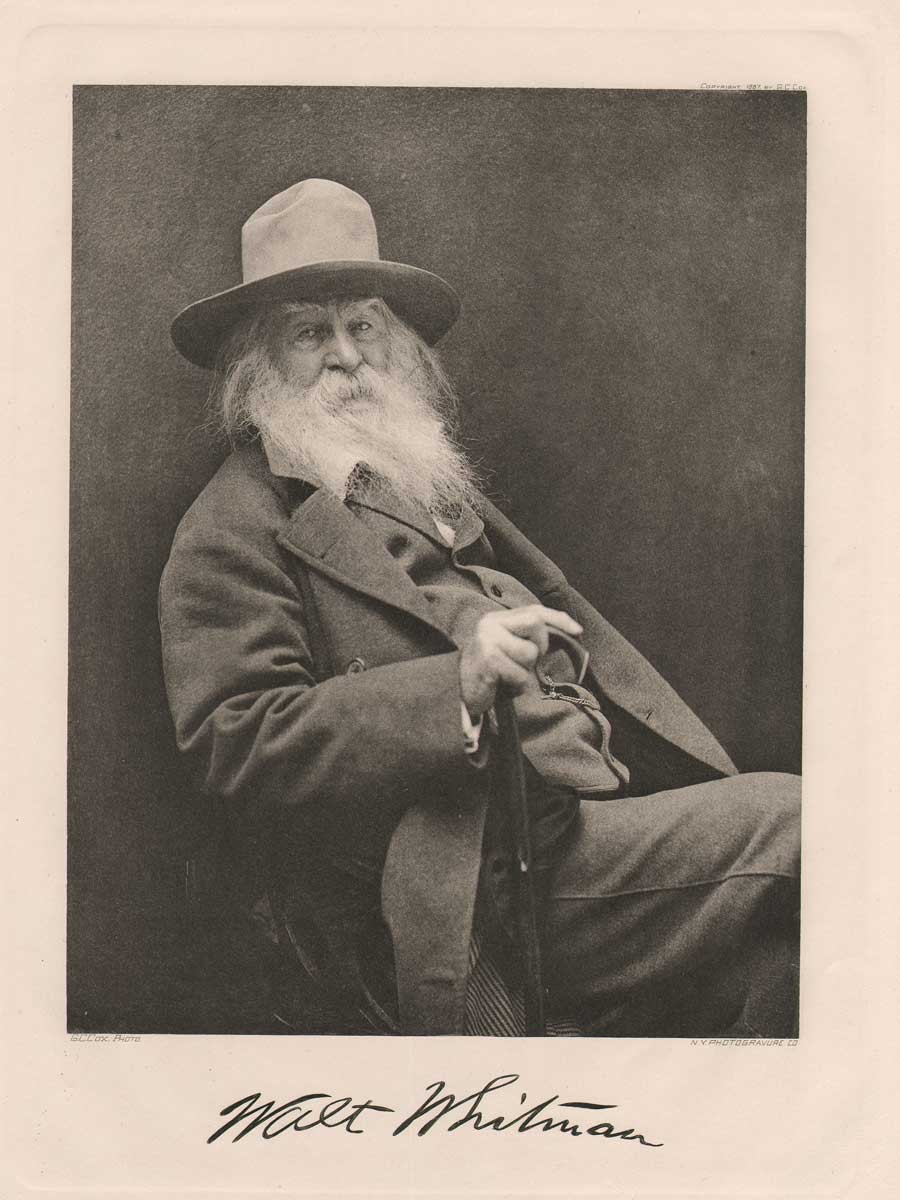 "Walt Whitman" by George C. Cox: 1887. Hand-pulled photogravure published in periodical "Sun & Shade" New York: March, 1892: whole #43: N.Y. Photogravure Co.: 21.5 x 16.7 cm | 34.7 x 27.4 cm: from: PhotoSeed Archive
"Walt Whitman" by George C. Cox: 1887. Hand-pulled photogravure published in periodical "Sun & Shade" New York: March, 1892: whole #43: N.Y. Photogravure Co.: 21.5 x 16.7 cm | 34.7 x 27.4 cm: from: PhotoSeed Archive
But enough of the history lesson. Since most of us will never rise to the level of a Whitman in prose, photography as an art form is a comparably easy stretch. Speaking for myself as a young newspaper photographer in the mid 1980’s hunched over a light table editing film, an early mentor told me as long as a person’s eyes in the negative were tack sharp through the loupe, it was a “keeper”, and worthy of publication.
And so it was for my colleagues a century before my own light table revelation, but with the slow, fragile dry plates in use at the time a much greater technical challenge. In 1887, New York portrait photographer George Collins Cox (1851-1902) had the sitting of a lifetime in none other than Whitman. Strolling into his New York studio with oversized fedora, it was 22 years to the day no less on April 15th when American president Abraham Lincoln finally succumbed to an assassin’s bullet in 1865.
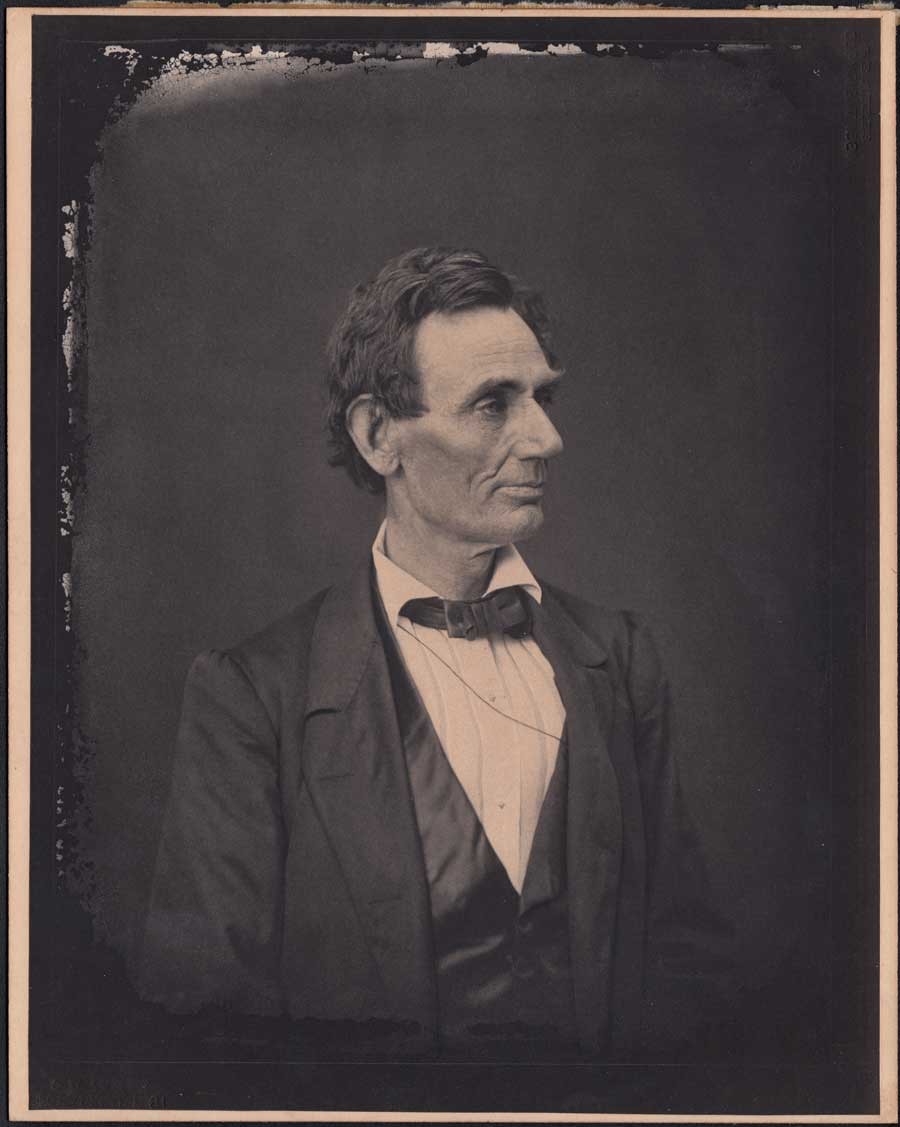 Abraham Lincoln by Alexander Hesler (1823-July 4th, 1895):taken in Springfield, Illinois on June 3, 1860: vintage platinum print © 1881 by George Bucher Ayres: print from late 1890's: Meserve #26|Ostendorf #26" One of the most famous Walt Whitman poems, "O Captain! My Captain!", eulogizing the death of this American president, was written by Whitman in 1865: from: PhotoSeed Archive
Abraham Lincoln by Alexander Hesler (1823-July 4th, 1895):taken in Springfield, Illinois on June 3, 1860: vintage platinum print © 1881 by George Bucher Ayres: print from late 1890's: Meserve #26|Ostendorf #26" One of the most famous Walt Whitman poems, "O Captain! My Captain!", eulogizing the death of this American president, was written by Whitman in 1865: from: PhotoSeed Archive
And he nailed it, as they say in America. Eyes tack sharp. The following historical account of the Whitman portrait sitting from the Charles E. Feinberg Collection at the Library of Congress gives a nice working account of Cox the photographer in action. A result of that session: the “Laughing Philosopher”, was the title Whitman declared as his favorite:
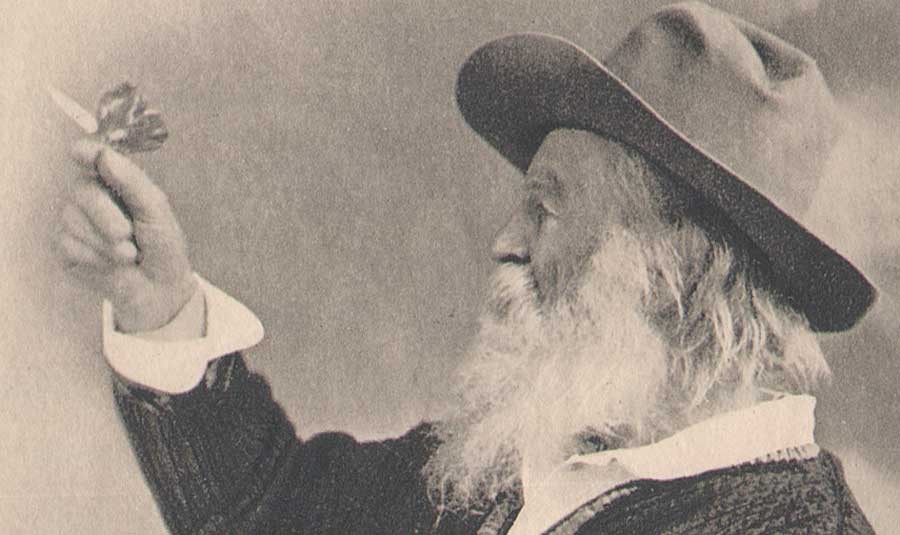 Detail: "Walt Whitman and the Butterfly" :1877(?):by W. Curtis Taylor of Broadbent & Taylor (Philadelphia): vintage hand-pulled vellum photogravure: 13.8 x 9.8 cm | 22.6 x 15.0 cm: from: Leaves of Grass II: The Complete Writings of Walt Whitman: New York:1902: Henry W. Knight:National Edition limited to 500 copies:"In fact, the "butterfly" was clearly a photographic prop now in the collections of the Library of Congress. The die-cut cardboard butterfly is imprinted with the lyrics to a John Mason Neale hymn and the word "Easter" in large capital letters."… What is not often noted is that the photo simply enacts one of the recurrent visual emblems in the 1860 edition of Leaves: a hand with a butterfly perched on a finger. …"The butterfly … represents, of course, Psyche, his soul, his fixed contemplation of which accords with his declaration: 'I need no assurances; I am a man who is preoccupied of his own soul.'"- The Walt Whitman Archive online resource- from: PhotoSeed Archive
Detail: "Walt Whitman and the Butterfly" :1877(?):by W. Curtis Taylor of Broadbent & Taylor (Philadelphia): vintage hand-pulled vellum photogravure: 13.8 x 9.8 cm | 22.6 x 15.0 cm: from: Leaves of Grass II: The Complete Writings of Walt Whitman: New York:1902: Henry W. Knight:National Edition limited to 500 copies:"In fact, the "butterfly" was clearly a photographic prop now in the collections of the Library of Congress. The die-cut cardboard butterfly is imprinted with the lyrics to a John Mason Neale hymn and the word "Easter" in large capital letters."… What is not often noted is that the photo simply enacts one of the recurrent visual emblems in the 1860 edition of Leaves: a hand with a butterfly perched on a finger. …"The butterfly … represents, of course, Psyche, his soul, his fixed contemplation of which accords with his declaration: 'I need no assurances; I am a man who is preoccupied of his own soul.'"- The Walt Whitman Archive online resource- from: PhotoSeed Archive
”On the morning of April 15th, 1887, George Cox took several photographs of Whitman, who was celebrating the success of his New York lecture on Lincoln, delivered the day before. Whitman recalls that “six or seven” photos were made during the session, but Whitman’s friend Jeannette Gilder, an observer of the session, said there were many more than that: ‘He must have had twenty pictures taken, yet he never posed for a moment. He simply sat in the big revolving chair and swung himself to the right or to the left, as Mr. Cox directed, or took his hat off or put it on again, his expression and attitude remaining so natural that no one would have supposed he was sitting for a photograph.“ (2.)
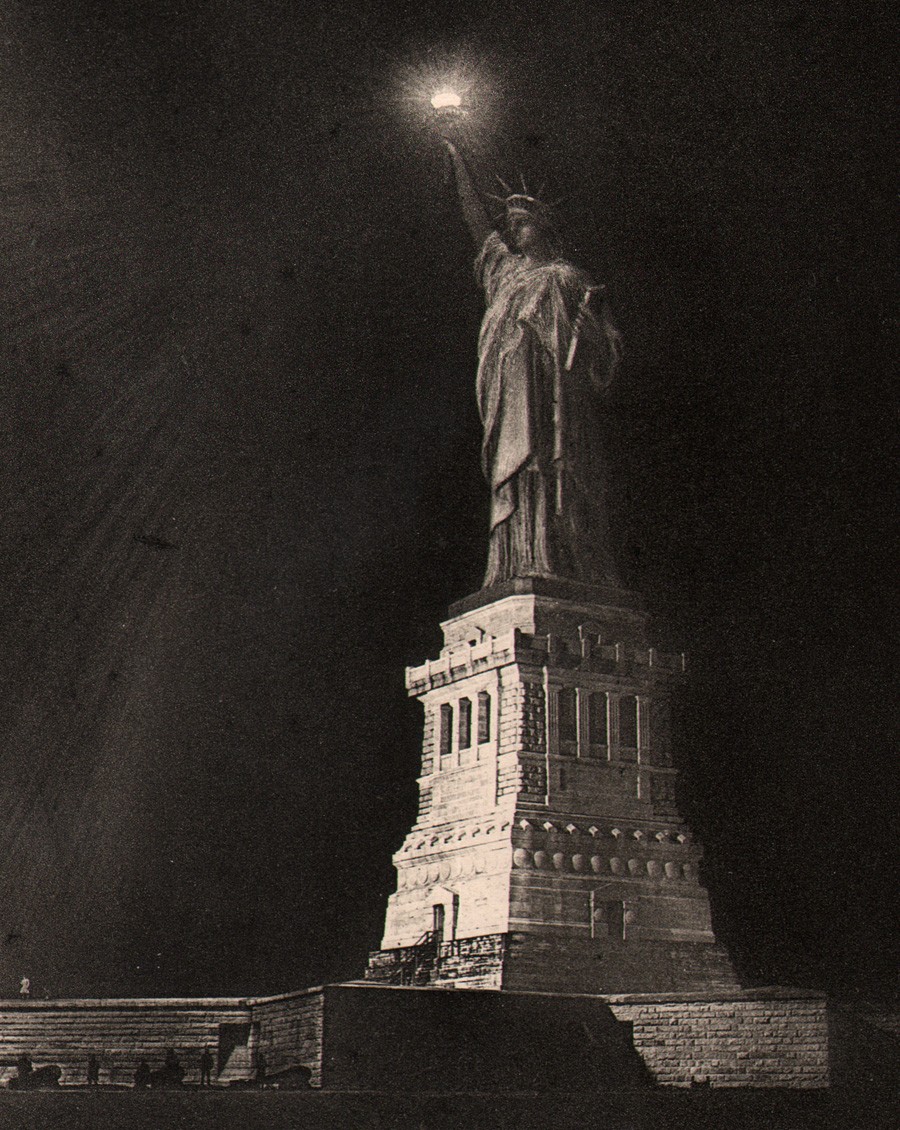 Detail: "Statue of Liberty at Night": Seneca Ray Stoddard: Hand-pulled photogravure published in periodical "Sun & Shade" New York: September, 1890: whole #25: N.Y. Photogravure Co.: 18.5 x 12.0 cm 35.2 cm x 27.6 cm: For many, the dream of America still holds true in the light, or darkness, of Lady Liberty's torch-even when viewed against the backdrop of the messy, evolving experiment of a democratic republic called the United States- one fully embraced in the writings of Walt Whitman. A technical description of this photograph copyrighted in 1889 by Stoddard: "Mr. Stoddard employed five cameras on this occasion, stationing them on the Steamboat Pier. A wire was stretched from the torch of the Statue to the mast of a vessel a considerable distance away. Placed on this wire, controlled by a pulley, was a cup containing one and one-half pounds of flash powder; an electric wire was connected with it, and at a given signal the current turned on, by the electrician in charge of the torch, the flash exploded and the exposure made." from: PhotoSeed Archive
Detail: "Statue of Liberty at Night": Seneca Ray Stoddard: Hand-pulled photogravure published in periodical "Sun & Shade" New York: September, 1890: whole #25: N.Y. Photogravure Co.: 18.5 x 12.0 cm 35.2 cm x 27.6 cm: For many, the dream of America still holds true in the light, or darkness, of Lady Liberty's torch-even when viewed against the backdrop of the messy, evolving experiment of a democratic republic called the United States- one fully embraced in the writings of Walt Whitman. A technical description of this photograph copyrighted in 1889 by Stoddard: "Mr. Stoddard employed five cameras on this occasion, stationing them on the Steamboat Pier. A wire was stretched from the torch of the Statue to the mast of a vessel a considerable distance away. Placed on this wire, controlled by a pulley, was a cup containing one and one-half pounds of flash powder; an electric wire was connected with it, and at a given signal the current turned on, by the electrician in charge of the torch, the flash exploded and the exposure made." from: PhotoSeed Archive
1. from “Thoughts” Leaves of Grass II: The Complete Writings of Walt Whitman: New York:1902: Henry W. Knight, publisher: National (limited) Edition: p. 275
2. excerpt: Walt Whitman Archive online resource accessed July, 2014
Heels of Progress
Posted May 2012 in History of Photography, Scientific Photography
If you ever wanted to learn about the importance assigned or excitement surrounding the discovery of the X-Ray, look no further than any photographic journal published the world over between 1896-1897. Chronicled in breathless detail within their many pages, this new and miraculous revelation was aided by photography’s very ability to record the see-through results of these “mysterious rays” on a myriad of materials.
 "Foot in a Shoe": full-page halftone plate identified as figure 6 accompanying article "Radiography and its Application" published in "The Photographic Times": July: 1896. Believed to be photographed by author Arthur Willis Goodspeed with the assistance of G. C. McKee.
"Foot in a Shoe": full-page halftone plate identified as figure 6 accompanying article "Radiography and its Application" published in "The Photographic Times": July: 1896. Believed to be photographed by author Arthur Willis Goodspeed with the assistance of G. C. McKee.
And so this new victory was shouted far and wide: the symbolic Iron Heel of Progress, represented by the dual disciplines of scientific investigation and photography coming together, marched forward. In my own convoluted way of thinking, the splendid specimen of shoe including said iron-studded heel protecting a foot within makes perfect sense, literally and perhaps symbolically making a full-page debut along with other objects in the July, 1896 issue of The Photographic Times.
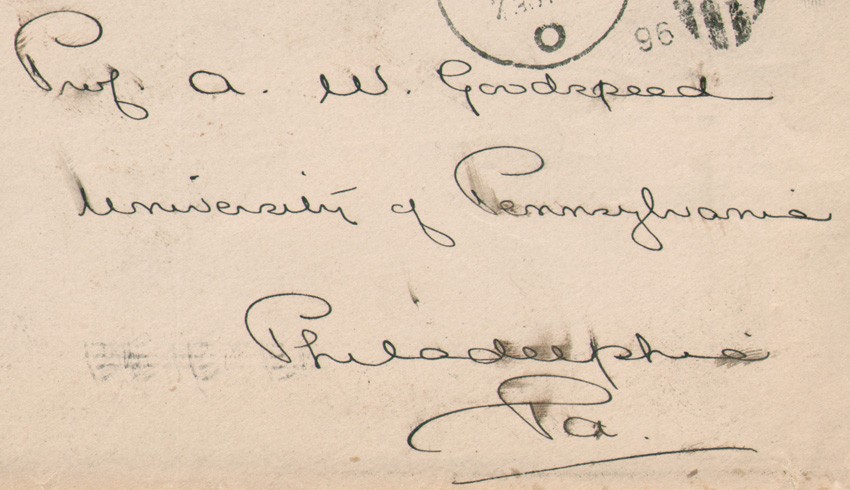 University of Pennsylvania physics professor and Radiology pioneer Arthur Willis Goodspeed was the addressee of this personal letter sent by Photographic Times editor Walter E. Woodbury in 1896 seeking the procurement of X-Ray photographs to accompany Goodspeed's published July issue article: "Radiography and its Application". Detail from original envelope with dimensions of 9.3 x 16.5 cm
University of Pennsylvania physics professor and Radiology pioneer Arthur Willis Goodspeed was the addressee of this personal letter sent by Photographic Times editor Walter E. Woodbury in 1896 seeking the procurement of X-Ray photographs to accompany Goodspeed's published July issue article: "Radiography and its Application". Detail from original envelope with dimensions of 9.3 x 16.5 cm
The reason for all this excitement was the official announcement late the year before: German physicist Wilhelm Röntgen (1845-1923) had “produced and detected electromagnetic radiation in a wavelength range today known as X-rays or Röntgen rays”. (1.) For his efforts, Röntgen in 1901 was awarded the first Nobel Prize in Physics.
I will be the first to admit scientific photography is not a collecting focus for the PhotoSeed archive, however, the possession of a postal cover and several pages from a hand-written letter by Photographic Times editor Walter E. Woodbury (1865-1905) posted to this site was reason enough to visually explore X-Ray photography in this space as the profound discovery it remains even today. On May 22nd, while working in advance of the July issue, Woodbury penned a short missive to America’s equivalent of Röntgen: University of Pennsylvania physics professor Arthur Willis Goodspeed. (1860-1943) Radiography and its Application was the name of the article he had already written, dated April 30th and eventually published. But at the time, working more than a month in advance, editor Woodbury was willing to hold up publication of his journal until he could secure the necessary photographs showing the dry-plate, x-ray-effected negatives he knew would cause a stir, and thus providing proof for and generating interest in Goodspeed’s article.
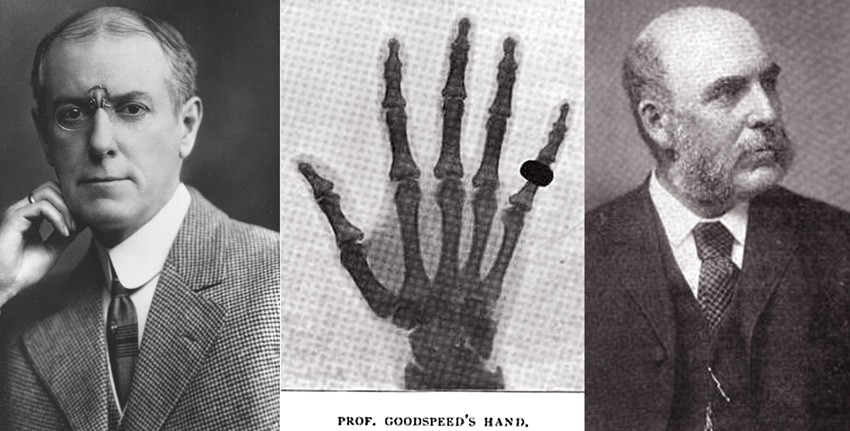 Left: Arthur Willis Goodspeed (1860-1943) circa 1903-04 when he was 4th President of the American Roentgen Ray Society. Middle: An X-Ray photographic negative from 1896 showing Goodspeed's hand taken by Philadelphia photographer John Carbutt. Right: Englishman John Carbutt, (1832-1905) inventor of specialized glass dry plates sensitive to the newly identified x-rays that were provided to Goodspeed for research purposes.
Left: Arthur Willis Goodspeed (1860-1943) circa 1903-04 when he was 4th President of the American Roentgen Ray Society. Middle: An X-Ray photographic negative from 1896 showing Goodspeed's hand taken by Philadelphia photographer John Carbutt. Right: Englishman John Carbutt, (1832-1905) inventor of specialized glass dry plates sensitive to the newly identified x-rays that were provided to Goodspeed for research purposes.
Goodspeed was no stranger to photographic experimentation. In the mid 1880’s he had witnessed and assisted the English photographer Eadweard Muybridge (1830-1904) while he conducted the now famous Animal Locomotion studies under the support of the University of Pennsylvania and more unbelievably, had made by accident along with British photographer William Jennings, the first known X-Ray photograph in the physical lecture room at the school on February 22, 1890 . A centennial remembrance written by TL Walden Jr. for the journal Radiology in 1991 partly states:
On that evening, Goodspeed and Jennings had been making brush electrographs of coins and brass weights. After they finished their experiments, Jennings stacked all of the photographic plates; two coins—either left from the experiments or Jennings’ trolley fare—were placed on top of the plates. Goodspeed then demonstrated to Jennings the university’s collection of Crookes tubes, with the idea of photographing the glow from the tube. While the two men were talking, however, the Crookes tube was emitting x radiation that affected the nearby plates. After the plates were developed, Jennings noted that one had the shadow(s) of a disk(s) on it; neither man could explain the image. (2.)
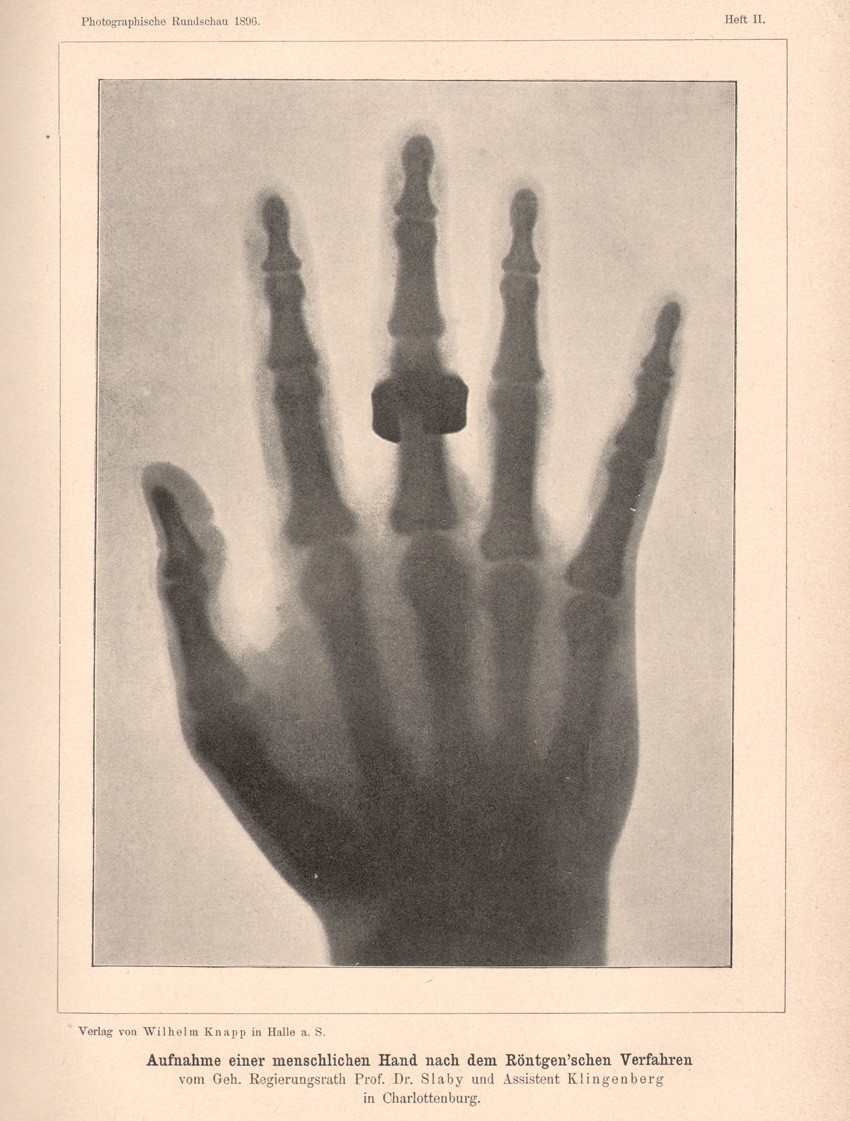 One of the most popular subjects it seems for early depictions of X-Ray negative photographs was the human hand. This full-page halftone presentation of a full hand with ring was included in the February, 1896 issue of the German photographic journal Photographische Rundschau. Original caption: Aufnahme einer menschlichen Hand nach dem Röntgen'schen Verfahren vom Geh. Regierungsrath Prof. Dr. Slaby und Assistent Klingenberg in Charlottenburg.
One of the most popular subjects it seems for early depictions of X-Ray negative photographs was the human hand. This full-page halftone presentation of a full hand with ring was included in the February, 1896 issue of the German photographic journal Photographische Rundschau. Original caption: Aufnahme einer menschlichen Hand nach dem Röntgen'schen Verfahren vom Geh. Regierungsrath Prof. Dr. Slaby und Assistent Klingenberg in Charlottenburg.
The photographic holdup for Woodbury was worth it. Englishman John Carbutt, (1832-1905) who had first made a name for himself in America by taking stereoscopic landscape photographs as well as running a Chicago portrait studio in the 1860’s, had become an important collaborator in the late 1890’s with Goodspeed in Philadelphia. Carbutt’s invention of specialized glass dry plates sensitive to the newly identified x-rays were provided to Goodspeed for research purposes; the same year his article appeared in The Photographic Times. Carbutt’s role as well as the importance of these plates was acknowledged in it:
With a view to developing the sensitive plate to produce the best results possible, Mr. John Carbutt has given untiring attention and made many experiments. The Carbutt plates have most of them been tested by the writer in comparison with other makes, and those now in use give by far the best results of any yet tried. The negatives from which the illustrations accompanying this article have been reproduced are samples of the plates referred to. (3.)
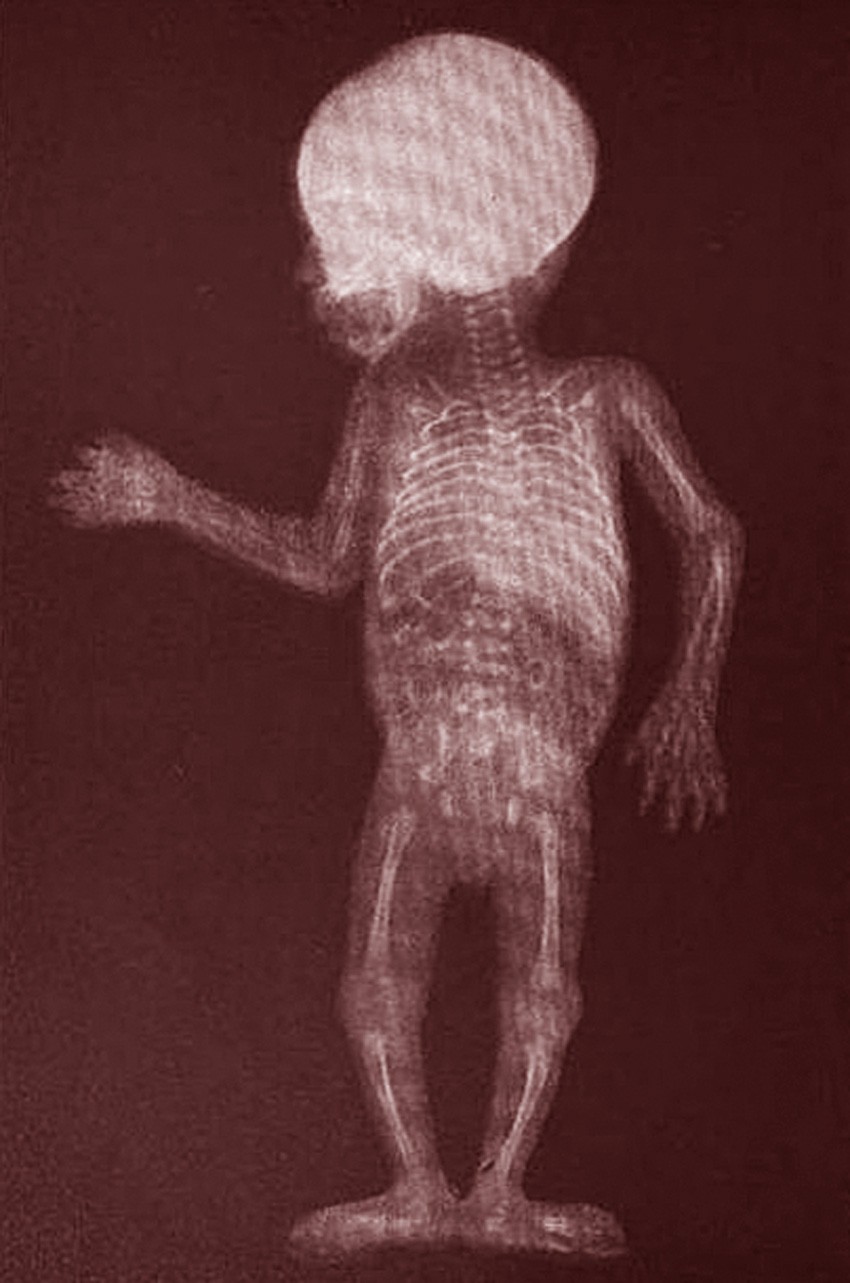 Unknown health hazards did not seem to present issues with photographers keen to exploit the miracle that was X-Ray photography when first discovered in late 1895. Although it is not known what the exposure time for this 3 day old child was when Philadelphia photographer John Carbutt recorded it in 1896, exposures of over 1 hour in length are commonly mentioned. This photograph appeared as a full-page halftone in the December, 1896 issue of "The American Amateur Photographer".
Unknown health hazards did not seem to present issues with photographers keen to exploit the miracle that was X-Ray photography when first discovered in late 1895. Although it is not known what the exposure time for this 3 day old child was when Philadelphia photographer John Carbutt recorded it in 1896, exposures of over 1 hour in length are commonly mentioned. This photograph appeared as a full-page halftone in the December, 1896 issue of "The American Amateur Photographer".
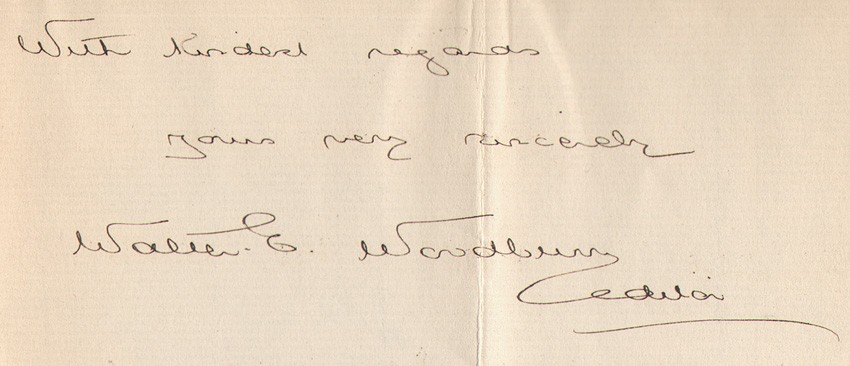 "Photographic Times" editor Walter Edward Woodbury (1865-1905) was the son of Walter B. Woodbury, who invented the Woodburytype. Woodbury edited the journal from 1895-1899. He died from yellow fever while later editing the English section of the "Panama Star and Herald and Inter-Ocean Critic" newspaper in Panama.
"Photographic Times" editor Walter Edward Woodbury (1865-1905) was the son of Walter B. Woodbury, who invented the Woodburytype. Woodbury edited the journal from 1895-1899. He died from yellow fever while later editing the English section of the "Panama Star and Herald and Inter-Ocean Critic" newspaper in Panama.
In closing, and with a nod to collectors like myself seeking out the ultimate published examples of Röntgen, or X-Ray scientific photographs, I suggest a further investigation of the 15 oversized, hand-pulled photogravure plates published in 1896 under the direction of Austrian photo-chemists Josef Maria Eder and Eduard Valenta. Containing magnificent studies of human bones, various small animals as well as man-made objects including a set of lockets, this portfolio, titled Versuche über Photographie mittelst der Röntgen’schen Strahlen, features as its’ final plate the now iconic coiled snake titled Aesculap-Schlange. First taken by Eder and Valenta and presented to members of the Viennese Photographic Society in January of 1896, (4.) these photographs have long ago entered the canon of modern photographic art, a scant two months after Röntgen’s initial discovery shook the world.
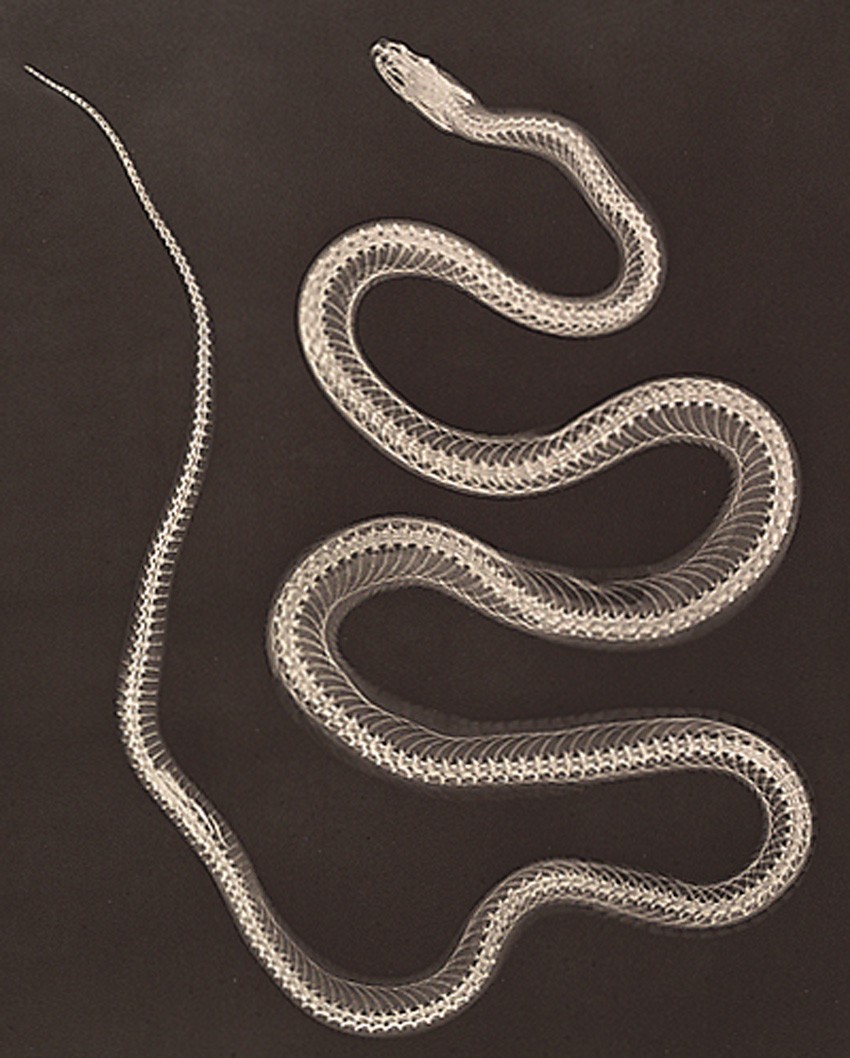 Detail: Aesculap-Schlange (Facsimile des Negativs). pl. XV: from portfolio: "Versuche über Photographie mittelst der Röntgen'schen Strahlen" published in 1896 as a large plate photogravure. Symbolic of healing and native to Europe, the Aesculapian snake is associated with the Greek god Asclepius and Roman god Aesculapius. The symbol of modern human medicine is often represented by this snake intertwined around a rod.
Detail: Aesculap-Schlange (Facsimile des Negativs). pl. XV: from portfolio: "Versuche über Photographie mittelst der Röntgen'schen Strahlen" published in 1896 as a large plate photogravure. Symbolic of healing and native to Europe, the Aesculapian snake is associated with the Greek god Asclepius and Roman god Aesculapius. The symbol of modern human medicine is often represented by this snake intertwined around a rod.
1. Wilhelm Röntgen: from: Wikipedia: accessed: 2012
2. excerpt: The first radiation accident in America: a centennial account of the x-ray photograph made in 1890: TL Walden Jr.:in: Radiology: December, 1991: pp. 635-639
3. excerpt: Radiography and its Application: A.W. Goodspeed: in: The Photographic Times: New York: July, 1896: pp. 308-309
4. from: Beauty of Another Order-Photography in Science: Ann Thomas: Yale University Press: New Haven and London, in association with the National Gallery of Canada, Ottawa; 1997